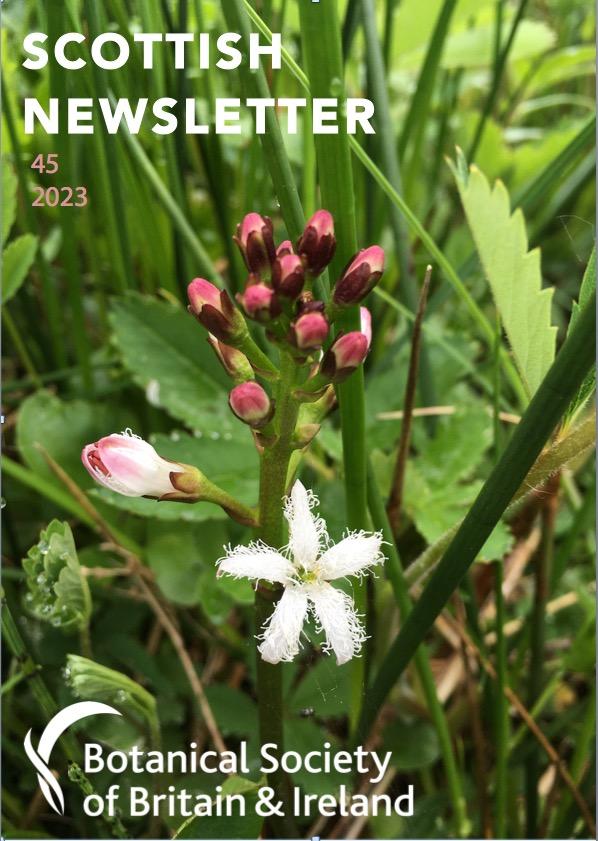
* Altitudinal recording bias of Scottish plant records Andy Amphlett
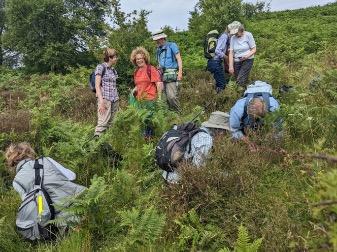

* My 2022 recording project Angus Hannah





* An ancient woodland in Hoy, Orkney
John Crossley
Welcome to an experimental issue! The Contents list above is for the complete online version. The print version only includes those items picked out in colour. This is because a poll of members appeared to show that a majority were not in favour of paying a small sum to receive the complete issue in full colour. If you would like to express your opinion on any aspect of this, next year's editor, John Crossley flawsjohn@gmail.com will be pleased to hear from you. Faith Anstey faithanstey@gmail.com
1 Scottish & Scotland Officers 6 Scottish Botanists Conference 2022 * talks, AGM minutes, exhibits 16 Atlas 2020 16 Scotland Officer's Report 2022 19 VCR Reports 2022 50 Features
The Botanical Renaissance Louise Ross
News from Ben Lawers
*
*
Helen Cole
61 Puzzle Pages 65 Local Botany Groups 77 Obituary 78 Photo Gallery 82 Basic Botany * Keys unlocked * Beginning to botanise in Scotland 86 What do botanists do all day? Back Cover Field Meetings Programme 2023
Cover image: Bogbean Menyanthestrifoliata – the county flower of Renfrewshire, photographed there by James Blackwood
SCOTTISH & SCOTLAND OFFICERS



Eighteen years a BSBI Scottish Officer
It has been a great pleasure working with members and partners as the BSBI’s first Country Officer, appointed on 1 November 2004. It was very strange and exciting – a brand-new post, the only employee in Scotland and no line-manager! BSBI members Michael Braithwaite, David Pearman, Gordon Rothero and Richard Pankhurst, along with Chris Sydes and Ro Scott from Scottish Natural Heritage (now NatureScot) all contributed great support and advice via a Steering Group. Office space was provided by RBGE which gave me access to the library, herbarium, meeting rooms and the canteen. Crucially it also provided colleagues – so I wasn’t working totally alone. The post was funded by Scottish Natural Heritage (SNH) with a matching contribution from a private anonymous donor. From the outset SNH were very keen that the BSBI helped deliver their vascular plant Site Condition Monitoring (SCM) programme. Our key volunteers – the Vice-County Recorders (VCRs) with their detailed knowledge of the sites and species – were well placed to help. So, we gathered and trained a team of BSBI volunteers who would go on to deliver over one third of SNH’s entire SCM programme over the first 18 years of that initiative. SNH got high-quality SCM reports, BSBI volunteers were able to make valuable contribution to conservation and the BSBI itself got high-quality and detailed rare plant data - and continuing financial support. Thanks are due to everyone who contributed to the project’s success.
Then, as now, the job was all about supporting BSBI members in Scotland – particularly the VCRs. One area where help was needed was the digitisation of records. At the time, VCRs were only just getting to grips with MapMate and many had big backlogs of paper records. So I developed the Scottish Computerisation Project in 2005 to help computerise these paper records, making them available electronically to the recorders themselves via MapMate, and centrally in what later became the BSBI Database. Public money being used to pay for the work, the records had to be made publicly available via the NBN Gateway. Over a six-year period, we successfully bid for a total of £110,000 from SNH and the Esmée-Fairbairn Foundation to pay the contractors. In-kind match funding was provided by the recorders who painstakingly checked the records. Just over one million paper records from 16 Scottish Vice-counties were digitised, including records that underlay the Changing Flora of Glasgow (2000) and the Flora of Edinburgh and the Lothians (2002). The funding was also used to provide MapMate support. We contracted Martin Harvey to travel throughout Scotland offering MapMate support visits to BSBI VCRs. He also developed a MapMate support website, using short YouTube training videos; Martin Rand developed a comprehensive MapMate Handbook. Both of these are still available for use today. Many thanks are due to all the contractors, recorders and funders who collaborated to make this such a successful project.
1
This work laid a great foundation for the Threatened Plant and Atlas 2020 projects to follow. Both were a huge challenge in Scotland due to the large tracts of remote, mountainous terrain and the general lack of botanists. So I developed Recording Weeks, where a big group of botanists would stay in a different remote self-catering lodge for a week each year and participants would go out in twos or threes and survey different squares each day. Aiming to make the week as much fun as possible, we ‘hired’ a volunteer cook which meant we could come home to tea and cake in the afternoons and big family-style dinners in the evenings. Training was another key aim: we arranged a mix of more and less experienced botanists in each group, changing the groupings every day. We spent the evenings identifying specimens. No amount of money could buy such a brilliant week’s training! There has now been a total of 14 Recording Weeks – a great highlight for me, and I’d like to thank everyone who helped to make them such a success.
I would like to think I’ve contributed to making the society more open, friendly and accessible, for example by producing Scottish Officer annual reports (see BSBI Scotland) and, more recently, calling on all VCRs to produce their own annual reports. I set up periodic Scottish members’ electronic newsletters which eventually morphed into the two regular enewsletters the BSBI now publishes. And fun things like organising a Christmas Dinner in Edinburgh and a dinner on the eve of the Scottish annual meeting. A lot of effort was put into making the Scottish annual meeting more inviting and welcoming From 2016 we added training workshops which proved very popular and made a pleasant change from talking heads! In 2018 it was renamed the Scottish Botanists’ Conference and transformed into a major partnership conference with BSS and RBGE that welcomes everyone, members or not. Attendance has gone from strength to strength, from about 110 in the early noughties to about 175 now – largely thanks to the team of volunteers who help organise the event so brilliantly. Another area where Scotland has led the way is our outreach work that aims to encourage beginner botanists through an annual programme of user-friendly plant ID workshops. Generally, three or four workshops are held annually, for complete beginners, or Grass and Sedge beginners (with a discount for members). I cannot recommend these practical workshops enough; again, thanks are due to the Outreach group which has done such an excellent job.
Jim at Corrour © Ian Bonner
Finally, one of the most exciting changes I’ve seen in Scotland is the change in VCRs’ attitudes towards open data. All Scottish Recorders are now content to have full details of their records published publicly on NBN Scotland for all but a handful of the most sensitive species and sites. We are convinced that the far greater risk to rare plant populations is when people don’t know where they are and they are inadvertently damaged or destroyed. We are looking forward to

2
members having access to full details of Scottish records in the BSBI Database. This will surely encourage even more member interest and recording in Scotland.
It feels like a good time to go. Never has the Society been in such fine fettle. There was a very impressive next generation of young botanists at every field meeting I attended last year. The Scottish Botanists’ Conference was vibrant. Our membership is at record highs: in Scotland it surpassed 400 for the first time ever last February, and now, a year later, it is 462. However, I am not going far. I’m of course continuing as Mid-Perthshire Recorder. I’ve also just been awarded Research Associate status by RBGE. So, if you are visiting Edinburgh or Perthshire, please get in touch! My personal email is jim-mcintosh@tiscali.co.uk
Jim McIntosh
Jim McIntosh – an appreciation
On 2December 2022, Jim McIntosh retired from the BSBI after 18 years as Scottish Officer, and latterly also as Senior Country Officer. At the Scottish Botanists Conference in November our President Lynne Farrell led the tributes to him in a presentation which can be viewed via the BSBI website. Here we will try to outline some of the many things he achieved during those 18 years.
Jim’s first career was as a transmission engineer for the BBC, but his love of the natural world and especially the Scottish mountains led him to retrain, then on to working for the NTS at Ben Lawers and SNH in Argyll & Stirling. It was on a botanical trip to Rum that he learnt of BSBI’s plans for a Scottish Officer. The post arose from discussions between David Pearman (BSBI) and Chris Sydes (SNH). Both were concerned that the BSBI VC recorder network in Scotland was in desperate need of direction, modernisation and motivation.
Jim was recruited to the post in 2004 and quickly integrated himself into the Scottish botanical community, thanks to his enthusiastic but tactful and patient personality. Botanists are a very diverse group of people, but Jim has managed to mould the Scottish Vice-county Recorders (VCRs) and other active members into a network broadly working to similar standards and goals.
His engineering background gave him crucial IT skills and he devoted himself to encouraging us into the digital age. Jim has spent many hours patiently supporting recorders (some reluctant, if not recalcitrant!) with data and software. He helped us with GPS, Memory Map and especially Mapmate which was a major tool in the Atlas 2020 project. His spring workshops for Scottish recorders were a particular highlight, though how he kept calm whilst trying to help a diverse roomful of botanists and their laptops is a mystery.
Jim worked closely with the BSBI Committee for Scotland, which we both chaired at different times. He helped in many ways, for example working alongside the committee
3
and its Outreach group, together with VCRs and other volunteers, on the development of a programme of education and training events to complement traditional field meetings. Although a very experienced field botanist himself, he championed the view that ‘we are all learners’, dismissing the fear for the less-experienced of appearing ‘foolish’ in the field.
Over the years he played a key role in the success of so many projects in Scotland, such as the Threatened Plants project, data mobilisation, Site Condition Monitoring and of course Atlas 2020. With VCRs he helped develop a series of annual recording weeks, particularly for the Atlas, in under-recorded areas from Wigtownshire to Shetland. These were very enjoyable events as well as generating numerous records for the Atlas and other projects. Latterly he helped organise ‘Rough Crew’ meetings to record in difficult places, especially his beloved mountains.
Some of the rough Crew at Corrour

Jim believes in making botany fun, interesting and appealing to all ages, and his approach has helped to involve many different people in botanical activity in Scotland. With BSS and RBGE he developed the Scottish Annual Meeting into the hugely popular and vibrant event it is today, the Scottish Botanists’ Conference, with many younger people attending.
Networking was another of his talents, developing and cementing relationships with partners including RBGE, BSS, SNH/NatureScot, Plantlife and NTS. He did much to raise the profile of BSBI in Scotland and increase our credibility, which also helped to build the membership, bring in records and make greater use of our resources. He had a very dedicated approach to capturing historic plant records from many sources, and enthusing funders to support that work, with the aim of records being used for plant conservation.
The current healthy state of BSBI in Scotland is in no small part down to Jim’s commitment, dedication and dogged hard work over the last 18 years. As Lynne stated in her tribute, he made the role of Scottish Officer quite indispensable, and we are delighted that his successor Matt Harding is now in post as ‘Scotland Officer’. However, Jim will continue to be very much involved with botany in Scotland, as VCR for MidPerthshire but also now as Research Associate at the Royal Botanic Garden Edinburgh, for which he deserves our congratulations. Thank you Jim!
Ian Strachan & Robin Payne
4
New Scotland Officer Matt Harding
I am delighted to be joining BSBI as the new Scotland Officer following Jim’s retirement, and am so grateful for the warm welcome extended by the Scottish botanical community. I am originally from Lancashire, but as a child spent summers in the west and north-west of Scotland –one of my earliest botanical memories is lying in a bog somewhere near Achiltibuie looking at sundews with my mum – and I have always loved walking and climbing in the Scottish mountains.
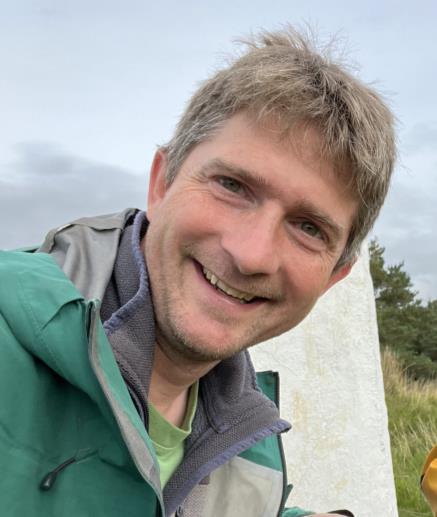
I moved to Stirlingshire in 2011 to begin work as an ecologist for a renewable energy consultancy, and after a few years set up independently, carrying out various surveys all over Scotland. One January spent peat-probing on Yell in Shetland sticks in the mind, as dark and cold (!) but also a brilliant experience with great people, working on a worthwhile habitat restoration project. Another memorable job involved NVC surveying the Isle of Ulva for a community project – an amazing way to get to know a unique place, marred only slightly by the voracious ticks.
After several years as a BSBI member, I became joint vice-county recorder for Stirlingshire with Phil Sansum in 2018 and worked with him on the final stages of Atlas 2020 fieldwork. I was blown away by how much botanical exploration there remains to be done, even in such a relatively accessible vice-county – one of the joys of being a botanist in Scotland! As BSBI Scotland Officer, I am looking forward to supporting and engaging with other people who are as passionate about the natural world as I am, joining with them to expand our knowledge of Scottish botany, and helping to train the next generation of botanists. See a longer interview with Matt at bsbipublicity.blogspot.com
Committee for Scotland – new Chair
The retiring chair of the Committee for Scotland (CfS), Lindsay Mackinlay, has made enormously worthwhile contributions to botany over the years. Succeeding him as chair is David Elston, who is currently joint vice-county recorder for both Kincardineshire and North Aberdeenshire.
Before his retirement, David worked as a statistician / mathematician in agri-environment research, finishing up as Director of Biomathematics and Statistics Scotland (BioSS), a Scottish Environment, Food and Agriculture Research Institution. He credits Jackie Muscott and David Welch with being his mentors in botanical study and recording, after his initial interest was sparked as an undergraduate. He is still Scottish Field Meetings Secretary for the present, but hopes to pass it on to someone else very soon, to allow him time to give his best efforts to chairing the committee.
5
SCOTTISH BOTANISTS CONFERENCE 2022


At the Scottish Botanists Conference on 5 November at RBGE, the following talks were enthusiastically received.
Rainforests and Peatlands: Travels around Scotland's most threatened habitats - Clifton Bain, Advisor to the IUCN UK Peatland Programme
What can you do with a completely sequenced flora? - Alex Twyford, University of Edinburgh
Vascular Epiphytes in Easter Ross - Brian Ballinger, BSBI & BSS
Update from Botanical Society of Scotland - Jill Thompson, BSS President
The Scottish Officer year - Jim McIntosh, BSBI Scottish Officer
Plantlife Scotland update and plans - Alistair Whyte, Head of Plantlife Scotland
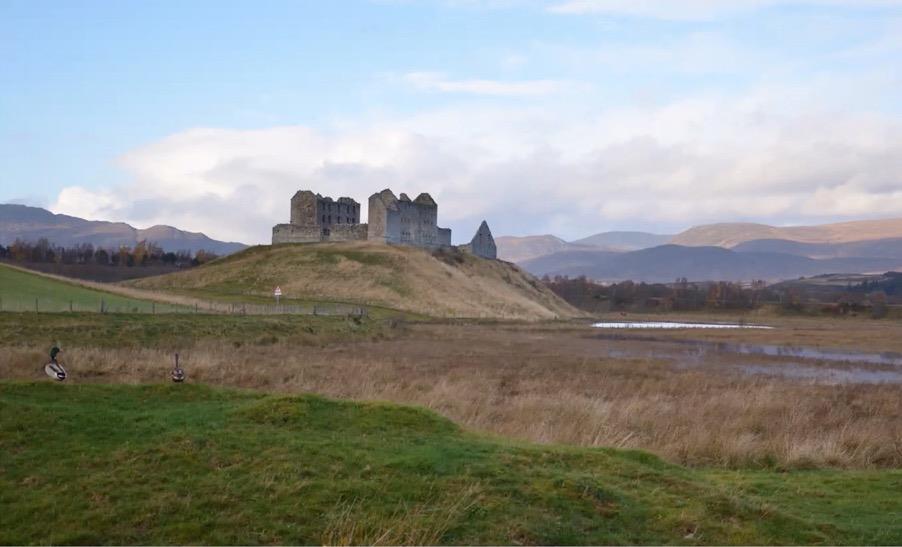
From The Bird's Mouth / Bho
Bheul an Eòin - Derek Roberston
Plant Conservation at Mar Lodge National Nature
Reserve - Shaila Rao, Conservation Manager, NTS Mar Lodge

6
Presentation to mark Jim McIntosh's retirement - by Lynne Farrell, BSBI President
There were also tours of the RBGE Herbarium & Library and six mini-workshops:
▪ An introduction to ferns for beginners by Heather McHaffie
▪ An introduction to grasses for beginners by Jay Mackinnon
▪ Cypresses by Matt Parratt - Lateral key to cypresses handout
▪ 'Sitka spruce and other invasive conifers: what next?' Discussion led by Lindsay Mackinlay
▪ Spike-rushes by Jeremy Roberts
▪ Spikey-rosette aquatics by Nick Stewart
BSBI Scottish AGM Minutes
Saturday 5 November 2022 at Scottish Botanists’ Conference, RBGE
1. Welcome The Chair, Lindsay Mackinlay, welcomed everyone back to this live meeting.
2. Minutes of the BSBI Scottish AGM 2021 Minutes of the BSBI Scottish AGM 2021 were displayed on screen and – no matters arising – were proposed by Dave Batty, seconded by Gordon Rothero and approved by a unanimous show of hands by those present.
3. Committee for Scotland 2022-23
BSBI Committee for Scotland 2021-22
Lindsay Mackinlay (Chair) – Retiring Vacant – (Vice-chair)
Liz Lavery (Secretary) – Retiring David Elston (Field Meetings Secretary)
John Crossley Matt Parratt – Retiring
Andrew Rowley Michael Philip
Sarah Watts Polly Spencer-Vellacott
Louise Ross Caspian Richards (co-opted in 2021)
Representatives: BSBI staff: Jim McIntosh (BSBI Scottish Officer) (Retiring – to be replaced by Matt Harding)
NatureScot – Iain MacDonald / Sarah Smyth, Plantlife Scotland – Alistair Whyte
NTS – Dan Watson, BSS – Brian Ballinger, Outreach Committee – Faith Anstey
The following committee members were re-elected by a unanimous show of hands: David Elston (Chair). Proposed by Lindsay Mackinlay, seconded by Liz Lavery
Polly Spencer-Vellacott (Secretary). Proposed by Liz Lavery, seconded by David Elston.
Lindsay Mackinlay. Proposed by David Elston, seconded by Jim McIntosh.
The following nominations were elected by unanimous shows of hands:
Caspian Richards (co-opted in 21-22) – Proposed Lindsay Mackinlay, seconded by Liz Lavery Amelia Hodnett – Proposed by Matt Harding, seconded by Theo Loizou
4 . Chair’s report 2022: The Year We were allowed out to play again!
• We got back to having field meetings and workshops again - 15 in total across Scotland.
7
• No Annual Summer Meeting in Borders but hopefully it will be in the future.
• CfS now has an Operational Plan to help inform our work in Scotland – an aspirational plan.
To DDb or not to DDb – that is the question:
When asked, Scottish VC recorders and the CfS unanimously declared their desire for full resolution of records to be made available via the DDb, with exceptions for a few sensitive species. So this will be the case for records in Scottish Vice Counties and Lindsay thanked VC recorders for their support.
Consultations Galore:
CfS decided it had to get involved with some key consultations from Scottish Government this year, so sent detailed comments on the following:
● Scottish Biodiversity Strategy
● National Planning Policy Framework 4 and will comment soon on
● Building a Plant Biodiversity Strategy for Scotland.
Outreach Activity – Some highlights! The Outreach Group has been active for 10 years: the Chair wished it a happy 10th anniversary.
Tutors are sought for 5 workshops in 2023 (across Scotland), so please contact Faith Anstey or Matt if you can help. Also, help is sought for field training meetings.
Retiral of the Scottish Officer
Jim McIntosh, who has been Scottish Officer for 18 years, will retire in December. The Chair thanked him for all his work, wished him well in retirement, and hoped he would continue to be involved through his activities as Vice County Recorder for Mid-Perthshire.
5. Scottish Vice-county Recorders
In memory:
Mark Tulley, a member of the VC 90 (Angus) team of recorders, passed away during the year. The Chair recognised the valuable contribution he had made and sent condolences to his family.
Welcome to: The following people were thanked for taking on these important positions as VCRs:
• Flora Donald, new VCR for Vc94 Banffshire
• Mary Dean, new co–VCR for Vc106 Easter Ross, with Brian Ballinger

• Joanna Walmisley, joint VCR for Vc 104 North Ebudes, with Stephen Bungard
• Sue Jury, proposed as new VCR for Vc83 Midlothian
• Simon Smart taking over whole Vc102 South Ebudes (with Malcolm Ogilvie planning to retire but still supporting)
8
• Sarah Cowan, co-VCR with Angus Hannah Vc100 Clyde Islands
Current Vacancies Despite this success in recruitment, some vacancies remained:
• Midlothian Vc83 – co-recorder to assist Sue Jury with data entry
• Argyllshire Vc98 joint with Gordon Rothero
• Kintyre Vc101 Dave & Pat Batty planning to step down (but holding fort for the moment)
Anybody interested should contact Matt Harding, new Scotland Officer after 1st Dec.
6. Scottish Newsletter BSBI Scottish Newsletter No.44 was published on paper and online in April 2022. Angus Hannah, the BSBI Scottish Newsletter editor has now stood down and was thanked enormously for his work over many years. Faith Anstey is going to edit the next newsletter, with John Crossley taking over afterwards. There will be some discussions about the future format of the Scottish Newsletter, whether printed or online. Lindsay asked for an indication amongst those present of who would prefer printed copies; at least 50% of those present indicated that they preferred printed copies. Please send Faith contributions for next spring’s issue.
• Plans for 2023
In 2023 we look forward to –
• New Scotland Officer Matt Harding
• Return of lots more field meetings and training [subject to Covid’s plans] and Rough Crew.
• a possible award, as BSBI has been shortlisted for a Citizen Science Award (for Atlas 2020) at this year’s Nature of Scotland Awards presentation 17th November. We are planning outreach, general & recording meetings, and to study specialist groups of plants. David Elston, Scottish Field Meetings Secretary, requested more offers for field meetings.
Lynne Farrell mentioned that Alistair Godfrey has not been well, and asked for the meeting’s permission to convey the best wishes of the Committee when she writes to wish Alistair well. This was unanimously supported by the meeting.
Dot Dahl requested that the minutes of the previous AGM be sent out in advance of the AGM; they were published in the Scottish Newsletter but not distributed again in advance of this meeting.
Dot Dahl also raised the need for ID skills in younger botanists and asked if some kind of apprenticeship scheme would be possible. Faith Anstey mentioned Identiplant; Julia Hanmer confirmed that the BSBI is taking over Idenitplant and will be employing a training coordinator to support it and FISC. Some sort of apprenticeship scheme might be considered in the future. Jim McIntosh mentioned the excellent activities organised by the Outreach Committee in Scotland.
9
8. Date of next AGM will be during the Scottish Botanists’ Conference November 2023.
9. Any other business
Lindsay thanked fellow CfS members and Scottish VCRs, all BSBI Staff in particular Jim McIntosh, fellow BSBI committee and board members and all volunteers. He also thanked NatureScot for their continued financial support of the Scottish / Scotland Officer. Lindsay hoped BSBI would have an inspiring and peaceful 2023!
As incoming chair, David Elston thanked Lindsay Mackinlay and Liz Lavery for their work as outgoing Chair and Secretary respectively: all present showed their considerable gratitude.
Scottish Botanists Conference 2022 – Exhibition Abstracts
Faith Anstey:
BSBI Outreach 2022
Outreach workshops resumed in 2022: Grasses, Sedges & Rushes, and (new) Composites. Also two training field meetings: Tummel Shingle (desperately cold) and Ben Lawers (desperately wet – see pic). Five workshops are planned for 2023, including a new one on Ferns. Ben Lawers will be visited for the third successive year, with another training meeting in Glen Fender.
Sedges workshop at Dumfries, Chris Miles

Clifton Bain: Rainforests and Peatlands: Travels around Scotland's most threatened habitats
Two of Scotland’s most under-appreciated habitats both thrive in wet conditions; Atlantic rainforests and peatlands, once considered useless they are now seen as vital to tackling the twin crises of biodiversity loss and climate change. Travelling around these wonderful features inspired Clifton to write a series of books telling their stories and offering guidance for others to enjoy their own natural connections.
https://sandstonepress.com/authors/clifton-bain
Biography: Currently working for the IUCN UK Peatland Programme, Clifton has had a long career in nature conservation with RSPB and the Wildlife Trusts. He has a zoology degree from Aberdeen University and was recently awarded a Royal Scottish Geographical Society Honorary Fellowship.
Brian Ballinger: Plants on Easter Ross town walls – a 10-year study of persistence
10 three-metre sections of town walls in Easter Ross (v.c.106) were visited annually for 10 years. 25 species were present, the most frequent being Asplenium (Spleenwort) species and Cymbalaria muralis (Ivy-leaved Toadflax). Only four of the 65 plants recorded were in the same position after 10 years. These were not necessarily the same individuals.
10
Michael Braithwaite, retired VCR: Scenes from the Wilds of Berwickshire
This booklet is available free as a PDF, published by the Berwickshire Naturalists’ Club for its members. It tells the story of 28 sites, placing their diverse botany in context with history and geology. The selection of sites is made from the author’s Berwickshire BSBI Botanical Site Register which lists 233 sites of botanical interest. Printed copies of Scenes from the Wilds of Berwickshire may be available from the Berwickshire Naturalists’ Club website.
David Elston: Four interesting finds during 2022
The poster describes the following finds from Aberdeenshire (v.c.92) and Kincardineshire (v.c.91)
A) Cirsium palustre x vulgare = C. x subspinuligerum (Marsh Thistle x Spear Thistle), second Scottish record;
B) Eleocharis acicularis (Needle Spike-rush), in extraordinary abundance;
C) Dryopteris oreades (Mountain Male-fern), second record for Kincardineshire;
D) Lepidium campestre (Field Pepperwort), first Kincardineshire record since 1960.
Sandy Edwards: Some interesting records for VC85 (Fife and Kinross)
Helminthotheca echioides (Bristly Oxtongue) –pictured – very rare in Scotland, was found at Kinghorn during the Wildflower Families Workshop, only the second record for v.c.85.

Carex riparia (Greater Pond Sedge) with very few sites in v.c.85, found at Tentsmuir has increased over the years. Limosella aquatica (Mudwort) re-found at Morton Lochs and Loch Leven as part of the SHARPP project. Hottonia
palustris (Water-violet) a new record for v.c.85, was found in a small stream fed pond at Babirnie. Erigeron karvinskianus (Mexican Fleabane) third record for v.c.85, an Urban Flora Project record, rarely establishes outside gardens.
Sandy Edwards: The advance of Conyza canadensis (Canadian Fleabane) Exhibit shows the rapid advance of Canadian Fleabane in Fife since first recorded in Dundee bus station 2017.
11
Luke Gaskell, v.c.78: Recent finds in Peeblesshire
Ceratochloa carinata (California Brome) Peebles in a weedy street planter; Hordeum jubatum, (Foxtail Barley) this grass is usually a halophyte so it was a surprise to find it on a disused reservoir slipway in upland Peeblesshire; Equisetum pratense (Shady Horsetail), Polmond Craig; Populus nigra ssp. betulifolia (Black poplar) a mature male tree on the Eddleston water.
Sarah Longrigg with thanks to Matt Harding: An Unusual site in v.c.86 (Stirlingshire)
The site of a new water pipeline just north of Milngavie in Stirlingshire has been "made good" by the addition of material which appears to have come from a coastal/agricultural brownfield site, resulting in a diverse flora of around 170 species, including some which are new to VC86.
Angus Hannah: Robust Carex rostrata (Bottle Sedge)?
A sedge resembling C. rostrata but with dimensions of Carex riparia (Greater Pondsedge) is exhibited. This grows at several sites on Bute (and presumably elsewhere) but seldom flowers, which may explain its rarity in herbaria and lack of recognition. Fruiting characters are needed for any hybrid determination. Please report if seen!
Matt Harding: Towards a first Rare Plant Register in Stirlingshire (v.c.86)
Rare Plant Registers (RPRs) are useful tools to identify local conservation priorities and can help identify under-recorded habitats and species groups. In 2022 work began on the first RPR for Stirlingshire, and a productive field season yielded numerous excellent records, including new species for Stirlingshire and re-finding of ‘extinct’ species.
Meng Lu, PhD Student Edinburgh: Genomics of hybridization in British native flowering plants
This project aims to explore the general patterns of natural hybridisation in the British flora using genomic approaches. With extensive floristic records, the British flora is an ideal system to study natural hybridisation. We seek to understand the extent of postglacial introgression in British native flowering plants.
Study species: Carduus crispus (Welted Thistle) V Carduus nutans (Musk Thistle); Verbascum nigrum (Dark Mullein), V. thapsus (Great Mullein); Viola hirta (Hairy Violet), V. odorata (Sweet Violet); Primula vulgaris (Primrose) V P. veris (Cowslip), Geum rivale (Water Avens), VG. urbanum (Wood Avens),; Linaria vulgaris (Common Toadflax) V L. repens (Pale Toadflax).
Jackie Muscott, retired vice-county recorder: Plant Prints
Savanna van Mesdag, PhD Student Glasgow: Plants on anthropogenic substrate sites – what role do they play in UK biodiversity?
Throughout my PhD research, I have investigated plant species as part of their open plant communities on post-industrial waste sites, these sites are varied in terms of
12
chemistry and mineralogy. I intend to study relationships between certain waste substrates and plant species and/or communities.
Alison Rutherford: Atlantic Ivy
Small pots of Hedera hibernica (Atlantic Ivy) specimens - free to good homes – to demonstrate how easy it is to distinguish from Hedera helix (Ivy).
Beccy Middleton: The Tangled Bank - St Andrews Botanic Garden (pic left)
This is a major development at the heart of St Andrews Botanic Garden, which puts the native flora of Fife centre stage. It has been inspired by three significant habitats found locally, and was designed to be of maximum benefit to research and conservation to help us understand some of our most precious places. © 2022 St Andrews Botanic Garden
Chris Miles: Dumfriesshire some highlights 2022

Eight finds are highlighted from Dumfriesshire v.c.72 in 2022. These include one first vice-county record for Limosella aquatica (Mudwort). New populations or re-finds of other rare scarce or uncommon species locally include Juncus ranarius (Frogrush), Corallorhiza trifida (Coralroot Orchid) and Ophioglossum vulgatum (Adder’s-tongue).
Derek Robertson: From the Bird’s Mouth
This project gives Scottish Gaelic names to species of animals and plants that are newly arrived in Scotland. Bringing together advice from writers and scientists, the stories of how they came here are told through art, poetry, a series of exhibitions and a beautiful book full of illustrations.
Ian Strachan: Botanical survey and monitoring in Westerness (v.c.97) in 2022
Various highlights from this vast vice-county are described and illustrated, including a visit to an extraordinary geological feature in Knoydart; ups and downs at some important orchid sites; and two BSBI Field Meetings, from west to east – Sithean Mor and Ardnish, near Arisaig, in June, and Corrour Estate in July.
Les Tucker: Biodiversity’s Critical Taxonomy, a review
This exhibit comprises recently-published BSBI field guides, annotations and reviews; with a selection of live, pressed, and photographed specimens demonstrating characteristics of troublesome Genera such as Alchemilla (Lady’s Mantles), Salix (Willows), and Taraxacum (Dandelions). Hopefully, authoritative experts will be in attendance to elaborate further.
13
Joanna Walmisley: Polypodies in Skye, Raasay and the Small Isles
Updated distributions of taxa in the genus Polypodium L. in VC104 are shown. Two species, P. vulgare L. (Polypody) and P. interjectum Shivas (Intermediate Polypody –less common) are known. Their hybrid only has two pre-2000 records. Further records for P. interjectum Shivas and three for P. x mantoniae Shivas now exist in VC104
POSTERS
NatureScot
Sarah Smyth, NatureScot: Building a Plant Biodiversity Strategy for Scotland
In December 2020, the Scottish Government committed to including a Plant Biodiversity Strategy within the Scottish Biodiversity Strategy. The document outlines the key elements to be included in a Plant Biodiversity Strategy for Scotland. It covers six areas: the plants themselves, people’s relationship with plants, our data needs, how we address threats, opportunities from green economics and how plant conservation can integrate with wider policy.
Please take the time to read “Building a Plant Biodiversity Strategy for Scotland ” and add your views to the consultation form next. The consultation will be open until 27th November 2022.
British Pteridological Society
Paul Sharp: BPS is the society for fern enthusiasts. The Scottish group within the BPS currently has about 40 members. Each year, we arrange multiple field meetings and garden visits across Scotland, as well as joining national meetings of the BPS. Visit the BPS website to find out more: www.eBPS.org.uk
Bridget Laue, BPS: Dryopteris kerryensis
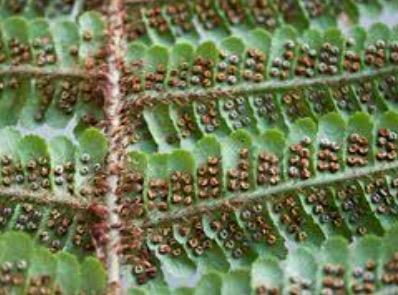
– a new fern for Scotland
Dryopteris kerryensis, previously thought to be endemic to SW Ireland, has now been found in other Irish locations, in Cumbria and in Somerset. In 2021 Roger Golding found a plant above Lochan na Lairige, v.c.88, NN592 406, confirmed this year on a BPS visit, a new record for Scotland.
Dryopteris kerryensis © Roger Golding
BSS - Scotland’s National Botanical Society since 1836, a Scottish Charity
We run lectures, field meetings, training workshops and the Urban Flora of Scotland Project. We publish the BSS News and the international journal Plant Ecology and Diversity, and produce a weekly blog https://botsocscot.wordpress.com/.
We give grants to students and recent graduates for fieldwork, an annual prize for the best undergraduate dissertation, and offer subsidised rates for students.
Join online BSS MEMBERSHIP | Botanical Society of Scotland (botanical-societyscotland.org.uk)
14
John Grace & Julia Wilson: Botanical Society of Scotland’s Urban Flora project
Since 2015 we’ve been collecting species, abundance and habitat data from Scottish towns and cities. In 2022 our surveys included North Ayrshire, Lanarkshire, and Moray –with a major effort in the Aberdeen area. Our iRecord database contains 73,000 records and several thousand more are imminent. We wish to represent urban centres in all parts of Scotland. This is a major project, and we thank several other organisations (including the BSBI) and many volunteer recorders for their participation.
Louise Marsh, BSBI Communications Officer BSBI: Atlas 2020 Poster, Other BSBI Posters
The BSBI is the leading organisation for amateur and professional botanists in Britain and Ireland. If you are not already a member and would like to support and participate in our work, please join us! It is a great line in CVs and there is no better way to improve your field skills than by going on our meetings & workshops. A selection of BSBI publications is displayed.
Jim McIntosh, BSBI Scottish Officer: The Plant Identification Table
A great opportunity to get expert help with identification with so many experts in the audience! Remember to bring your specimens and handlens! Add a note of who collected it, when and where. If you can identify specimens, please annotate with your determinations/confirmations and your name.
Natalie Harmsworth: BSBI Photographic Competition
A wonderful display of 194 photographs for this year’s competition is on show. Vote for your favourite shot in each of the four categories: Flowers in the four seasons: winter, spring, summer & autumn. The winners will be announced after the final talk and each winner will receive a book token courtesy of Summerfield Books. The winning photographs will be on display at the prize giving and will also appear in future BSBI publications and on BSBI Flickr
The Wildlife Information Centre (TWIC) Autumn Conference, Natalie Harmsworth
Details of The Wildlife Information Centre’s forthcoming Autumn Conference ‘Home & Away; wildlife movements & migrations” on 19 November in Edinburgh will be on display. TWIC is the Local Environmental Records Centre for SE & most of central Scotland. All naturalists are welcome to attend this event which is always a highlight in our diary
Royal Botanic Garden Edinburgh (RBGE) Elspeth Haston, RBGE Herbarium Curator: Herbarium. Lorna Mitchell, RBGE: Library and Archives
The RBGE Library and Archives holds Scotland’s national collection of botanical and horticultural literature. The poster provides a brief overview of the size and content of the collections, links to available catalogues and the arrangements that are in place for readers wishing to visit.
15
ATLAS 2020






Mapping Changes in the Distribution of the British and Irish Flora
The third BSBI atlas, based on fieldwork carried out from 2000 to 2019 (the Atlas 2020 project) is published by Princeton University Press on 8 March 2023. It presents the results of field surveys by the Botanical Society of Britain and Ireland, building on past atlas surveys undertaken by the Botanical Society in the early and late 20th century.
Drawing on the work of thousands of botanists who covered the entirety of Britain and Ireland between 2000 and 2019, this two-volume book features introductory chapters that provide a detailed assessment of the changes to the region’s flora over the past hundred years. Distribution maps and accompanying text and graphics display the phenology, altitudinal range, and time-series trends for some 2,700 native, alien, and hybrid species.


With more than 30 million records gathered during the project, Plant Atlas 2020 will be an essential resource for the study and conservation of these wild plants and their vitally important habitats for decades to come. Outputs from the Atlas 2020 project comprise - A 2-volume printed Atlas, available in bookshops in Spring 2023; BSBI members will be able to pre-order in January 2023 and will benefit from an exclusive 50% discount offer.
- An Atlas website featuring interactive maps for both native and introduced taxa, displaying frequency and distribution at a variety of scales.
- A summary of the key findings, assessing changes since the 1950s and analysing the drivers of change, such as habitat loss, pollution and climate change, and summarising the current state of the British and Irish flora.
SCOTLAND OFFICER'S REPORT 2022
General recording
A total of 197,254 plant records have been submitted to the BSBI Distribution Database for Scotland for 2022, as of 11th February 2023. This represents 27% of the total records submitted for 2022 across the whole of Britain and Ireland, an impressive return. An additional c.17,000 records are known to be awaiting upload, so the final total will be well over 200,000 records. Plotting recording effort in Scotland year by year from 1980 to the present is an interesting exercise and shows just what a game-changer the Atlas 2020 recording period has been – the dip in recording effort post-Atlas 2020 is still abut equal to the peak annual recording effort for Atlas 2000.
16
Scotland recording effort 1980-2022
Eight vice-counties have submitted over 10,000 records to the Database for 2022 so far, with the highest vice-county total a remarkable 24,307 records. A huge thanks to all the recorders who have contributed over the course of the year, and with over 1,000 records already on the Database for 2023 it has been a great start to the new year.
Projects
About 20 vice-county recorders participated in the Scottish HectAd Rare Plant Project (SHARPP) in 2021, which aims to gather detailed records of rare plant populations not recorded since before 2000 (despite Atlas recording). Details on recording effort in 2022 are still being collated, but several recorders have shared stories of particularly satisfying re-finds! Anecdotally, the successful re-find rate has been around or below 50%, but even when the target species weren’t found, plenty of other useful records were made in lovely habitats. Null recording for rare species populations is also very valuable from a monitoring and conservation perspective.
Recording outings were held in several vice-counties for the Urban Flora of Scotland Project, developed by our sister society the Botanical Society of Scotland, and 122 lists were submitted from Scotland for the BSBI New Year Plant Hunt 2022
Field meetings and training workshops
Fifteen meetings and workshops were held in Scotland in 2022, ranging from beginners’ training workshops to a search for one of Scotland’s rarest montane plants. The 2022 BSBI Recording Week was based at Corrour in July. Eighteen botanists attended, with a great mix of young and older botanists, and a huge amount of recording and learning took place. A week was also spent in Torridon in August with the National Trust for Scotland, with the highlights recording rarities on Liathach and Beinn Dearg.
A long weekend field meeting in June to Mullach Coire Mhic Fhearchair and Sgurr Dubh was held to re-record remote, botanically rich cliffs last visited 25 years ago. Despite challenging weather, a great haul of new and re-finds were made. Another June field meeting was held at Sithean Mor near Arisaig, to try and re-find Diapensia lapponica (Diapensia), photographed hereabouts in 2006. Despite organising forensic sweeps of the summit area, the plant sadly eluded the team, but other great species were found and lots of valuable recording done.
17
0 50000 100000 150000 200000 250000 300000 350000 400000 450000 1980 1982 1984 1986 1988 1990 1992 1994 1996 1998 2000 2002 2004 2006 2008 2010 2012 2014 2016 2018 2020 2022 No. of records Year
Introductory training workshops were held on Sedges and Rushes (Chris Miles), Grasses (Michael Philip) and Composites (Faith Anstey), and four beginners/training field days were led by Jim McIntosh, Faith Anstey, Dan Watson and Lindsay Mackinlay. Huge thanks are due to all trainers and supporting tutors – their work to encourage and develop new botanists is essential to the continuing rude health of the Scottish botanical community. For the more advanced botanist, a Covid-delayed workshop on Taraxacum (Dandelion) identification was held in Wigtownshire by John Richards and Caspian Richards, and Angus Hannah continued his programme of Rubus (Bramble) training and recording.
Conferences
A BSBI-wide Spring Conference was held on 26March. This included items of particular interest to Scottish botanists, notably talks on BSBI Recording projects including SHARPP, producing Floras, Checklists and Rare Plant Registers, the conservation of Woodsia ilvensis (Oblong Woodsia), and a workshop on Erophila (Whitlowgrass) identification. All the talks are available on the BSBI YouTube page.
The 2022 Scottish Botanists’ Conference was held on 5th November at RBGE, with 146 attendees on the day, and marked a return to an in-person event after two years of online conferences. A farewell dinner to mark Jim McIntosh’s retirement as Scottish Officer was also held in the evening. There was a real buzz of enjoyment on the day as people were reunited after lockdown, and it felt like a fitting tribute to Jim’s phenomenal work. Again, all the talks are available on the BSBI YouTube page.
Annual Reports
Annual reports for 2022 have been submitted for 36 vice-counties, showcasing a brilliant range of activities and botanical discoveries. Themes include Local Wildlife Site surveying, Rare Plant Register fieldwork, SHARPP searches, Urban Flora recording, local botany group meets, guided walks, providing botanical training and advice, scientific research and publications, verifying iRecord records and filling recording gaps.
Thanks, and a fond farewell
Thanks to all the BSBI recorders, members, volunteers and supporters who contributed to the BSBI’s work in Scotland in 2022. We are particularly grateful to NatureScot, RBGE and the MacRobert Trust who supported the BSBI in Scotland over the last year. After a remarkable 18 years as BSBI Scottish Officer, Jim McIntosh retired at the start of December. Jim has worked tirelessly to support and develop the botanical community in Scotland, from helping people take their first steps as botanists to training vice-county recorders to use MapMate and the Database. His work has been integral to the Plant Atlas 2020 project in Scotland – supporting recorders, organising and leading field meetings and conferences, sourcing and integrating third-party datasets, and even recording the odd plant along the way (a quarter of a million records and counting!). Jim continues as vice-county recorder for Mid-Perthshire and has joined RBGE as a Research Associate, and we wish him an enjoyable, fulfilling and no doubt busy retirement!
Matt Harding, BSBI Scotland Officer, February 2022
18
2022 County Report for VC72 Dumfriesshire Chris Miles
The year started with a New Year Plant Hunt in Dumfries. The Dumfriesshire Botany Group then went on to hold 10 meetings through the year. The last of these in September focused on lowland willows. Illustrated accounts of each of these with highlights of finds are available on the VC72 web page Dumfriesshire, v.c. 72 – Botanical Society of Britain & Ireland (bsbi.org) .
An introduction to Sedges and Rushes workshop was held for fifteen participants on 18 June. An exhibit highlighting eight particularly interesting finds in 2022 was presented at the Scottish Botanists' Conference in November. These included one first vice county record for Mudwort Limosella aquatica New populations or refinds of other rare scarce or uncommon species locally include Frog Rush, Juncus ranarius, Coralroot Orchid
Corallorhiza trifida and Adder's-tongue fern
Ophioglossum vulgatum for which 7 new sites in 2022 was exceptional. Details are available on the web page.



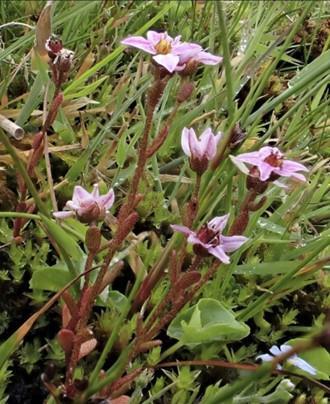
Further Hieracia were collected and sent to the Referee for determination or confirmation. These included Waterfall Hawkweed H. stenophyes restricted to the Southern Uplands and one that could be Rusty-red Hawkweed H. rubiginosum which would be a new VC record. With some records still to be uploaded about eight thousand records will have been collected and entered into the DDB. This will include further recording in the Moffat Hills where monad coverage edges towards completion.
2022 County Report for VC73 Kirkcudbrightshire David Hawker & Sarah White
This year the major concern was the adverse effects of a proposed new SPEN pylon power line on two species – Hydrilla verticillata (IUCN Threatened) at its only extant UK site, and Pyrola media (Sc GB 2021: Vulnerable) at one of only known 4 VC73 sites. Both populations adjoin the construction route. I attended Hearing Sessions in November but the Reporter will not produce an opinion until late 2023. The VC’s remaining quality habitats are under increasing pressure from numerous windfarm and commercial forestry applications, existing forests already occupying around 30% of the land area. The local group met 10 times this year (see BSBI’s VC73 webpage), covering a wide variety of habitats, low tide to the uplands, including several monads with no previous records. In addition, several members individually surveyed selected monads close to
19
VCR REPORTS
their homes. There are around 5500 records from 35 monads, which included monitoring selected populations of 14 Locally Rare or Scarce species, notably Meum athamanticum, 2 Zostera spp., Silene viscaria, Ophyris apifera, Carex elongata, C. punctata, Anthoxanthum nitens, Ranunculus sardous and Thelypteris palustris – some with data going back to 1947!
We advised 4 conservation-oriented farmers on measures for high value habitats, in particular safeguarding populations of M. athamanticum, O. apifera, Platanthera spp, and Carex limosa. I submitted 1988 and 1993/4 personal data on Zostera spp. to the Seagrass Project. The RPR is an ongoing project while an annotated checklist is proposed for 2023.
2022 County Report for VC74 Wigtownshire
Michael Jeeves
I prepared a newsletter containing a summary of plant findings in 2021 and arranged for this to be posted on the BSBI’s VC74 web page. Having been contacted by several visitors to the area requesting advice on places to go to see plants, I also prepared an information sheet on this subject and that too will hopefully be put onto the web page.
I led two well attended guided walks at Port Logan Bay for the Southern Uplands Partnership and Logan Botanic Garden, to introduce people to the coastal flora of this beautiful area. A single specimen of Oysterplant Mertensia maritima was enjoyed by all, along with a large colony of Pyramidal Orchids Anacamptis pyramidalis
Wood of Cree is a large RSPB nature reserve that straddles the boundary dividing VC73 and VC74. I produced an annotated checklist of vascular plants for the reserve to assist the site managers with their work.
I assisted with a project co-ordinated by Michael Philip on behalf of ivy authority Alison Rutherford by collecting specimens and taking photos of ivy plants in my area (Atlantic Ivy Hedera hibernica here). Alison is intending to publish an article on ivy identification in BSBI News. A total of 1229 records for VC74 have been processed to date.
2022 County Report for VC75 Ayrshire Dave Lang
Though there may still be records to come in from others, 2185 new records were made in the field by the small VC75 Ayrshire BSBI group during 2022 - meeting up about twice a month from spring through to autumn. Locations visited were largely chosen with the Scottish Hectad Rare Plants Project (SHaRPP) in mind, though in some cases we simply visited areas that we had not botanised before. Unfortunately however, only one of the nine SHaRPP target species was actually refound – the Locally Scarce Potamogeton alpinus (Red Pondweed) on our last field trip of the year!
We continued to contact local members to advertise field meetings through our Ayrshire e-mail group, however many of those who often attended these trips pre-COVID have not yet returned and we may need to give some consideration to whether we want to put some effort into increasing engagement among local members or whether we are
20
content to continue botanising with our core group of enthusiasts. One interesting addition to our usual programme of trips this year however was some assistance that we provided to some BSS-organised urban botanising trips to towns on the North Ayrshire coast.
A new location was also found in 2022 for the Locally Rare Lepidium campestre (Field Pepperwort); along with several new sites for various other Locally Scarce or more common but GB Red Data listed species.

In terms of other interesting finds, highlights included two new sites for the Locally Scarce Bidens cernua (Nodding Bur-marigold), which we previously had only three sites for in Ayrshire.

And confirmation of the continued presence of a solitary Pseudorchis albida (Small-white Orchid) spike at its only Ayrshire site.
2022 County Report for VC76 Renfrewshire
Keith Watson
2022 was another good year for recording in Renfrewshire, with over 8000 records made. A wide range of local recorders were involved in making such a good total, including members of the informal local botany network. Jim Blackwood continues to be active in the Lochwinnoch area, and Malclom Macneill has extended his urban foraying into more of Renfrewshire producing a number of interesting casual finds.
Neighbouring recorders Peter Wiggins and Michael Philip have again been active in the vice-county, and Michael helped organise bramble workshops, which Angus Hannah kindly led and put in much time and effort. This has resulted in an increasing knowledge of local brambles and hopefully this will continue. Further information on interesting records and recording activities is provided in the newsletters on the BSBI local botany webpages.
21
2022 County Report for VC77 Lanarkshire Michael Philip & Peter Wiggins
2022 has been a year of modest progress in Lanarkshire. We have added over 6,500 records to the database, from 117 monads. In 29 of these, over 100 records were made.
One notable focus has been urban recording - not only the valuable ongoing solo work by our urban specialist, Malcolm Macneill, but several group outings to contribute to the Botanical Society of Scotland’s Urban Flora Project: Glasgow, Motherwell, Lanark, Strathaven, Tannochside (Uddingston) and Shotts have been visited this year.
We were approached early in the year by the Scottish Wildlife Trust Reserve at the Falls of Clyde to seek our input into a fresh botanical survey of the site. Numerous visits were made during the year by various combinations of people, resulting in over 1,000 records across 10 Compartments, including over 270 species. In 2023 there will be further work on this, hunting for some of the rarer plants previously known on the site.
We were delighted to host the BSBI Grasses Workshop at Chatelherault Country Park in June. This is a great venue for this topic and we will do it again before long.
Among the more interesting finds were Typha laxmannii (Slender Reedmace), which is now appearing as a planting in urban SUDS and may escape, Carex x involuta (the hybrid between Bottle Sedge and Bladder Sedge) in Dunsyre in September, and Cardamine corymbosa (New Zealand Bitter-cress) - a tiny weed of pavement cracks which may have been under our urban noses for some time!
2022 County Report for VC78 Peeblesshire Luke Gaskell
I continue to concentrate on the under recorded parts of Peeblesshire with some exceptions for urban areas and parts of the county that are being afforested. I recorded 3638 plants with 519 individual species and sub-species in monads during 32 days of field work last year.
One problem that has arisen is how to distinguish between species that have been deliberately planted or sown compared to those that have arrived naturally or spread unintentionally. For example, Crassula tillaea (Mossy Stonecrop) is a native of southern England, but is now spreading north and often found in car parks. It arrived at the Station Road car park in Peeblesshire and survived for a few months, before falling victim to the councils ongoing war on street weeds. Curiously its spread has been associated with railway stations in the north, but the railway in Peebles is long gone.
Another example is the annual Agrostemma githago (Corncockle) that I found growing amongst nettles on a road verge and recorded as an introduction. However, with global warming it is possible that it is setting viable seed and hence could now persist naturally.
22
Finally I find the afforestation of Gameshope estate concerning. I am recording the change of species related to the new regime of moving from sheep to trees. Some of the species planted have never been recorded in Peeblesshire and hence are of note. At present Orchis mascula, (Early-purple Orchid), Trollius europaeus (Globeflower) and Asplenium viride (Green Spleenwort) are doing well on this estate, it will be interesting to monitor their continuing success.

Ceratochloa carinata (California Brome) 1st VC record. This striking Brome is described by Tom Cope as a rapidly spreading neophyte which was first recorded as an escape from The Royal Botanic Garden at Kew in around 1919 and there are now scattered records across Scotland. This specimen is from a weedy street planter in Peebles where it was growing in association with Avena fatua (Wild-oat). It is possible that it arrived with manure or perhaps bird fee
Hordeum jubatum (Foxtail Barley) 1st VC record. Roughly fifty plants were found growing on a disused slipway in the drawdown zone of the Megget reservoir in upland Peeblesshire. This neophyte has a predominantly southern distribution usually preferring drier ground but it also thrives on salted road verges and especially favours roundabouts. Its presence at 340 meters altitude some 70 meters below its highest recorded location by the A701 at the near-by Devil’s Beef Tub, Dumfriesshire, is surprising.

23
Equisetum pratense (Shady Horsetail) A first record for the 10km square. Polmood Craig is a north facing cory below Broad Law which at 840 meters is the highest hill in Peeblesshire. There are a few rocky buttresses but it largely comprises loose rock and scree which is easily accessible to the Polmood estate sheep . The horsetail was growing in a small wet flushed area in association with Cochlearia pyrenaica (Pyrenean Scurvygrass), Saxifraga hypnoides (Mossy Saxifrage)and abundant Sedum villosum (Hairy Stonecrop).
Populus nigra subsp. betulifolia (Black-poplar) Second VC record. Reuben Singleton found this old male tree which is growing by a ditch near the Eddleston Water just above Peebles. It is likely to have been planted but this could have been accidental as the ditch is mostly lined with Populus tremula (Aspen). This is the first recent record for Blackpoplar, G C Druce first recorded it at Traquair East of Peebles in 1918 and David McCosh recorded that “one vast fallen tree remained… in 1983”. The sub-species is not however noted.
2022 County Report for VCs 79 & 80 Selkirk & Roxburghshire
Jeff Waddell & Rod Corner
2022 was the most productive year for recording ever in vc80, in terms of the number of records collected, with 12,544 records collected of 756 taxa. This was due to one of the VCRs (Jeff) moving back to live on the edge of the county, allowing frequent evening recording sessions after work.
Much of the fieldwork was therefore undertaken in the northern half of the county, within relatively short distance of Galashiels. Several trips wider afield were also undertaken, by Jeff or with the local botany group. 132 monads were visited, with 100+ taxa recorded in 76 of these. The most species rich monad, NY4787, Holm Hill, Newcastleton, had 275 taxa recorded.
Twenty three new vice county records were made, all of which were non-native. Ten of these were trees or shrubs, recorded by Matt Parrat (Betula utilis, Forsythia x intermedia, Fraxinus angustifolia, Picea jezoensis, Pinus banksiana, Pyrus salicifolia, Quercus ilex and Sciadopytis verticilliata), Luke Gaskell (Laburnum x watereri) and Jeff (Lonicera involucrata). Seven were Narcissus recorded by Jeff (“Barrett Browning”, “February Gold”, “February Silver”, “Ice Follies”, “Mount Hood”, “White Lady” and Narcissus poeticus sub spp. recurvus). The remaining six were mostly spring flowering herbs, recorded by Luke (Hyacinthus orientalis & Scilla luciliae), Matt (Hacquetia epipactis & Iris foetidissima) and Jeff (Cardamine heptaphylla & Pastinaca sativa). Rod Corner visited Floors Castle in May and found Acaena novae-zelandiae (Piri-piri-bur) and Oxalis exilis (Least Yellow-sorrel) in sheets intrackside woodland and Montia fontana ssp. fontana (Blinks) on the moist trackside where it has been present for for 25 years.
The photo shows Bowdenmoor south of Melrose, one of the finest areas of unimproved lowland grassland in southern Scotland, where the nationally uncommon (in Scotland) Great Burnet Sanguisorba officinalis has a large population and was recorded in 2022.
24
My intended Flora of the two vice-counties is coming on and I am very much aware that there may be frustration in the BSBI that it has been glacial progress over the past few years. I shall include all the recent records in dot maps with Stace 4th edition for nomenclature.
Interesting finds included: Gymnadenia densiflora (Marsh Fragrant Orchid) which is rather local in Roxburghshire, a new colony was discovered in unimproved damp grassland at Blakelaw in NT73, extending its known range significantly in south east Scotland.

Paris quadrifolia (Herb Paris) has just two sites in Roxburghshire. The Mossburnford colony was visited on the 8th May and seemed to have declined in area, but is still present.
Epipactis helleborine (Broad-leaved Helleborine) was refound at the base of Minto Craigs on the evening of the summer solstice, at one of its few sites in the county. The only site in the county for Petty Whin (Genista anglica) was found to have been destroyed by a forestry scheme in 2022. Several good sites have been and continue to be subject to such a fate in the Scottish Borders with the loss of much biodiversity. A new locality for the locally rare Vicia lathyroides (Spring Vetch) was found at Sweethope Hill. This is a fine outcrop of lowland unimproved grassland with abundant Helianthenum nummularium (Common Rock-rose). Several other specialities were recorded in 2022 including Dianthus deltoides (Maiden Pink) and Scleranthus annus (Annual Knawel). Sedum villosum (Hairy Stonecrop) was present on the edge of the old track at Pot Burn house, upper Ettrick and Dryopteris oreades (Mountain Male-fern) on the roadside near Ettrick Kirk normally widespread on screes. The Tima Water gravels between Glenkerry and Gair are being dominated by invasive Alchemilla mollis (Soft Lady’s-mantle) and are losing their botanical biodiversity”.

25
2022 County Report for VC 81 Berwickshire Robin Cowe
The New Year Plant Hunt kicked things off in 2022, giving the first few records for the year. Cranshaws and Coldstream were the target areas for the year, supplying many excellent records. Reston also got a look in, the new station providing a few unusual species for the year.

I became the verifier for i-record, adding some more records and hopefully some new recorders for the county. SHRAPP records were very disappointing with nothing to report. The record tally for the year was five thousand, many thanks to all who recorded and contributed throughout the yearSchizanthus pinnatus (Poor man's orchid)
[See Newsletter page 70 for the main text of this report. ]
Found in Haddington by Julia Wilson , first record for VC82.
Found in the carpark of Woodhall Dean (SWT), south of Dunbar, by David Adamson, first record for VC82.
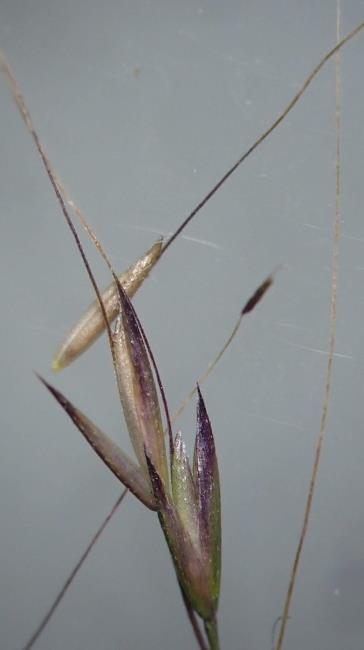
Crassula helmsii (New Zealand Pygmy Weed) was reported from a little pond on Garleton Hills, north of Haddington. The records for this invasive species are mainly at Duddingston Loch in Edinburgh, and a pond over near Tyninghame, so the likelihood is that it has travelled on bird’s feet. The piece I took home was thoroughly toasted in the oven! The Ranger for the Garleton Hills has said she will attempt to eradicate it.

26
2022 County Report for VC82 East Lothian Marion Moir
Polypogon monspeliensis (Annual Beard Grass) LEFT
Apera spica-venti (Loose Silky Bent) RIGHT
2022 County Report for VC83 Midlothian Sue Jury
Most of the recording in Midlothian took place after the middle of July when I took up the vacant position as County Recorder. In a frenzy of recording, a total of 11,866 records were added to the DDB. In this time 42 monads were attended to. The criteria of these monads were those monads with no, or few records, or monads that needed updating, having only pre 2000 records.
I especially wish to thank Richard Milne for his notable finds, and his article which appeared in the September Issue of the BSBI News. His Hypopitys monotropa, (Yellow Birdsnest) is on the front cover. Descriptions of other notable finds are in the article. Hypopitys monotropa was found in an old tyre on the Brownfield Site at Moncktonhall Bing. Brownfield Sites are important habitats in Midlothian. I have sent an email to TWIC to see if this could be made into a PLBS.
Notable new finds in 2022 included
Orobanche hederae, (Ivy Broomrape) growing in the RBGE. A spontaneous arrival and a First for Midlothian.
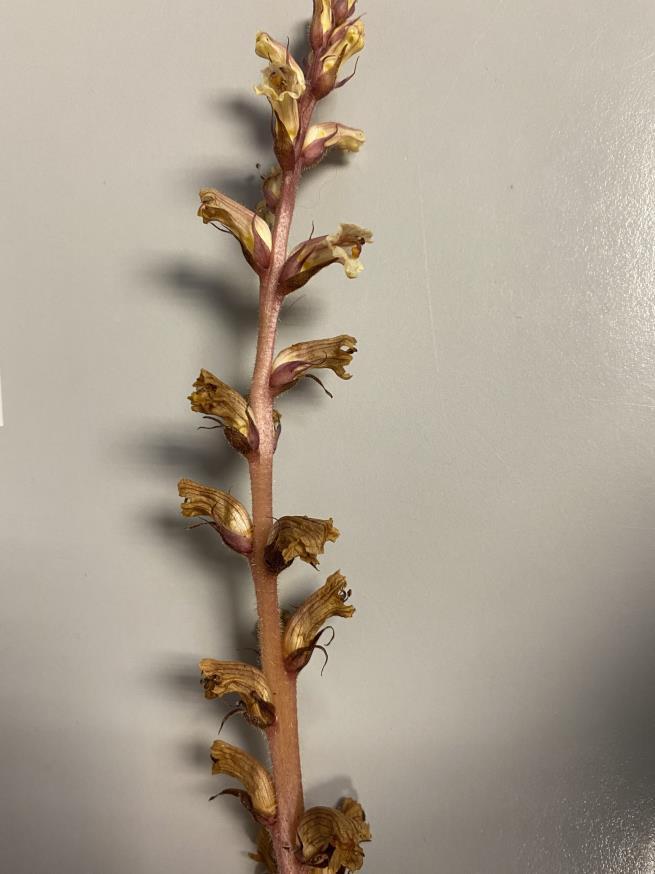
Euphorbia stricta, (Upright Euphorbia) new record, in 2 sites. There are probably more to be found. Malva verticillata, (Whorled Mallow) second record for Scotland and a new record for Midlothian, waiting verification. Paris quadrifolia, (Herb Paris) Morningside Road. Only other recent find since 2000 is in Vogrie Park.
Notable refinds in 2022 included Gagea Lutea, (Yellow Star of Bethlehem) 12 Flowering head along the River Esk at Cockpen Senecio inaequidens, (Narrow-leaved Ragwort) spreading in the VC south and west. Juncus Gerardi, (Saltmarsh Rush) 1987, Silverknowes. Scirpus Sylvaticus, (Wood Club-rush) 1982, Spittleton Wood. NB Hammarbya paludosa (Bog Orchid) is now extinct in the VC.
LBS steering group meeting was attended by the County recorder. A new revised updated 2nd edition of the Rare Plant Register was updated by Barbara Sumner.
27
2022 County Report for VC84 West Lothian
Jay Mackinnon
iRecord has been a great source of interesting records: I am checking and validating in iRecord (finders sometimes upload photos which help confirm identity), then the next task will be to import these records to the DDB. Nice finds via this route include a new hectad record for Verbascum nigrum (Dark Mullein) and the second record of Lathyrus nissolia (Grass Vetchling) for the county. There are other records even more exciting but these will require field verification.
Thank you to everyone sharing their records, whether directly to me or via iRecord. For family reasons I haven't done so much field recording myself this year and local botany group The Foliage Fraternity has had a hiatus.
2022 County Report for VC85 Fife & Kinross
9,500 records for 2022. The majority from various people recorded on iRecord and validated on a regular basis.
Projects:
Survey and recording for several Fife Wildlife Sites and coordinating with Fife Council Research Team.
Survey and recording of two Perthshire Wildlife Sites which are in vc85 and coordinating with the Planning Officer.
Fieldwork:
Apart from regular recording, a visit to Tentsmuir with the St. Andrews Botanic Garden staff to record the dune plants and demonstrate the dune succession system there. This is to help and advise with their Tangled Bank project, some of which has been the construction of a replica sand dune system in the garden.
Records
Sandy Edwards
Centaurium littorale (Seaside centaury)
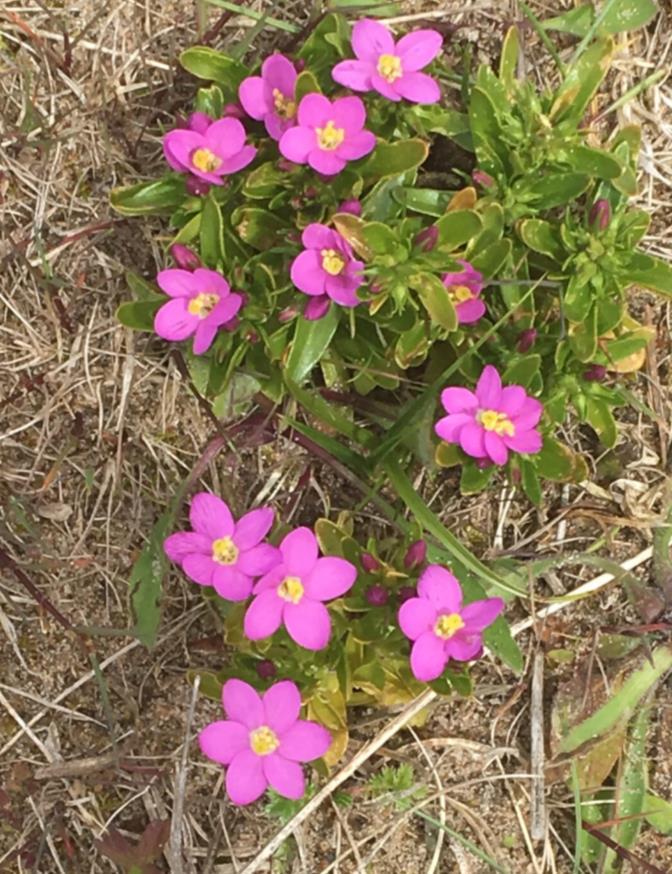
Hottonia palustris (Water violet) New record, only 4 records in Scotland. Found in burn fed pond in old wood at Balbirnie. Looks well established.
Helminthotheca echioides (Bristly oxtongue) A large specimen at Kinghorn Loch. Found at the Wildflower Workshop. First good new record, the previous one was a small flowerless specimen. A rarity in Scotland. [See page 11]
Salvia verbenaca (Wild Clary) Only one or two records for this in Fife.
28
Limosella aquatica (Mudwort) Refound as part of the SHARPProject. A few plants at Morton Lochs, Tentsmuir.
Artemisia verlotiorum (Chinese mugwort) Found at Kinghorn, maybe a garden escape or from a seed mix, but well established in wild.
2022 County Report for VC86 Stirlingshire Phil Sansum & Matt Harding
2022 was a productive year, with over 14,000 records made in VC86 – a huge thank you to all contributors, particularly Keith Watson, who submitted c. 3,000 records from East Dunbartonshire, and Sarah Longrigg, who made interesting new records and re-finds.
During fieldwork for the upcoming Rare Plant Register, over a third of all locally or nationally important species known from VC86 were re-recorded, along with many new additions to the vice-county flora. Highlights included Trifolium striatum (Knotted Clover) and Teesdalia nudicaulis (Shepherd’s-cress), both unrecorded for over 50 years Previously thought extinct in the vice-county, a population of the latter, consisting of hundreds of plants, was discovered in the Carron Valley.
An excursion to the Haughs of Airth by the nascent Stirlingshire Botany Group discovered Lactuca virosa (Great Lettuce), last seen in Stirlingshire in the 1800s.
On Ben Lomond, Draba incana (Hoary Whitlowgrass) was re-found where last recorded in 1968; Euphrasia frigida (Upland Eyebright) and E. ostenfeldii (Ostenfeld’s Eyebright) were identified for the first time.. Filago germanica (Common Cudweed) was discovered by the Falkirk Wheel, and Plantago coronopus (Buck’shorn Plantain), Lipsandra polysperma (Manyseeded Goosefoot), Lamium confertum (Northern Dead-nettle) and Stachys arvensis (Field Woundwort) were recorded at a site near Milngavie, where pipeline restoration works had used imported topsoil from the Ayrshire coast.
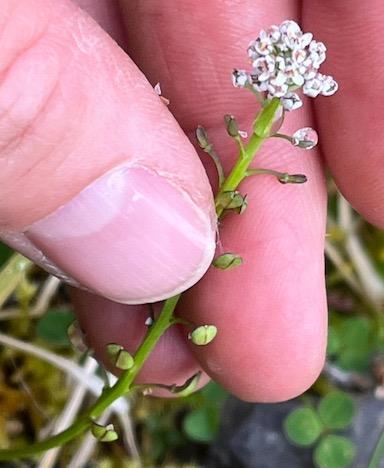
A survey of Jasione montana (Sheep's-bit) at Auchinstarry Quarry discovered it at numerous points along the cliff top, as well as occasionally on the cliff face
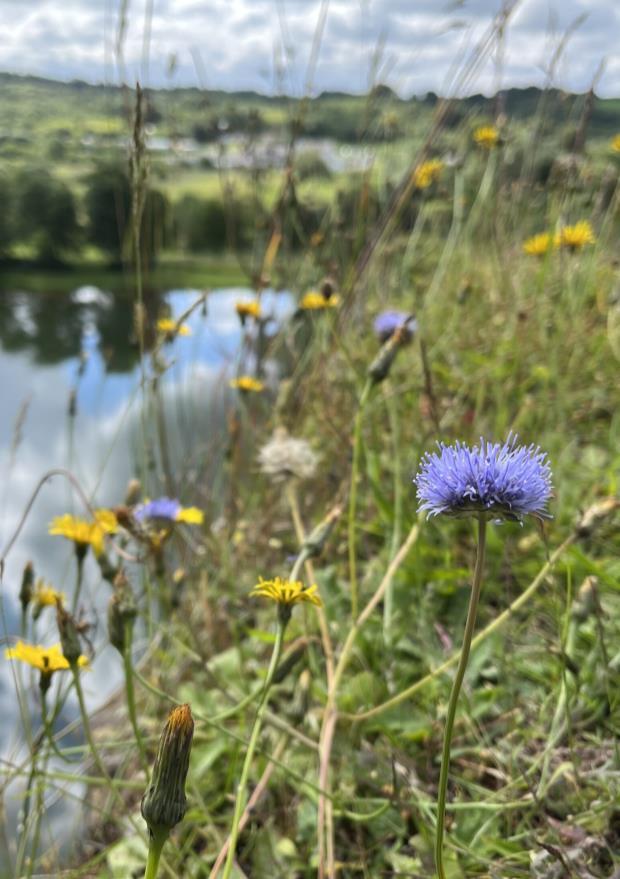
29
Aquatic plants were well represented, including Nuphar pumila (Least Water-lily), Utricularia minor (Lesser Bladderwort), several Potamogeton species and Hydrocharis morsus-ranae (Frogbit). Orchid monitoring continued for species such as Corallorhiza trifida (Coralroot Orchid) and Coeloglossum viride (Frog Orchid), and valuable records of Carex magellanica (Tall Bog-sedge) and Hymenophyllum tunbrigense (Tunbridge Filmyfern) were received.
Two posters were exhibited at the Scottish Botanists’ Conference, and work continued to designate Local Nature Conservation Sites, in partnership with TWIC and Stirlingshire Council.
2022 County Report for VC87 West Perthshire
Liz Lavery & Jane Jones
It has been a quiet year in VC87 though over 3300 records were collected.
One memorable day was climbing Ben Venue near Aberfoyle. A rich flush was found with Helictochloa pratensis (Meadow Oat-grass), Carex dioica, C. hostiana, C. pulicaris (Dioecious, Tawny and Flea Sedges), Galium boreale (Northern Bedstraw), sheets of Micranthes stellaris (Starry Saxifrage), Thalictrum alpinum (Alpine Meadow-rue), Thymus drucei (Wild Thyme) and Trollius europaeus (Globeflower). Cornus suecica (Dwarf Cornel) was found growing beside the path and a large clump of Saussurea alpina (Alpine Saw-wort) was balanced on a large rock in the middle of the way to the summit. The final find was Juncus triglumis (Three-flowered Rush) tucked in beside a large cairn where two routes joined.
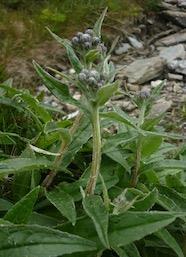
In 2021 a small
group from RBGE had visited Leny House and grounds near Callander and recorded at the base of Leny Glen. This, however, still left a large proportion of the narrow steep sided valley unexplored and unrecorded. But this was recified this year when the owner of the upper part of the glen accompanied us and we were able to explore and record the remainer of the glen.
Finally, Equisetum pratense (Shady Horsetail) had been recorded by the cycle track north of Callander in August 1998 but never refound. A trip was organised at a similar time to see if it was still there.
Unfortunatlely only E. arvense (Field Horsetail) was found but the under growth was dense and it was felt going earlier in the year might be beneficial. So this is on the to do list for 2023.
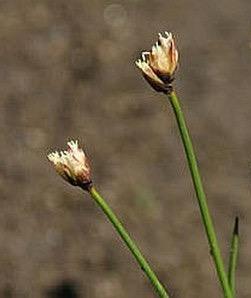
30
2022 County Report for VC88 Mid Perthshire
Jim McIntosh
Recording reached an all-time low in Mid-Perthshire in 2022, with Alistair Godfrey’s failing health sadly leading to his death in December, and my pre-occupation with wrapping-up before retirement as BSBI Scottish Officer.
However, I am very grateful to the 18 resident and visiting botanists who helped collect just under 1000 records. What we lacked in quantity we made up for in quality, with 70 records of Nationally Rare or Scarce species, and 45 of Red Data List species.
Particular thanks go to Dan Watson for his annual batch of records – largely from Ben Lawers NTS and to Ian Strachan who took the time to record on the VC88 side of our remote shared north-western boundary during the Corrour recording week.
Two highlights from 2022 are listed below along with three notable 2021 records that didn’t come to light until this year.
A new hectad record of Melampyrum sylvaticum (Small Cow-wheat) was made by Gus Routledge on the shore of Loch Rannoch, near Bridge of Ericht. The population is probably at least a couple of thousand plants making it one of the biggest Small Cowwheat populations in the UK. Photograph by Gus Routledge.
A new hectad record of a large patch of Linnaea borealis (Twinflower) ©Dan Watson was found on Meall Corranaich near Ben Lawers by Harry Corby & Dan Watson – a very rare species in Mid-Perthshire with just one other population in the past 39 years.
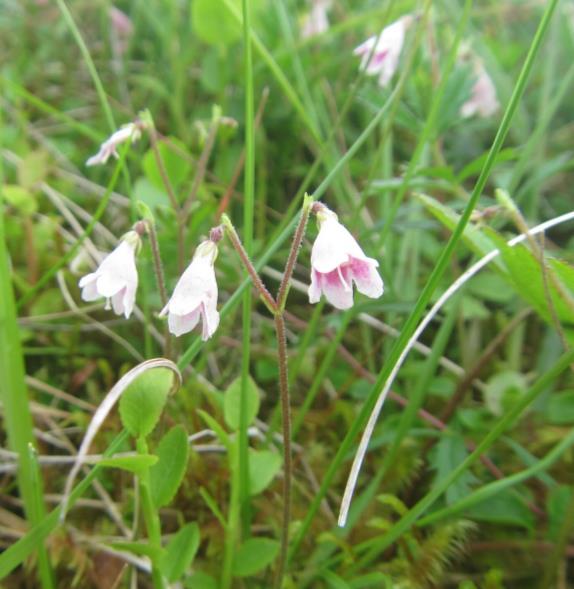
Simon Harrap made a remarkable new hectad record of a single flowering plant of Trocdaris verticillata (Whorled Caraway)© Simon Harrap in the exclosure near the NTS Ben Lawers carpark in 2021.
A new (2021) record for Scotland of Dryopteris affinis subsp. kerryensis by Roger Golding [see page 14] near Lochan na Làirige at a new altitudinal record for the British Isles of 600m. Previously known only in Ireland and more recently from Cumbria and Somerset.
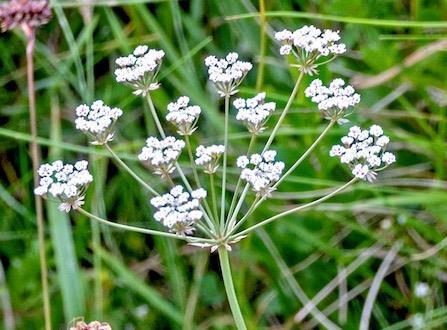
31
Ben Averis made a new VC record of Lycopodium lagopus (Hare’s-foot Clubmoss) in the very remote north of the county in 2021: three separate sub-populations in three adjacent monads. This is the ninth population recorded in Scotland (so far).
2022 County Report for VC89 East Perthshire Martin Robinson
The main fieldwork was the continuation of surveying potential Local Biodiversity Sites for Perth & Kinross Council. Six sites were visited with some interesting results, not all positive. One potential site contains the only sizeable colony of Platanthera chlorantha (Greater Butterfly Orchid) in the vice-county on an ungrazed scrubby bank. Their numbers had reduced from 435 in 2015 to 130 this year, as the scrub gets denser. Another site had masses of Meum athamanticum (Spignel) over an extensive area.
2,312 records were made during the year, of which the most satisfying was the rediscovery of Sedum villosum (Hairy Stonecrop) in Kindrogan Forest. It was found here in the late 1970s, new to the vice-county but not reported again, and I had been looking in the wrong place. This year I discovered the proper location from its original finder, Ron Youngman, and found it growing along 40 metres of trackside ditch. Another good discovery, thanks to the caretaker/gardener, was that the policy woodlands of a large house between Dunkeld and Blairgowrie were a hot spot for Neottia nidus-avis (Bird’snest Orchid). He showed me 63 spikes in nine locations.
Work continued on a revision/expansion of the Rare Plant Register, which is evolving into a much more informative document.
2022 County Report for VC90 Angus
Robin Payne &Theo Loizou
In June our co-VCR Mark Tulley died after a long illness. We had operated happily as team of three for a decade and will miss him. Although Mark had come to botany later in life, he had quickly developed his field skills. His great strength was in his patient and accurate data entry. “Always go out on the first fine day of the week” was Mark’s maxim. He was active in the field up to a few weeks before his death.
The VCRs have continued to assist Angus Council to identify a suite of Local Nature Conservation Sites, checking species records from a variety of sources. Fieldwork to update plant records for these sites is planned for 2023.
Some progress was made with the Scottish HectAd Rare Plant Project looking at first at a hectad close to Arbroath although none of those species were re-found. For some time, we have been aware of a general decline in plant diversity along the Angus coast, probably mainly due to natural succession. Intensive farming practices and climate change have probably also contributed. Other coastal records from 2022 which buck this trend include Crithmum maritimum (Rock Samphire) a new record for which was made between just north of Arbroath. This species reaches its northern limit on the east coast in Angus and is very scarce. Also Crambe maritima (Sea-kale): a second record for the vice-county also near Arbroath.
32
The Angus Glens are also a focus for rare plant monitoring. Concerns that Hammarbya paludosa (Bog Orchid) did not appear to be faring that well led to a field day in Glen Effock to check on known populations. Nearly all the main known populations were relocated with no evidence of any significant decline. In total population records for about six locations were obtained.
2022 County Report for VC91 Kincardineshire David Elston & David Welch
Filling gaps in records
A particular focus continues to be to visit and produce species lists for poorly recorded tetrads, in some cases requiring visits to tetrads with no previous botanical records in the BSBI Distribution Database (DDb). In total 51 such tetrads have been recorded in 2022 leaving 38 priority tetrads to be recorded in including 9 with fewer than 10 taxa in the DDb.
Rare Plant Register (RPR)
Work has continued on summarising records and producing accompanying text for a RPR for Kincardineshire. Some 450 taxa will be included, and the production of maps and insertion into neatly laid-out tables is being performed using a script in the statistical package R. It is hoped a full version of the RPR will be ready for release in 2023.
Outreach
1) A guided walk was given for the Scottish Wildlife Trust Aberdeen and Aberdeenshire Local Group at St Cyrus NNR on 4th June.
2) A talk entitled “Discovering Wild Plants In And Around Aberdeen” was given both to the Bridge of Don Community Discussion Group (13th October) and to the Scottish Wildlife Trust Aberdeen and Aberdeenshire Local Group (20th October). This talk drew heavily on records from Kincardineshire.
Urban Flora
An Urban Flora recording weekend was organised jointly with Botanical Society of Scotland (main photo by Chris Jeffree) from Friday8th to Monday 11th July. In total, the 17 people involved collected about 3300 records involving 426 taxa across 8 different settlements, 4 of which gave records for Kincardineshire.
Interesting finds
The guided walk for the Scottish Wildlife Trust Aberdeen and Aberdeenshire Local Group at St Cyrus NNR on 4th June led to two important finds: the first ever detailed grid reference for Phleum arenarium (Sand Cat’s-tail) in Kincardineshire (photo) and the first Kincardineshire record of Botrychium lunaria (Moonwort) since 1992.
33
Lepidium campestre (Field Pepperwort) was found by a cliff-top raised golf tee at Stonehaven Golf Course whilst gathering a full species list for the hectad NO88. This is the first Kincardineshire record since 1960. Dryopteris oreades (Mountain Male-fern) was found on a rock in heathland at Glensaugh, Fettercairn, just a few hundred metres from the site of the only previous Kincardineshire record.
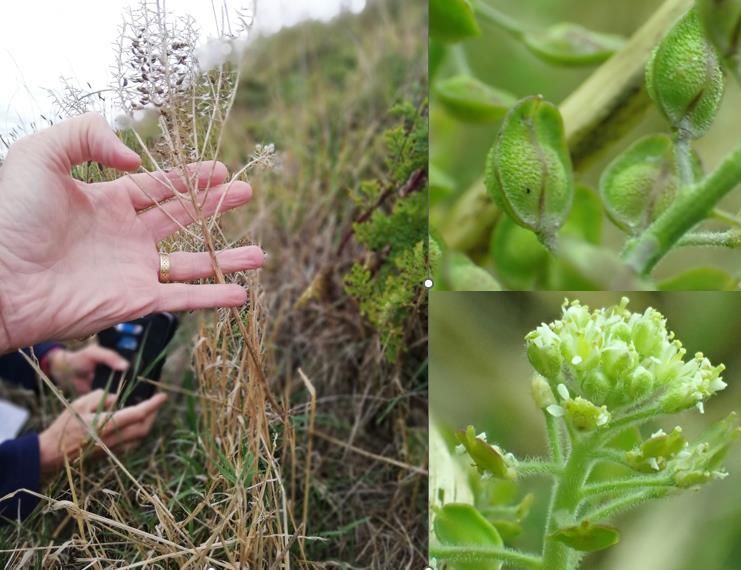
Prunus domestica subsp inisitia (Bullace) is thinly scattered in Kincardineshire, and whilst the grove at Kinneff bloomed well this year (photo), no fruit were produced. Polygonum boreale (Northern Knotgrass) was found in an arable field entrance near Cammachmore, a new species for Kincardineshire. The only candidate Salix triandra (Almond Willow) tree, at Waulk Mill, Strachan, has been cut down. However, a sprout from the base has been grown on and is now established in a garden in Banchory. The catkins recovered from the sawn-off branches were short and possibly suggest a cultivar or x mollissima
2022 County Report for 92 South Aberdeenshire Ian Francis
2022 saw 25 botanists submitting c. 1,520 records of almost 400 taxa during the year. Highlights included the first records for VC92 of Berula erecta (Lesser Water-parsnip), near Alford, probably introduced, and Limosella aquatica (Mudwort) at Loch of Skene. Recording on Mar Lodge by Shaila Rao, Andrew Painting and Dan Watson produced interesting records, including three of Diphasiastrum issleri= D. complanatum x alpinum (Issler’s Clubmoss), Hieracium eximium (Hirsute hawkweed) and Veronica alpina (Alpine Speedwell). Eight under-recorded species of bramble were found by David Welch and David Elston (including Rubus fissus, R. laciniatus, and R. vestitus)
34
Introduced or naturalised plants included Anne Burgess’s record of Lamium maculatum (Spotted Dead-nettle), only the fourth for VC92, and a very interesting re-find by Alison Peaker of Koenigia alpina (Alpine Knotweed) on shingles on the River Dee – known from very few places nationally. Finally, the drawdown of Loch of Skene SSSI revealed vast lawns of Eleocharis acicularis (Needle Spike-rush) The dense cover, at c.3 stems/sq.cm over c.3ha, was calculated by David Elston to total over one billion plants! This species is known from only five other sites in VC92.
Six visits as part of BSBI Scotland’s SHARPP survey found none of the target species despite six-figure grid references. Urban Flora recording in July jointly with the Botanical Society of Scotland, yielded records from four settlements - Aberdeen, Inverurie, Kingswells and Westhill. I thank Andy Amphlett and David Elston for their support and all who submitted records in 2022.
2022 County Report for VC93 North Aberdeenshire David Welch & David Elston
We spent less time than usual recording in VC93 this year since we were concentrating on producing a RPR for VC91, but have benefitted from more records submitted by other people. Adrian Breeman, Peterhead, sent upwards of 500 pictures of insects, mostly on flowers of common plants, and accuracy was needed as he then got some printed in a regional newspaper giving both insect and plant names. The Aberdeenbased Urban Flora recording weekend included Ellon and Inverurie in its itinerary, and additional urban monitoring was undertaken in Fraserburgh. Also, Richard Lansdown did Site Condition Monitoring for NatureScot.
A start was made on adding unnamed Rubus (Bramble) species to the DDb using Section names. Rubus ulmifolius, R. elegantispinosus, R. nemoralis, R. scissus (Brambles) 600 m of Rubus ulmifolius were found established along a new hedge in the Clashindarroch upland hectad, this being almost devoid of brambles previously. And three Rubus species scarce in the NE, elegantispinosus, nemoralis and scissus, had notable extensions of range into new hectads.

35
Interesting finds in 2022
At Fraserburgh. Silene vulgaris (Bladder Campion) was growing in abundance by a footpath (photo), only the third post-2000 site in vc 93 and the strongest. Also Trifolium micranthum (Slender Trefoil) was recorded in a housing estate.
Juncus balticus (Baltic Rush), Dactylorhiza incarnata (Early Marsh-orchid), (Autumn Gentian)

At Rattray Head a big colony of Juncus balticus (Baltic Rush) was observed (photo), together with Dactylorhiza incarnata (Early Marsh-orchid) and Gentianella amarella (Autumn Gentian) in the dunes. Good colonies of Cerastium arvense (Field Mouseear) were seen on roadside banks NW of Insch. Datura stramineum (Thorn-apple) appeared in a garden in Slains, and is a NVCR. Hedera colchica (Persian Ivy) had crept on to a road verge at King Edward, another NVCR. Ranunculus reptans (Creeping Spearwort), Potamogeton gramineus (Various-leaved Pondweed), P. pusillus (Lesser Pondweed)
Two colonies of Ranunculus reptans (Creeping Spearwort) were found on the shore of the Loch of Strathbeg by Richard Lansdown, and he saw Potamogeton gramineus (Various-leaved Pondweed) and P. pusillus (Lesser Pondweed) in the water. Thlaspi arvense (Field Penny-cress), Dipsacus fullonum (Wild Teasel) Thlaspi arvense (Field Penny-cress) at Esslemont, and Dipsacus fullonum (Wild Teasel) still grows in Inverurie railway sidings.
2022 County Report for VC94 Banffshire
Flora Donald
I took over as the VCR for Banffshire in April. I’m very grateful to Andy Amphlett and Ian Green for entering records while the post was vacant and continuing to support me (with help also from Jim McIntosh) while I find my feet.
In total, 4765 records were observed in Banffshire in 2022, of which 84% were recorded or co-recorded by Anne Burgess who visited 135 monads this year!
Anne and I enjoyed some excursions together, including numerous unsuccessful attempts to refind SHARPP species. We spent a beautiful day at Shiel Wood Pastures
SSSI with no sighting of Neottia ovata (Common Twayblade)but we did provide the first identification of the fragrant orchid population there as Gymnadenia borealis (Heath Fragrant Orchid) and a new vice county record for Vicia sepium var. ochroleuca (White Bush Vetch). We relocated a minuscule patch of Valerianella locusta (Common Cornsalad) at Sunnyside beach last seen in 1983. Attempts to refind Ornithopus perspillus (Bird’sfoot) at Green Hill quarry were unfruitful but Alison Peaker joined us for the search and
36
an enjoyable square bash of surrounding under-recorded monads.
Ian Grew hectad record of Glebionis segetum (Corn Marigold) at Nether Dallachy; Jan and Duncan Davidson did valiant work in some awkward and underrecorded monads in Glen Suie, returning a new hectad record forCarex pallescens (Pale Sedge) in NJ21; and David Law recorded a number of new hectad records including Foeniculum vulgare (Common Fennel), Panicum miliaceum (Millet) and Oenothera biennis (Evening Primrose) in NJ46.
David McCosh requested we revisit Greenside to follow up on a record of Hieracium argentiforme (Sutherland Hawkweed) made by W. G. Craib in 1910. Amazingly, we found it and David confirmed the identification!
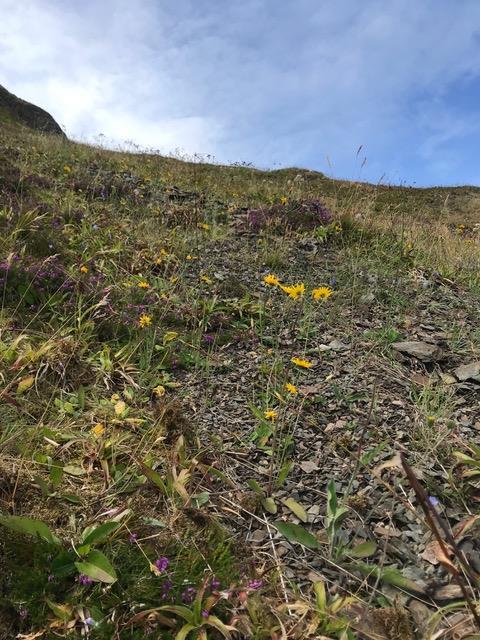
2022 County Report for VC96 Easterness
Andy Amphlett
8668 records have, so far, been added to the DDb for 2022, plus 3895 pre-2022 records, including historic, mostly pre-1950 records, missing from the DDb. Additional information was also added to records for which only summary information was available on the DDb.
In 2022 702 taxa were recorded in 36 hectads, 178 tetrads and 307 monads. 730 records of 112 RPR taxa were made. All records were at monad or better precision, with 84% at 100m precision or better. 32 recorders contributed records, but 8 people made 98% of the records, and 73% of the records were made by the VCR. All records have been verified and validated.
Recording mostly targeted locations with few or no previous records, and 61% of the taxon monad records were new. Detailed surveys of RPR taxa included Arctostaphylos alpinus (Alpine Bearberry) in the Monadhliath Mountains, using aerial photography to identify areas of likely habitat, and Diphasiastrum x issleri (Issler's Clubmoss) on Meall Tionail above Glen Feshie. 13 new taxa were recorded (12 aliens). 7 taxa were recorded for the first time post-1999.
A major paper was written and published in British & Irish Botany "A review of the vascular plant flora of the Cairngorms Connect project area, Scotland, and some possible implications of forest expansion to the natural tree line".
37
Cotula alpina (Alpine Cotula / Alpine Buttonweed) was found by Ian Green at Cawdor Castle. Found by Ian Green. Patch on gravel of car park and several patches in lawns. These are the first records for vc96 and the first Scottish records away from the NW Highlands, where it is well established in vc105, with one site in vc108.
Hypopitys monotropa (Yellow Bird'snest) was found by Calum McLennan and reported via iNaturalist. Refound, on the second attempt of searching, by Andy Amphlett and Gus Routledge. The first VC96 record since 1875. 125 fruiting stems at 6 locations within a single monad. Fred Rumsey confirmed that the plants were subsp.
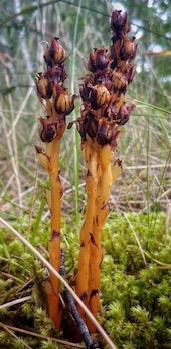
Nothofagus x dodecaphleps (Southern Beech) Single planted trees at two locations. First records for Scotland. ID confirmed by Cameron Crook. The hybrid between N. obliqua and N. alpina.
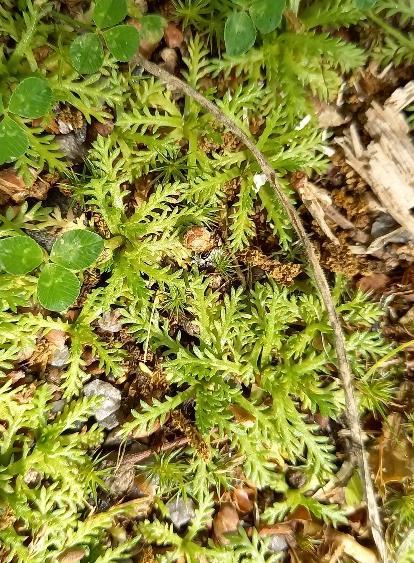
2022 County Report for VC97 Westerness Ian Strachan & Ian Bonner
In 2022 more than 11,400 records were made or received. The year’s activities included two very successful Field Meetings: Sithean Mor/Ardnish, near Arisaig, in June, and Corrour Estate in July. The first was a weekend meeting with 12 botanists taking part; our primary aim of finding Diapensia lapponica (Diapensia) was not met but many good plants were found in amazing weather (see report in 2023 Yearbook). At Corrour we had a full week in July courtesy of the Estate, following a similar event in 2009. 17 botanists participated for all or part of the week and collected more than 6,000 records, with many notable finds, such as the first site on the estate for Phleum alpinum (Alpine Cat’s-tail). Records were also made on a range of other sites across the county, and we are grateful to all contributors, notably Liz MacDonald, Jill Williams, Marion Moir and Jim McIntosh.
38
Informal botanical training was provided to Knoydart Estate rangers during a visit to Slochd a’ Mhogha. Advice was also provided to FLS staff, including joint monitoring of an important orchid population. Other key orchid sites were monitored during the year, and biannual recording of NPMS plots at Moy was carried out by IS for the 7th successive year.
A poster was presented at the Scottish Botanists Conference featuring some highlights from the year. A paper written jointly with Sarah Watts (lead author) and Richard Marriott was published in British & Irish Botany, describing two remarkable finds at Corrour in 2021 (see 2021 report).

2022 County Report for VC98 Main Argyll Gordon Rothero
Over 10,00 records were made in VC98 in 2022 which is a good total for a vice-county with few BSBI members and even fewer who supply records. Most of these records are due to the diligence of Carl Farmer and the Lorne Natural History group, Marion and Ian Moir and Jim McIntosh in the north and west of the county. There are few notable records in these lists but sites of Scheuchzeria palustris (Rannoch-rush) west of the A82 are worthy of mention.
Very enjoyable trips to the calcareous schist on Beinn an Dothaidh provided updates on species like Woodsia alpina (Alpine Woodsia), Micranthes nivalis (Alpine Saxifrage), Potentilla crantzii (Alpine Cinquefoil), Poa alpina (Alpine Meadow-grass), Carex atrata (Black Alpine-sedge), Juncus biglumis (Two-flowered Rush), Bartsia alpina (Alpine Bartsia), Cystopteris montana (Mountain Bladder-fern) and Veronica fruticans (Rock Speedwell).
A single plant of Epipactis helleborine (Broad-leaved Helleborine) cropped up on a wooded bank in Benmore Gardens; this is a rare plant in Argyll so its fate will be watched with interest. There was also confirmation that Zostera noltei (Dwarf Eelgrass) still occurs on the mudflats at the head of the Holy Loch; there would appear to be no other post2000 records of Zostera from any of the few sites in VC98. Less welcome was the discovery of a huge population of Lysichiton americanus (American Skunk-cabbage) at the head of the Dubh Loch in Glen Shira near Inverary.
39
2022 County Report for VC99 Dunbartonshire Michael Philip
We’ve been busy in Dunbartonshire in 2022! The network of field botany enthusiasts launched in 2021 continues to grow (currently 62 people on our contacts list). We held 20 field outings and several of our number have done recording on their own or in informal groupings. As a result, we have uploaded well over 19,000 records to the database this year.
Our project to achieve a fresh record at monad level for our entire vice-county in ten years is ahead of target: after our first two years we have re-found over 17,000 monad records and added over 19,000 new monad records - including records for 47 monads never previously recorded.
Highlights of the year have included Ceologlossum viride (Frog Orchid) and our first ever Ophrys apifera (Bee Orchid) - both growing on abandoned red blaes football pitches, but in different towns. Another urban first vice-county record was Herniaria glabra (Smooth Rupturewort).
One ‘niche’ element is seeking to repeat much of Allan Stirling’s record of Brambles from the 1980s and 90s. 349 monad records have been made, encompassing 23 species, including a first vice-county record for Rubus hylocharis. Work is underway on the first Rare Plant Register for Dunbartonshire: our next Annual Report will hopefully announce its completion.
Big thanks to many individuals who have led outings, tramped the pavements and waste ground, climbed the hills, squelched across damp moors and compiled lots of data and photographs. The learning and camaraderie have been marvellous - can’t wait to do it all again in 2023!
2022 County Report for VC100 Clyde Islands Angus Hannah & Sarah Cowan
This year Sarah Cowan agreed to become a joint recorder in Clyde Isles, a welcome move that should make things easier for both of us. Recording has gone well this year, with over ten thousand monad species records being made, not quite all yet in DDb. Sarah continued her monad recording in Arran, making over 6k records, and I undertook a project to refind as many as possible of the species seen on Bute over the last 20 years (see article elsewhere for details of this), visiting 140 monads, noting some gains and losses, seeing almost 800 species, making over 4k monad records and significantly updating the Bute RPR.
Otherwise my main focus was on brambles. In July I led a one-day introductory session as well as my usual long-weekend field and study meeting, both in Lochwinnoch (vc76), with 8 people attending one or both.
On Bute I also investigated some very robust sedges which resembled rostrata except for being well outside the usual dimensions (see my exhibit abstract). Mike Porter, to whom I sent several specimens, suggested they might be hybrids with riparia, but this could only be confirmed with fruits (empty utricles) and none of the plants flowered this year. We are both growing on specimens in hope of persuading them to oblige.
40
If they prove not to be hybrids, the textbook descriptions of rostrata may need some revision! They grow at several sites, and are unlikely to be restricted to Bute.
Crithmum maritimum (Rock Samphire) Found by Sarah near Blackwaterfoot on Arran. There are no previous vc100 records in DDb for this species, which may be extending northwards.

Brassica nigra (Black Mustard)
which turned up on Kilchattan beach was the first for Bute since James Robertson’s 1768 record.
Euphorbia paralias (Sea Spurge), growing nearby, was a first for Arran and only once seen on Bute 10 years ago.

2022 County Report for VC101 Kintyre
Dave & Pat Batty
It was a quiet year for recording as Dave was recovering from a hip operation. Two notable refinds were a large colony of Circaea alpina (Alpine Enchanter’s-nightshade), the first record since 1973, and Pyrola media (Intermediate Wintergreen), the first record since 1971. With the rare plant scheme some species, e.g., Carex magellanica (Tall Bogsedge),last seen 1990, and C. diandra (Lesser Tussock-sedge) were refound, but other species could not be relocated. The colony of Ophrys apifera (Bee Orchid) near Campbeltown had a good year with 200+ flowering spikes seen.
Pat had her 20+ year work on Cephalanthera longifolia (Narrow-leaved Helleborine) published in 2022.
Batty,P. (2022) Long-term study of the Sword-leaved Helleborine Cephalanthera longifolia (Orchidacea) in Knapdale Argyll. British & Irish Botany 4(2)
2022 County Report for VC102 South
Ebudes Simon Smart
Recording in 2022 centred largely on Islay and Colonsay. Annual orchid monitoring carried out by Malcolm Ogilvie on Islay showed that it was a poor flowering year, perhaps reflecting the dry spring. The colony of Spiranthes romanzoffiana (Irish Lady'stresses) discovered last year had just 5 flowering spikes (14 in 2021). The two regularly monitored sites of Platanthera chlorantha (Greater Butterfly-orchid) only had 56 (297 in 2021) and 16 (125) flowering spikes, and it was an equally poor year for P. bifolia (Lesser Butterfly-orchid).Slightly better were the 193 flowering spikes of Epipactis palustris (Marsh Helleborine) at their main site, only slightly down on the 218 in 2021.
41
On Colonsay, new sites were found for Botrychium lunaria (Moonwort), Carex limosa (Bog-sedge), Ophioglossum azoricum (Small Adder's-tongue),Sparganium natans (Least Bur-reed) and Gymnadenia borealis (Heath Fragrant-orchid).Recording was carried out by Pete Stroh, Angus Garbutt, Owen Mountford, David and Anita Pearman. David McNeill (VCR for Co. Antrim) also made some excellent records, including a new site for Ajuga pyramidalis (Pyramidal Bugle).
2022 County Report for VC103 Mid Ebudes Lynne Farrell
Two visits made in 2022, one to Mull in August and one to Coll in September. Concentrated on finding and recording rarer species, including updating those in the Rare Plant Register. Investigated possible new sites for species of interest with mixed success. Met with local helpers, renewing acquaintances and encouraging them, after not being able to visit for a while. Received records from both island residents and visitors. Made new contacts on both islands.
Advised workers from the Dew Centre for Moral Technology, a French-backed organisation, on site and species management at Torosay Castle estate. Joined in Tea & Cakes day at Dervaig, Mull, where they are growing native trees from locally sourced seed to re-establish some areas of woodland. Local school children are involved in the project.
Species of interest investigated include Spiranthes romanzoffiana (Irish Lady's-tresses), Gentianella campestris (Field Gentian), Asplenium ceterach (Rustyback), Draba incana (Hoary Whitlowgrass), Mertensia maritima (Oysterplant), Salsola kali (Prickly Saltwort), Suaeda maritima (Annual Sea-blite), Eriocaulon aquaticum (Pipewort), Linum radiola (Allseed), Lysimachia minima (Chaffweed), Persicaria hydropiper (Water-pepper), Calystegia sepium (Hedge Bindweed) and C. silvatica (Large Bindweed), Zostera marina (Eelgrass), and Pyrola media (Intermediate Wintergreen).
2022 County Report for VC104 North Ebudes Stephen Bungard & Joanna Walmisley
Over 6,600 records were added to the DDb including over 20 taxa new to VC104 and over 140 new hectad records. Nearly all of the new taxa were garden escapes or planted, the remainder being microspecies or hybrids. Recording for the Urban Flora of Scotland project was undertaken in Broadford, resulting in nearly 1,000 records from six monads.
Skye Botany Group meetings have concentrated on Scottish HectAd Rare Plant Project (SHARPP) targets and a two-part project with the Darwin Tree of Life project (DToL).
SHARPP successes included re-finding sites or finding new sites for Ribes spicatum (Downy Currant), Euphrasia heslop-harrisonii (an Eyebright), Atriplex praecox (Early Orache) and Zostera marina (Eelgrass). Additionally, some re-found plants on the SHARPP list for VC104 were of taxa whose nomenclature is in a state of flux e.g. Cochlearia officinalis subsp. scotica and Rhinanthus minor subsp. borealis, or whose actual taxonomic status is in question, e.g. Euphrasia arctica x marshallii
42
With help and funding for travel and a microscope and camera from DToL, the Group has been assessing Polypodium distribution and has successfully found several locations for Polypodium x mantoniae (Manton’s Polypody, the hybrid between P. interjectum and P. vulgare). JW produced a poster about this for the Scottish Botanists’ Conference. The second part of the DToL project concerned Ophioglossum. No new sites were found during this year’s surveys, but we supplied a specimen of O. azoricum for whole genome sequencing by DToL.
Eight Hieracium specimens were collected and sent for expert determination.
Astilbe rivularis Buch.-Ham. ex D.Don (River Astilbe)
Found on the roadside at Dunvegan by Joanna Walmisley – the first record for the British Isles on DDb. This is NOT Astilbe rivularis auct. non Buch.-Ham. Ex D.Don = A. chinensis (Maxim.) Franch. & Sav.) Probably escaped from Dunvegan Castle grounds.

Carex riparia (Greater Pond-sedge) Found near the shore and gardens in Broadford by Joanna Walmisley. Probably originally introduced.
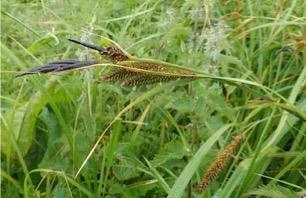
43
Pilosella caespitosa (Yellow Fox-and-cubs) Roadside, Broadford. Found by Stephen Bungard and Steve Terry.
Saxifraga umbrosa (Pyrenean Saxifrage) was found by Skye Botany Group in Sleat. The only previous record is probably an error for Saxifraga x urbium (Londonpride)

Taraxacum pseudohamatum (A Dandelion) was found in Portree by Seth Gibson
2022 County Report for VC105 West Ross & Cromarty Duncan Donald
Four field meetings were held in VC 105; we’ve all been glad to get out more during 2022! In June, we tackled Sgurr Dubh, Mullach Coire Mhic Fhearchair’s eastern spur –botanically rich but under-recorded through remoteness. Re-finds here included Alchemilla wichurae (Rock Lady's-mantle), Draba norvegica (Rock Whitlowgrass) and Poa glauca (Glaucous Meadow-grass); Festuca rubra subsp. arctica (a Red Fescue variant) was a new VC record. Some of us took the opportunity to visit Dactylorhiza incarnata subsp. cruenta (the very rare Early Marsh-orchid variant) nearby.
In July, members of the Inverness Botany Group joined me to search Cnoc na Creige/Cnoc Gorm on the Kishorn limestone, extolled by Slack and Stirling in their 1960s’ papers but not recorded recently. In passing we refound James Merryweather’s Equisetum hyemale (Rough Horsetail) site. Dryas octopetala (Mountain Avens) remains abundant; we saw some fine bushes of Salix mysinites (Whortle-leaved Willow); Melica nutans (Mountain Melick) too, seemingly incongruous on an open hillside, not the dripping gorge-side more usually its habitat hereabouts. We also refound Viburnum opulus (Guelder-rose) in the Allt na Criche gorge.
In early August an invited group met to survey the National Trust for Scotland’s Torridon estate, including a truly memorable day on Liathach: not just spectacular scenery, but (re-)finds of many significant plants – most notably Saxifraga cespitosa (Tufted Saxifrage); Saxifraga rivularis (Highland Saxifrage) for the first time since 1978; Cherleria sedoides (Cyphel) as a new record, and quite a lot of Poa flexuosa (Wavy Meadow-grass).
44
Also seen:
Luzula arcuata (Curved Woodrush);
My second BSBI excursion of 2022 was around Loch Maree. On another memorable day, we stepped back in time on the ethereal Loch Maree Islands – with pristine pine forest, abundant Aristavena setacea (Bog Hair-grass) and Lycopodiella inundata (Marsh Clubmoss), and not only the first sighting of Elatine hexandra (Sixstamened Waterwort) since 2001 but, growing beside it, Lythrum portula (Water-purslane), a new VC record. Luke Gaskell deserves special mention for resurveying most of the local sites for Sorbus rupicola (Rock Whitebeam). On the last day, joined by members of the British Pteridological Society we tried to relocate Dryopteris pseudodisjuncta (a Scaly Male-fern) at one of its initial [1986] British sites; sadly this proved elusive, though it has been refound near Stromeferry. Even so, finds included Dryopteris affinis subsp. paleaeceolobata (Narrow Scaly Male-fern) and Bracken variant Pteridium aquilinum subsp. fulvum [a new VC record]; and sites were visited for Rhynchospora fusca (Brown Beak-sedge) and Asplenium septentrionale (Forked Spleenwort).
I must also thank Andy Amphlett for conscientiously surveying multiple Cotula alpina (Alpine Buttonweed) sites across Coigach, and Nic Bullivant and James Merryweather for reporting locally rare Carex distans (Distant Sedge) and Juncus maritimus (Sea Rush) from the Plock of Kyle. However, this year’s ‘palm’ must undoubtedly go to Gus Routledge for finding a new site for Corallorhiza trifida (Coral-root Orchid), first/last reported from West Ross by Lightfoot and Pennant in 1772!

2022 County Report for VC106 East Ross & Cromarty Brian Ballinger & Mary Dean
Mary Dean was appointed joint recorder in 2022
Total number of records collected in Easter Ross in 2022 has been more than 6,400 entered so far. We are grateful to all the contributors Projects and Fieldwork. We led an all-day BSBI field meeting at Alness jointly with the Botanical Society of Scotland and Inverness Botany Group. BRB led recording field meetings in Dundee and Invergowrie jointly with the Dundee Naturalists’ Society and the Botanical Society of Scotland.
Talks (BRB): Tayside Recorders Day on "The Urban Flora Project". Scottish Botanists Conference in Edinburgh on “Vascular Epiphytes in Easter Ross”. Dundee Naturalists’ Society on “My Lockdown Year “.
45
Articles (BRB) (2022)
“Are there Wild Plants on Car Parks”. BSS News 118 25-26
“The Flora of Some Scottish Cemeteries” BSS News 118 13-17 (also SBC 2021)
“Urban and Rural Flora in Easter Ross part 3" BSS News 13-19 (also SBC 2021)
“Plants on Urban Walls -Do they Persist?” BSS News 119 17-19 (also SBC 2022)
BRB also contributes to the Dundee Naturalists’ Society Newsletter every fortnight, mainly on botanical topics. The Easter Ross Plant Checklist was updated in 2022.
2022 County Report for VC107 East Sutherland Mick Crawley
In 2022 a concerted effort was made to determine which of the daffodil cultivars were most frequent on banks and roadsides away from gardens in East Sutherland. It turns out that the list is very similar to that which would be found almost anywhere else in Great Britain, with the commonest taxa, in ranked order, Narcissus 'Ice Follies', N. 'Golden Harvest', N. 'Carlton', N. 'Princeps', N. x 'Tête-à-tête', N. 'Jetfire', N. 'Fortune', N. 'Dutch Master', N. 'Telamonius Plenus', N. 'February Gold', and N. 'Saint Keverne'.
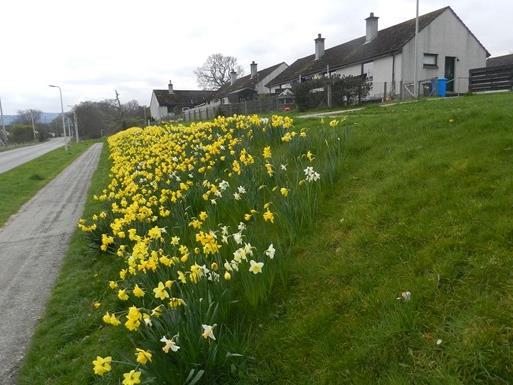
As in other parts of Scotland, Cortaderia richardii (Early Pampasgrass) is much more frequently naturalised than is C. selloana (Pampas-grass), and is recorded increasingly often in sand dunes, on roadsides and in open waste ground. The original colonists are clearly garden-escapees (see pic) but several self-replacing populations are turning up. Unlike C. selloana, the bisexual plants of C. richardii are self-compatible.
No new native plant species were
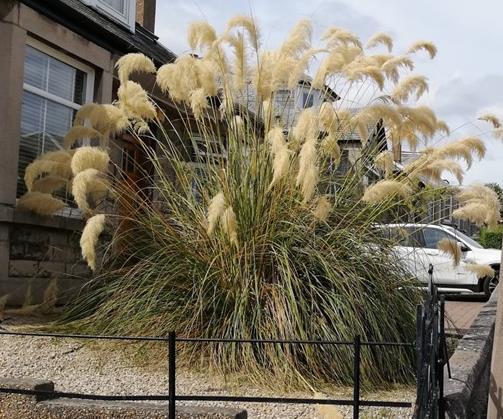
46
recorded in 2022, but the first record of Centaurea debeauxii (Slender Knapweed) for v.c. 107 was made at Drummuie (NH8198499645) in a verge sown with a wildflower mix (i.e. deliberately planted). All other records of C. nigra s.l. for East Sutherland are of C. nigra s.s. (Common Knapweed) which should be regarded as the only native taxon.
Erophila glabrescens (Glabrous Whitlowgrass) proved to be more frequent in 2022 than previous records had suggested. It had a very singular jizz, with its flowers held much closer to the ground than in E. verna (Common Whitlowgrass) and apple-green, shiny leaves.
2022 County Report for VC108 West Sutherland
Ian
M. Evans & Gwen Richards
Fieldwork during 2022 focussed on two areas. In Assynt, 21 monads on the John Muir Trust’s 3699ha Quinag estate generated 2200 records. For illustrated accounts of these visits see www.assyntwildlife.org.uk (under Quinag Wildlife Project).
Of particular interest were narrow bands of grassland and marshland along the 52km of watercourses on the hill, which have been overlooked in NVC and other surveys. Burns running off nearby limestone, for example, yielded two new sites for Carex paniculata (Greater Tussock-sedge), which is rare in North-West Scotland.

Fissured Torridonian sandstones at the edge of Loch Assynt produced Melica nutans (Mountain Melick) and base-rich stony flushes elsewhere on these rocks, marked by tussocks of Schoenus nigricans (Black Bog-rush), had Eriophorum latifolium (Broad-leaved Cottongrass), Pinguicula lusitanica (Pale Butterwort) and a variety of orchids.
We had two productive weeks in June and August on the north coast at Tongue, with Gordon Rothero and Ro Scott. These yielded some 2500 records from 23 monads.
We have started exploring wooded crags and gorges around Strabeg, at the southern end of Loch Eriboll (NC3951). Although mainly Lewisian gneiss, they have slivers of baserich Cambrian Fucoid Beds, accounting for species such as Carex capillaris (Hair Sedge), Galium sterneri (Limestone Bedstraw) and Silene acaulis (Moss Campion). There are also massive old examples of Corylus avellana (Hazel) in the woods. There is much more to do in this area. New to the vice-county were Crassula tillaea (Mossy Stonecrop) at Dalvraid (NC5663) and Sisyrinchium californicum (Yellow-eyed-grass) at Inverkirkaig (NC0719).
47
Strabeg, wooded crags from the north
2022 County Report for VC110 Outer Hebrides Paul Smith
A spring house party was based at Arivruaich, Lewis for two weeks, filling in some early species records (particularly Taraxacum) but also covering some unrecorded territory. Hypericum elodes turned up unexpectedly in Glen Uirn, about 15km from the nearest known locality. Permission from the Pairc estate led to some long walks along estate tracks, gaining a first record for Saxifraga stellaris east of Loch Seaforth, on Beinn Mhor. Another walk produced a second native location for Chrysosplenium oppositifolium, (Oppositeleaved Golden-saxifrage) the first since 1941, at Creag na Beirighe –common on the mainland, but a very rare native in the Outer Hebrides (also introduced in Stornoway Castle grounds).
A further roadside Carex maritima was discovered in central Lewis, considerably extending the ruderal halophyte populations. Several populations were visited in spring and summer as part of data gathering for a project on C. maritima.
A summer visit to Benbecula was productive, following up a report of Mertensia maritima (see below) and with records of Spiranthes romanzoffiana, Baldellia ranunculoides and Chara hispida in new localities. The main summer push was however on Great Bernera, which has not been recently recorded. There were several interesting aliens, including Levisticum officinale, Buddleja
davidii, and Escallonia
×langleyensis (in 2 places).
Interesting natives included Bolboschoenus maritimus, previously recorded here, but far from the next nearest locality, Arctostaphylos uva-ursi and Teucrium scorodonia. In an old road quarry with many weedy species on the nearby part of Lewis was a third vc locality for Juncus filiformis
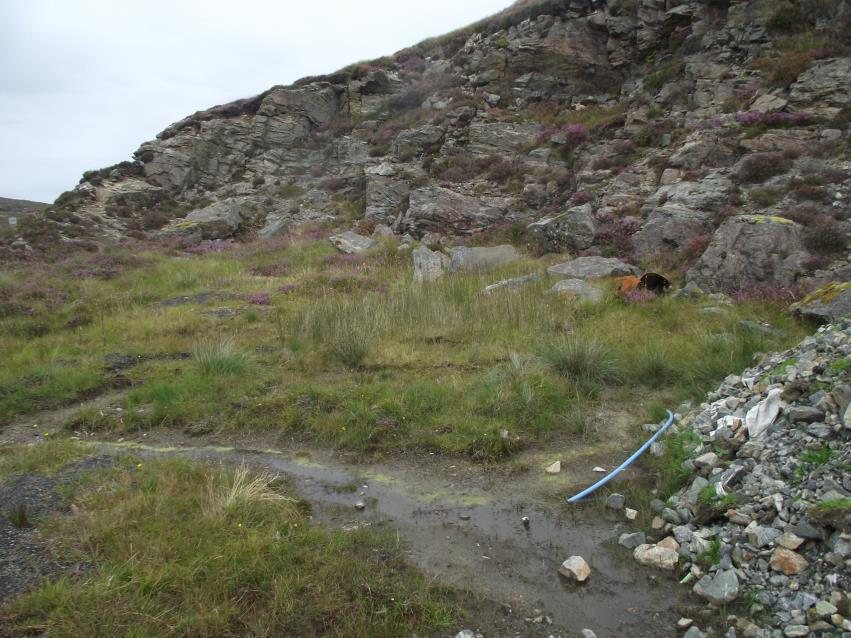
4000 records were added in 2022.

48
Steve Duff with Mertensia maritima (Oysterplant) reported in 2021, but only with details in 2022. Not seen in the vice-county since 1987, but also refound in a second site on Vatersay later in 2022, where there was a previous old record with no details.

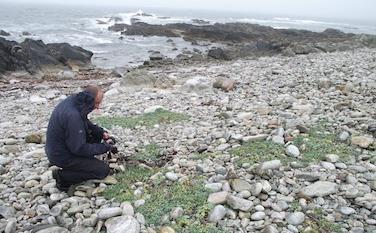
2022 County Report for VC111 Orkney John Crossley
Again this year the focus has been on projects and re-finding uncommon species rather than area recording. Dryas octopetala (Mountain Avens) is a rare plant here, with probably just five sites ever recorded, all in precipitous places on Hoy, so it was rewarding to re-find two of them (following one in 2021). Also on Hoy, several plants of the locally scarce Kalmia procumbens (Trailing Azalea) were found at a new site slope.
It was a good year for Pseudorchis albida (Small White Orchid), which reappeared at several sites where previously recorded but not for some years.
Eupatorium cannabinum (Hemp
Agrimony) is rare in the far north and hitherto known in Orkney from just one site, so a new site on Scapa Flow cliffs was a good find by naturalist Martin Gray.
Efforts continue to get to grips with Hieracium (Hawkweed) species, which have not been seriously tackled for around 100 years. Assistance from the referee, the ever-helpful Brian Burrow, remains indispensable! This year H. scoticum and H. subscoticum were found thriving on grassy cliffs in the Longhope area, with a little H. maritimum and what may be a new species.
I participated in a bio-blitz, gave a talk on plants and their habitats on the island of Egilsay, ran an outdoor workshop on grasses on Hoy and was involved in a short film about grasses with a poet and an artist/photographer, made for the 2022 Orkney Science Festival. The film can still be seen at https://oisf.org/fest-event/film-when-thegrass-dances/
49
The Botanical Renaissance – what's driving the younger generation's interest in plants?
Dr Louise Ross, SRUC
A casual glance around the room at the Scottish Botanists Conference these days reveals that although older age groups are still well-represented amongst attendees, a previously missing younger generation of botanists has evidently arrived on the scene. But what are the driving forces behind this phenomenon, and might the current younger generation save the science of botany from the brink of extinction?
The answers do not appear to come from within academia, where interest in studying plants has declined over recent decades. The numbers of plant-focussed students, degree courses and botany departments are declining globally1. And yet, we are in the midst of climate and biodiversity crises, where knowledge and understanding of plants, with all the processes and services they provide, will be central in mitigating the impacts of global change and restoring ecosystems. Plants and their products are everywhere we look, providing everything from food to fuel, medicine, vital ecosystem services, cultural values; they also provide habitats for animal life and, by general agreement, look beautiful while doing so! This type of cognitive dissonance has most recently been termed plant awareness disparity (PAD)2, believed to be rooted, at least in part, in the decline of interactions with nature – a feature of modern life for many.
To understand the driving forces behind the appearance of a younger generation of botanists, we need to look outside the scientific community. Over the last decade, there has been a revival of interest in plant-related hobbies and interests, including gardening, houseplant cultivation, plant-based diets, natural beauty and health products, and urban wildflower meadows3. The rise of “plantfluencers” and ”plantstagrammers” on social media has been particularly marked in the younger age groups, the Millennial and Gen Z generations born after 19813 .
Underlying these elements, however, appears to be a desire to connect with nature in a way that is meaningful and authentic, a reminder of what really matters beyond the flickering screens and distractions of the digital age. As a Society, providing young people with opportunities to observe, study and engage with botany as part of a welcoming and nurturing community is vital in harnessing the energy and enthusiasm behind the current plant renaissance. In this way, the view of plant sciences more broadly as a viable and desirable choice of career pathway, addressing the most important issues facing our planet, can be realised.
1Stroud, S. et al. The botanical education extinction and the fall of plant awareness. Ecol & Evol. 2022;12: e9019. 2Parsley, K.M. Plant awareness disparity: a case for renaming plant blindness. Plants, People, Planet. 2020;2:598–601. 3Burke, R. et al. (2022) Botanical boom: a new opportunity to promote the public appreciation of botany. Plants, People, Planet. 2022: 1-9.



50 FEATURES
News from Ben Lawers NNR 2022
Helen Cole, NTS
Ben Lawers National Nature Reserve (NNR) is owned and managed by the National Trust for Scotland to conserve its diverse flora. Monitoring of species and habitats is fundamental to the conservation of Ben Lawers and informs ongoing management. Most is carried out by a seasonal ecologist and in 2022 this post was funded by the People’s Postcode Lottery.
Repeat transects looking at Mountain Willow Salix arbuscula within and opposite the Creag an Lochain exclosure demonstrated that the species is stable within the fence but had declined a little on the open hill. In preparation for the introduction of a cattle grazing trial, additional fixed point vegetation quadrats were established on west Beinn Ghlas, to augment those created in 2021 in areas where soil samples had been taken. A soil survey carried out by a specialist contractor provided a baseline for future comparisons, although changes in composition are quite slow and difficult to detect.
Rare species monitoring included a full count of Drooping Saxifrage Saxifraga cernua
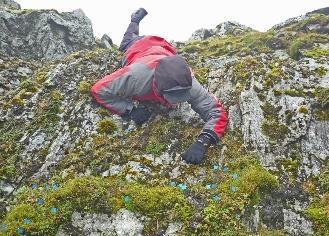
The last full population count in 2018 indicated a concerning decline, so selected populations had been checked in 2019 and 2021. The species reproduces by means of vegetative bulbils, and the 2022 counts recorded an increase in stems bearing these. In contrast, the numbers of leaves, used as a comparative measure as it is difficult to identify individual plants, had decreased since 2018.

Selected locations for of two of our other rarest plants, Snow Pearlwort Sagina nivalis and Mountain Sandwort Sabulina rubella, are now monitored annually following declining trends. As Ben Lawers holds most of the Scottish populations of both species, it is even more important to be aware of annual changes. Snow Pearlwort had declined at all the sites monitored (which represent the majority of the Ben Lawers population) whilst Mountain Sandwort had increased at some sites, but overall, there had been further decline.
Monitoring Mountain Sandwort Sabulina rubella
Analysis by former seasonal ecologist Sarah Watts (Watts et al, 2022) of 30 years monitoring of these species confirmed a declining trend during that period. The loss of populations from lower altitude locations suggests climate change is impacting these high-altitude species, but it is not clear exactly how. Long term annual monitoring of Alpine Gentian Gentiana nivalis quadrats demonstrates a similar declining trend over the same period. Again, reduced snow cover is suggested as a contributory factor, increasing competition from less specialist species such as graminoids. But to conserve these plants successfully, we need to find out how they are affected by various factors.
51
NTS
Following the 2020 census of Mountain Sandwort, seed was collected and sent to the Royal Botanic Garden Edinburgh (RBGE), but so far it has not been successfully germinated. Social media publicity about the declining populations of these rare species led to an approach from University of Dundee Botanic Gardens (UDBG), offering their expertise to create ex situ populations for study. It is hoped that seed collected (under permit from NatureScot) from Mountain Sandwort and Snow Pearlwort and bulbils from Drooping Saxifrage, now at UDBG, will facilitate this. With RBGE contributing the experience so far gained with attempts to germinate Mountain Sandwort, this exciting collaboration will also be supported by Stirling University.
A surprise find in heathland with Blaeberry, whilst showing a group of staff from NatureScot around the reserve, was Twinflower Linnea borealis, last recorded on Ben Lawers almost two hundred years ago. This nationally scarce plant is most often associated with pine woods although it can also grow in broadleaf woodland. It has suffered a national decline attributed to habitat fragmentation which has resulted in populations becoming isolated, effectively preventing insect pollination. Although it can grow vegetatively, this results in populations with little genetic diversity. A collaborative conservation project in the Cairngorms National Park, a stronghold for the species, is translocating plants with the aim of boosting seed production within populations. Material from the Ben Lawers population has been sent for genetic sequencing to see if there is a relationship to other populations.

Common Twayblade Neottia ovata was recorded on Meall Liath below Tarmachan. Although a relatively common species, the only previous record for the NNR was from ‘above Lochan na Lairige’ in 1959. It does occur at the head of Loch Tay, not far away as the crow flies. Another interesting record was of a strange looking orchid, which had the experts scratching their heads. According to an orchid expert at Kew Gardens it was not a rare hybrid, but an aberrant Early-purple Orchid Orchis mascula
Watts, S.H. et al: Riding the Elevator to Extinction: Disjunct Arctic-Alpine Plants of Open Habitats Decline as Their More Competitive Neighbours Expand. Biol. Conserv.272, 109620.

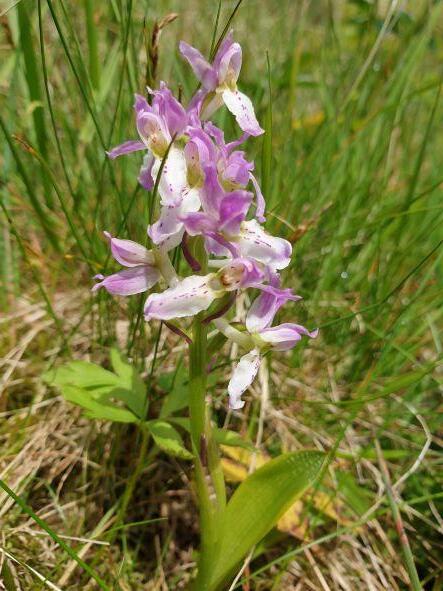

Altitudinal recording bias of Scottish plant records Andy Amphlett
After so many decades of botanical recording it is unsurprising that survey coverage of Scotland at the hectad scale is almost complete. Of 1121 hectads that include land above Mean Low Water Mark (MLWM), 99.3% have one or more vascular plant records. The
52
D. Watson
J. McGurk
exceptions are all coastal hectads, with between 0.02 and 4.57ha above MLWM. In some cases these only comprise wave-washed rocks and islets, difficult to access and possibly without vascular plants. Survey coverage at tetrad scale is also impressively extensive. Scotland contains 22,594 tetrads above MLWM, of which 88.8% have one or more records. Tetrads with zero records are found in all Scottish vice-counties.
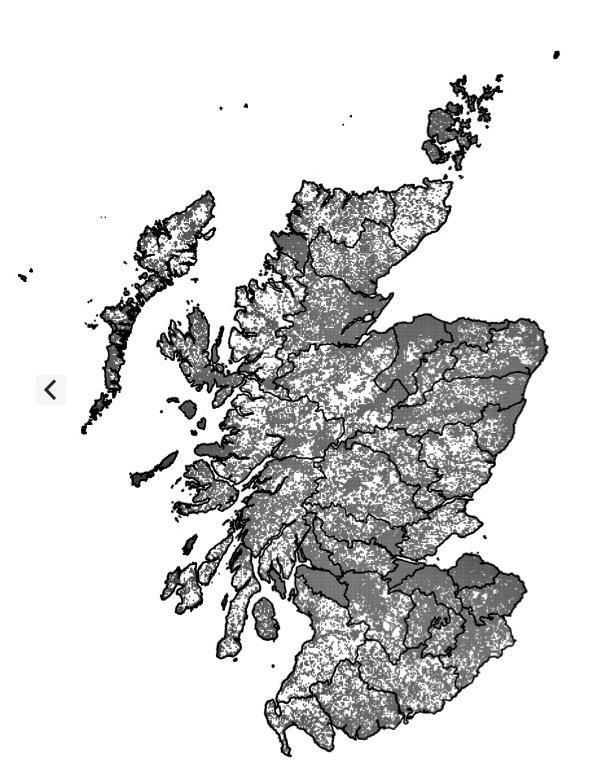
It is only at monad scale that survey coverage dips appreciably. There are 86,210 monads above MLWM in Scotland, of which 63.6% have one or more records (Figure 1). Monad scale coverage is not uniform. Some vice-counties have almost complete coverage, most have partial and patchy coverage, and there are some significant, contiguous gaps (the white "holes" on the map). The lack of uniformity in monad scale coverage while inevitable, should be kept in mind when considering mapped distributions and relative frequencies of taxa.
One potential source of bias relates to altitude. Does the percentage of monads with records vary according to altitude? If so, are there taxa that are particularly associated with under-recorded altitudes? The following analyses examine altitudinal recording bias for Scotland as a whole (excluding Shetland, v.c. 112) and in East Inverness-shire (v.c. 96). The BSBI Distribution Database (DDb) was used to calculate numbers of monads, their mean altitude, and the number of records in each monad. The digital elevation database that the DDb uses does not provide coverage of most of Shetland, so this vice-county had to be omitted from the Scotland analysis. Monads with less than 1ha above MLWM were also excluded. Recorded monads are those with one or more records. The number of records per monad excluded duplicates, any records where the grid reference was more than 1km from the vicecounty boundary, and if the record was tagged as 'do not map'. Only records that were validated or unchecked were counted. Records marked in the database as rejected, doubtful or needing to be checked were excluded.
The percentage of monads with records varies with altitude (Fig. 2). The majority of monads with mean altitude of zero, mainly inter-tidal flats, lack any records. The highest percentage of monads with records are at low and high altitudes, with monads at intermediate altitudes, c. 400-800m, less well covered. The recording bias is especially noticeable in v.c. 96.
53
Figure 1. Recorded monads, Scotland. (From BSBI DDb 23rd January 2023).
Percentage of monads with records in 50m altitudinal bands. Monads above 1000m are combined.
Species records, at monad or better precision, were assigned to 100m altitude bands, based on the mean altitude of the grid reference square. The 400800m band is roughly one third of the altitudinal range in Scotland. Therefore species with more than a third of recorded occurrences within that band, may be relatively under-recorded. In Scotland (excluding v.c. 112) 102 species, and in v.c. 96, 89 species (both excluding Hieracium and Taraxacum), have more than one third of recorded occurrences within that altitudinal band.
Table 1. Native species recorded from >250 monads in Scotland, with >50% of monad (or better precision) records between 400800m altitude.

To illustrate this, Table 1 lists the 24 species (all natives) recorded from more than 250 monads in Scotland, which have more than 50% of their monad or better precision records between 400-800m altitude. The combination of relatively widespread occurrence, and preferentially found at less well recorded altitudes, suggests these are under-recorded species. amphlett1958@gmail.com

54 Figure 2.
My 2022 recording project Angus Hannah
This year I set myself to refind as many as possible of the species I have recorded on Bute over the past 20 years for Flora or Atlas. Abandoning recording cards and clipboard, I got a small pocket notebook and wrote out a checklist of the species I thought there was some chance of seeing, with enough room to enter grid-ref and date for up to 10 records, since I aimed to find them all at least once in each of the Bute hectads where they grew. It was liberating to be no longer confined to a monad, seeking every species, but free to walk as far as I wished and spend as long as I liked on any interesting sites. And it was satisfying to refind plants I had not seen for a decade or more. I saw too what changes had occurred in the landscape, and in the frequency of different species, often striking, though possibly short-term.
The two previous springs had been seriously droughty. One victim was Carex caryophyllea, which I recorded only 3 times in the whole year, despite searching many of the 30 monads where I had known it. The thin coastal turf where it grows was burnt brown in both those springs, and the plants may have failed to survive. Even more remarkably, Carex pallescens, recorded in 39 monads for the Flora, was the last of the 34 island sedges to be refound when a dedicated search finally revealed a few specimens on 21 August. Many small flushes must have dried up, leaving its short rhizomes unable to reach water. Carex pilulifera too, which has short rhizomes and grows usually on betterdrained slopes, was much scarcer than expected, with only 5 records from its 94 Flora monads.
Among plants I failed to find at all were the club-mosses Lycopodium clavatum and Huperzia selago which grew mainly on the margins of forest tracks, where the open peaty habitat suited them well. In advance of clear-felling, the tracks had been ‘upgraded’ and the habitat destroyed. Elsewhere, Huperzia is a plant of flushed peat, and such areas had suffered severely from drought. Its small relative, Selaginella selaginoides, which likes the open banks of peaty flushes, was also much scarcer than usual, with only 5 records over the year from 53 Flora monads. Some marginal aquatics were hard to find because loch levels this year were consistently high. I had one sight each of Bidens tripartita, Elatine hexandra and Baldellia ranunculoides, but Eleocharis acicularis failed to show. Eleogiton fluitans, on the other hand, was more abundant than usual, partly as a result of water being restored to seasonal ponds where it seems able to survive drought years, possibly as a seed-bank. I recorded 8 Potamogeton species, but berchtoldii and obtusifolius eluded me.
A serious loss to Bute is Lathyrus linifolius, locally abundant 20 years ago on the rocky coastal pavement north of Dunagoil, but declining in recent years and which a thorough search failed to reveal, though it was some consolation to find Centaurium littorale (seaside centaury), an exceptionally pretty plant new to Bute. I feared that sheepsbit (Jasione montana) too, had been lost, but a search in late September revealed a small population on the Scalpsie dunes 80m from where I had last seen it in 2007.
55
Teesdalia nudicaulis (shepherd’s cress), however, seems to have gone from its only Bute site nearby, where I last saw it in 2010. Despite continuing abundance of Spergula arvensis, the variety of arable weeds continues to dwindle; I saw no Lamium amplexicaule, no fumitories other than muralis, and no Urtica urens, Sinapis arvensis or Glebionis segetum. On the other hand, some crops are more varied, a new farmer’s favourite sown among turnips being Linum usititatissimum, last recorded by Balfour in 1866. A single, splendid specimen of Brassica nigra turned up on Kilchattan beach, not recorded on Bute since 1768!
Matricaria chamomilla (scented mayweed) was locally abundant, and a more frequent arable weed than the scentless kind; it is perhaps more resistant to current herbicides. One species whose loss may invoke mixed feelings was giant hogweed, which appears to have succumbed to a vigorous campaign by the Estate. It had been spreading slowly on the foreshore from Mountstuart, and though causing no harm so far might have become a pest in future. Unfortunately, similar campaigns against rhododendron and Japanese knotweed have been pursued less rigorously and with limited success. Among the beneficiaries of the droughts and renewed rains, most striking perhaps was Radiola linoides, taking advantage of others’ misfortunes to colonise a coastal sheep track for about 500m, so that one walked on a carpet of it, a unique experience for me. However, it remains very limited in distribution, and was recorded in only 4 monads. Another small species colonising opportunistically was Vulpia bromoides, recorded in all 5 hectads. Two large perennial grasses that continue to increase are the coastal Leymus arenarius, spreading north and now in all 5 hectads, and Phragmites australis, often encroaching invasively into various sorts of wetland. The onward march of Typha latifolia continues; 30 years ago it was scarce on Bute, and unknown on Arran or Cumbrae.
I entered my records to Mapmate after each day’s recording, colour coding them in the notebook by hectad as I did so, which let me see at a glance where I had not yet found each species. A total of 7 hectads contain some Bute land, but in one case only a tiny area, while another in the far north west has only a few rough monads difficult of access and of no outstanding botanical interest. These two I omitted, thus focusing on five partial hectads.
56
Hectad Monads (entire + partial) Bute land area (km2) Monads visited Species found NS05 32 (14+18) 24 31 511 NS06 74 (42+32) 61 64 636 NS07 25 (13+12) 19 22 353 NS15 15 (4+11) 9 15 463 NS16 7 (0+7) 4 7 454 total 153 (73+80) 117 139 791
Table 1. Summary of results. A total of 254 species were seen in all 5 hectads, while 123 were found only in a single site.
By November, I had seen most of the species on my list, as well as some I had initially thought too unlikely, and about a dozen I had not recorded before, though not all new to the island. The project showed how much is missed in sampling monads, however thoroughly, since even in years when I made 10k records I never found more than 630 species in any one year. It also did much to update the Rare Plant Register, but more importantly (for me, anyway) it was great fun and provided a motivation to go out on every fine day (and some not so fine), sustaining the challenge through the year as succeeding months brought new target species into view.
An ancient woodland in Hoy, Orkney John Crossley
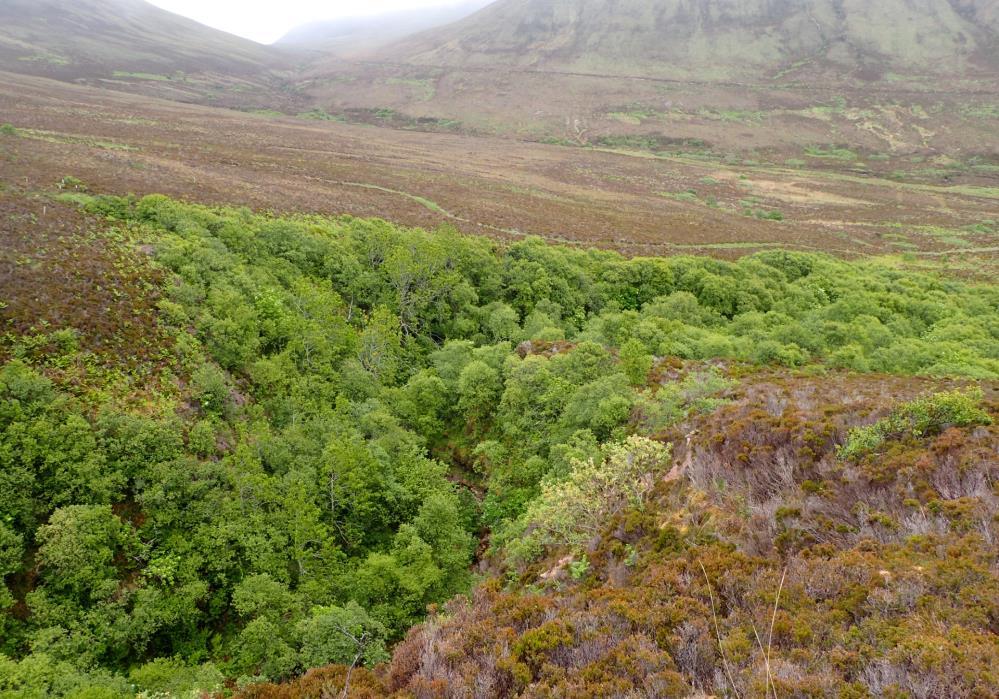
Britain’s most northerly native woodland at Berriedale, Hoy has long attracted naturalists and scientists, some of them renowned in their fields, to record and interpret its vascular plants, bryophytes, lichens, fungi and invertebrates. Some have studied the plant communities and their relations to climate, geology, soils, human impacts and vegetation cover since the last Ice Age. The wood is situated in the steep, glaciated hills of the northern part of Hoy, an area of c. 25 km2. It lies within the steep banks of the Berrie Dale gorge, where this loops around a high rocky spur of Grut Fea (211 m). It extends for about 300 metres along the gorge. The steep faces of the hill to south and west and the twisting course of the burn and gorge afford shelter from Atlantic winds and a shaded and humid atmosphere. Lower down, the enclosing banks fall away, and patchy tree cover continues for at least another 250 metres downstream. The most abundant tree is Downy Birch Betula pubescens, the main accompanying tree species throughout being Rowan Sorbus aucuparia. Aspen
Populus tremula occurs locally and there are just two Hazels Corylus avellana. It seems that hazelnuts rarely ripen in the cool northern summers. Grey Willow Salix cinerea is occasional in the gorge but frequent in the more open woodland below.
The woodland floor is mainly dominated by Greater Woodrush Luzula sylvatica, with frequent Bilberry Vaccinium myrtillus, initially giving a feeling of uniformity, leavened by much Honeysuckle Lonicera periclymenum and various ferns including epiphytic Polypody Polypodium vulgare. However, a great variety of other species is present, particularly on the steep banks. On the middle and lower parts of these and especially at
57
the foot where most earth has accumulated, the vegetation becomes progressively richer and more herbaceous, with Lady-fern Athyrium filix-femina, Male-fern Dryopteris filixmas, Borrer’s Scaly Male-fern D. borreri, Marsh Thistle Cirsium palustre, Primrose Primula vulgaris, Self-heal Prunella vulgaris, Meadow Buttercup Ranunculus acris, Devil’s-bit Scabious Succisa pratensis, Heath Violet Viola riviniana, Tufted Hair-grass Deschampsia cespitosa and others. These are indicative of mildly acidic soil. Indicative of more basic conditions are the sub-shrubs Northern Dog-rose Rosa vosagiaca and Stone Bramble Rubus saxatilis, and herbs including False Brome Brachypodium sylvaticum, Water Avens Geum rivale and Bush Vetch Vicia sepium. At the opposite end of the scale are several species of more acidic soils, including Bilberry, Hard-fern Blechnum spicant, Wood-sage Teucrium scorodonia and Hay-scented Buckler-fern Dryopteris aemula. Mosses are abundant on the trees and locally on the ground where they can find space amongst the Woodrush; they are mostly common oceanics such as Isothecium myosurioides and Dicranum majus and there is a fairly rich collection of more strongly oceanic liverworts, including Bazzania trilobata and Saccogyna viticulosa. Lichens of many species are also abundant, most noticeably Tree Lungwort Lobaria pulmonaria on Rowans and Willows.

I have visited Berriedale many times but not until recently with the intention of working out how it might fit into a broader perspective on Highland Birchwoods. In the National Vegetation Classification two distinct types of Birch-with-Oak woodland are recognised, W11 Quercus petraea-Betula pubescens-Oxalis acetosella (Sessile Oak-Downy BirchWood-sorrel) woodland and W17 Quercus petraea-Betula pubescens-Dicranum majus (Sessile Oak-Downy Birch-Greater Fork-moss) woodland, reflecting a major and longrecognised division in environmental conditions and associated flora. Both types have Sessile Oak Quercus petraea in most of their range, but further north Oak is confined to lower altitudes and eventually peters out altogether. There are no native Oaks in Orkney. W11 woodland, on soils that are base-poor but not markedly acidic, is typically grassy and moderately herb-rich; W17, on more acidic soils in areas of very high rainfall, is heathy rather than grassy, poorer in herbs, and has much Bilberry and a greater abundance of mosses and liverworts. The latter, W17, is the one most closely associated with Atlantic Rainforest.
Fellow NVC enthusiast and BSBI member Andrew Upton and I have recorded species associations in different parts of the wood. Mostly we thought we found elements of both W11 and W17, though parts of the lower ground are clearly too rich in vascular
58
plants for W17 – richer even than usual W11 it seemed – and other parts, especially a bouldery slope dominated by Bilberry on the north side of the gorge, conform better to W17. Some of the leafy liverworts characteristic of W17 occur, but not in profusion. These combinations and juxtapositions in the flora may be explained by the underlying environmental conditions pulling in different directions and a complete absence of grazing by domestic stock or deer.
The rocks are Upper Old Red Sandstone, an acidic type but not universally so: layers of more basic material occur within it and base-rich flushing is evident in many places in Hoy. The soil profile comprises a layer of acidic humus of uneven thickness almost covering mineral soil and gravelly material beneath, this originating from soil and rock washed down the steep sides of the gorge over millennia. Distinctions between the two NVC communities are further blurred by the overwhelming presence of Greater Woodrush, resulting from an absence of grazing. There are no deer in Orkney and sheep have been excluded from this area for at least 40 years. In deer- and sheep-grazed places Woodrush occurs abundantly only where these animals cannot reach, especially cliff ledges and islands, as has been observed along western coasts from Argyll to St Kilda. In Orkney it is very common on moorland throughout the isles. Bilberry is another plant susceptible to grazing and it too is very common in Berriedale.
The presence of Birch-Hazel scrub with a rich ground flora in the mid-Flandrian period, approximately 8000 to 5000 BP (Before Present, i.e. before 1950) in Orkney is well authenticated from the pollen record and archaeological evidence. Hazel was widespread and common. Pollen of Oak, Scots Pine Pinus sylvestris and Alder Alnus glutinosa in small quantities is assumed to have originated from trees growing on the Scottish mainland, although the specialists do not entirely agree on this. From what we know of more recent history it is surprising that there are any trees left at all. It is recorded that 2000-3000 sheep, and cattle, and even pigs were roaming the northern part of Hoy in the early 19th Century, and presumably this was a continuation of former practice. By the 20th Century livestock numbers were much reduced, to a few hundred sheep at most, and few were reaching Berriedale by 1950. In 1983 the wood became part of an RSPB Reserve and sheep were excluded altogether. Today the wood is in a mature state, with a more or less closed canopy. There are many Birch seedlings and young trees growing outside the wood’s boundaries in gaps in the heather, but apparently none within the wood. How will the wood develop in the future? Birch is a short-lived species, 80-100 years being an approximate maximum age (though one suspects that trees ‘coppiced’ by grazing or fire may live longer); furthermore, seedlings will not grow beneath or even close to mature Birch trees. Will it have to die back before regenerating?
Taxa in addition to vascular plants have been well recorded at Berriedale, with several lists published, though some apply to the entire 1 km square in which the wood is situated, thus including heath and bog habitats as well. Besides143 vascular plants, they include119 bryophytes, 75 lichens 62 of which are epiphytes, 151 fungi including microfungi, 94 butterflies and moths, 32 spiders, 21 beetles and 98 other invertebrates
59
belonging to 13 different orders. Birds known or presumed to breed are Blackbird, Chaffinch, Hooded Crow, Redpoll, Robin, Sedge Warbler, Songthrush (probably), Sparrowhawk, Willow Warbler and Wren
Can Berriedale claim a place as an outlier of the Atlantic temperate rainforest? Broadly it is consistent in character, with its humid microclimate, NVC Oak-Birch woodland communities and bryophyte flora. Derek Ratcliffe (who visited the wood in 1963) in his seminal 1968 study ‘An ecological account of Atlantic bryophytes in the British Isles’ found that Hoy is an outlier of the West Highland hyper-oceanic area, unique outside that area for supporting a distinctive group of liverworts. However, with no Oak trees and hardly any Hazel it is scarcely comparable with the ‘best’ rainforest sites of the west, such as the Oak-Birch woods by Lochs Linnhe and Sunart, or the Hazel scrub of the Firth of Lorne, Morvern and Skye. On the other hand, many western woodlands are damaged by grazing deer and sheep, or suffer from invasive Rhododendron, neither of which affects Berriedale, while the absence of grazing in Berriedale has allowed a richer flora of broad-leaved herbs than would be possible in most West Highland woods. Whatever comparisons may be made, this humid woodland is an extraordinary survival, having clung on through changing climate and great stresses when it may have been reduced to a fragment of what it is today.
This article is an edited version of one published in ‘Orkney Nature’, the bulletin of the Orkney Field Club, in 2022. The original included extensive references
Request for Cerastium fontanum
Cerastium fontanum has 3 subspecies, vulgare, holosteoides and scoticum. Generally they are recorded as C. fontanum s.l. Subspecies holosteoides has widely scattered records though confirmation is probably required for many. Subspecies scoticum is very rare in one location only. Other forms have been mentioned in the Plant Crib and Stace where they may have longer petals (such as W Sutherland (v.c.108) coast and others in the mountains being similar to ssp. scoticum.
I would welcome specimens of C. fontanum particularly montane forms and any such as the W Sutherland plants with longer petals. It would be useful to have fresh material with a bit of root . Other species would be welcome but they may be rare so would need permission to collect and probably only where an identification is problematic. If seeds could be collected it might be possible to grow them on.
Mike Wilcox michaelpw22@hotmail.com
60
PUZZLE PAGES PART 1 by Cruciada
CROSSWORD NO 7 ACROSS

1. Requisition taxonomic level (5)


4. Insurance document relating to grounds around big house (6)
8. Pastry crushed in sled rut (7)
9. Arctic species discovered in this region of Lombardy, for example, when pressure's off (5)
10. Thirteenth letter sent to French mother, short, had ancient grain (5)
11. Finish with 'em in charge of species only found here (7)
12. Everlasting flower appearing at heavenly gates? (6)
14. How herbarium specimen is prepared, we hear – with love, and quickly! (6)
17. Colloquially, Prunella, Stachys or Valeriana could fix everything (7)
19. Fringing hairs make more ridiculous sound (5)
21. Made notes about retiring fit (5)
22. Serpentine in use at resort (7)
23. Dug rose up without root to plant Cucurbits (6)
24. Spanish broom is more than half-hardy (5) DOWN
1. Boys start off to splatter around number of species with molluscan taste (12)
2. Domesticated 10 you noisily put in barrel (5)
3. Cheekier guy inhabiting disturbed ground (7)
4. Seen evenly distributed on head of plant sperm (6)
5. It stores energy in plant labellum inner diameter (5)
6. Musical – a musical reception for an Acorus species (7)
7. Without aspiration, can the treetop be developed as partially spreading? (6-6)
13. Be sick and almost to extremity – try tree at 12 gates? (7)
15. Grain cropped across the pond is source of castor oil (7)
16. What goatsbeard does at noon near sun (6)
18. First couple desert Viburnum for more senior tree (5)
20. Hunting goddess swaps lead with climber (5)
61
WORD SEARCH
When word searches first appeared, they didn't tell you what words to look for – now they almost always do. But that's for kids. This word search is for grown ups. For botanists, in fact. Your task is to find at least 38 words (it's just possible some extra ones have crept in inadvertently) which are ALL IN THE STACE 4th ed. GLOSSARY. There are quite a few other words that are in dictionaries, but if they aren't in the glossary in Stace 4, they don't count towards your 38. Words can read up or down, horizontally in either direction, and diagonally in any of four directions (but no knight's-move stuff).
The solution – the list of 38 words – is on page 76 If you get really stuck, I suppose you could look at the list and then go back to see if you can find the words you've missed. That's up to you and your spirit of competition . . .
See page 75 for the rest of the Puzzles plus Solutions.
62
P S C A R I O U S S A P A I E S A E O X N W A B I F I D N I H M P E N D N A L G F C E K G I Q U A P E R I A N T H C L Q S V R W B A Y N D O C R U O U P E D I C E L K E A J M M A T I I X N Z P B M R R E K B O R D N E G R A Y R A V E V E R I C I P W I C J U E T X C N E C A C S I D K A N T H E R T A L T E P T B N N R E C A D S X E A R I L A J O P P O S I T E L X A K K N L R O A E N O R I D O W E N G R O D L S L A X Y N N D G L A U C O U S P A W N I
LOCAL BOTANY GROUPS
Local Botany – pre-existing societies or new local groups?
Botanists, both amateur and professional, are encouraged to promote interest in and knowledge of the subject. This could be seen as part of the role of Vice-County Recorders. Although their primary task is in collecting and assessing data, some Recorders have set up local interest groups successfully, as have some other local botanists. In some places there are pre-existing natural history societies and the issue arises as to whether we should become more involved with them, or start a group that is specifically botanical. I suggest it depends on the local situation and perhaps to some extent the personality of the recorder.
As an amateur with a medical career behind me, I became VC recorder for VC106 (East Ross) in 2003, initially jointly with my late wife and being recently joined by Mary Dean as joint recorder. In the years prior to becoming a recorder I became actively involved in the work of several natural history societies. I was mainly based in Dundee at this time, as I still am.
These societies included the Scottish Wildlife Trust and the Dundee Naturalists’ Society. I later became local secretary in Dundee for the Botanical Society of Scotland (BSS) and am still a member of the BSS Council. My wife and I bought some woodland near Tain and a small flat nearby. Thus we joined the Inverness Botany Group, Tain field club, and Highland Biological Recording Group. We went on, and have sometimes led, field meetings and have given talks. We later became joint recorders for Easter Ross and it seemed natural to continue to work with other groups. I have also continued to do this in Dundee as BSS local Secretary and a Dundee Naturalists and Perthshire Society of Natural Science member.
Many natural history societies were established in the nineteenth century and traditionally botany has often been a major part of their work, with the participation of local botanists. More recently national societies such as the Scottish Wildlife Trust have set up local members centre networks, often involving botanical interest. There have also been locally based botanical societies More recently, social media groups have been formed, some attached to existing societies, and these also play an increasing part in promoting interest.
There are advantages and disadvantages to working with pre-existing local societies. More people are usually involved, there is usually a solid committee structure with a group of enthusiastic members, with a programme of indoor talks and activities in the winter months. Some are short of active committee members, often welcoming new members and likely to benefit from an increased botanical input.



63
Also, different species groups are often interdependent and it is good to avoid isolation. We all share an interest in nature conservation. For example, plant species are often very specific foodstuffs for the caterpillars of Lepidoptera. Informal interest groups or sometimes more formal groups may be present within these societies. A potential disadvantage of local natural history societies is that their focus can become too diffuse. The details of botanical identification can sometimes be submerged in more general interests.
So, my conclusion is that local activity is very important in promoting botanical interest and knowledge. A new local group may be the right answer in some places, but working in pre-existing groups may be the best plan in others and different approaches may suit different people.
Brian Ballinger brian@garrickwood.org.uk
Skye Botany Group
Skye Botany Group was formed in 2013 and so has just completed ten years of expeditions around Skye and Raasay. It is an entirely informal grouping with no officers or fees. Field meetings are arranged at short notice using Doodle to maximise the number of attendees. Membership has consistently been 20 to 25 with a slow turnover of members. The large majority of members live on Skye but a few stalwarts attend from farther afield. Typically, six to twelve folk turn out for each meeting. Our taxonomic reach is enlarged by the local bryophyte vice-county recorder being a long-term member of the Group.
Activities have concentrated on Atlas 2020 recording and the attempt to find old records that have not otherwise been refound. In the past couple of years recording in Broadford and Portree has been undertaken for the Urban Flora of Scotland project.
During 2022, Urban Flora recording in Broadford has been undertaken by individuals or pairs of members, whilst the main meetings have concentrated on Scottish HectAd Rare Plant Project (SHARPP) targets and a two-pronged project with the Darwin Tree of Life (DToL).

64
As is to be expected, the search for SHARPP targets has had mixed results, with some things not re-found for a variety of reasons. However, there has been success with others e.g. Ribes spicatum at two locations in north Skye, Euphrasia heslop-harrisonii at Broadford, Atriplex praecox from the Braes area and Zostera marina at Coral Beach. A third category of plants on the SHARPP list for VC104, consists of taxa whose nomenclature is in a state of flux e.g. Cochlearia officinalis subsp. scotica and Rhinanthus minor subsp. borealis, or whose actual taxonomic status is in question, e.g. Euphrasia arctica x marshallii. Some of these plants have been re-found in/near their previous locations but they are no longer what we thought they were, so whether we can say they have been re-found (even though they may have been), is debatable!
With help and funding for travel, and a microscope and camera from DToL, the Group has been assessing Polypodium distribution It has successfully found several locations for Polypodium x mantoniae (Manton’s Polypody, the hybrid between P. interjectum and P. vulgare). There appear to be no reliable morphological characters to separate this hybrid from its parents, both of which are present on Skye and Raasay, so the microscope has been essential for this activity. There were only two previous records of the hybrid in VC104, one on Rum that could not be confirmed during the Flora of Rum project and one near Struan on Skye. An attempt to re-find the latter for the DToL project failed.
The second prong of the DToL project concerned Ophioglossum. The principal objectives were to see if O. vulgatum could be found on Skye north of Portree and to seek more sites for O. azoricum Small Adder's-tongue. The latter is quite widespread on Raasay but only four sites are known on Skye of which three are on the north coast of Sleat. No new sites were found during this year’s surveys, but we supplied a specimen of O. azoricum for whole genome sequencing by DToL See report here.

Local botany networks in West Central Scotland
The familiar 'local group' concept within BSBI works well with people who know each other and who agree to go out botanising together from time to time. But joining such a group may seem like a big commitment to someone new to botany, or who hasn't met any of the others before.
65
Stephen Bungard & Joanna Walmisley Joint VCRs for vc 104 N. Ebudes
The big advantage of the 'loose network' is that when people sign up as interested they receive newsletters and communications regardless of how involved they choose to be in a practical sense. So, from first contact, they feel part of what's going on without any need to do anything more. We publish an extensive programme of outings and anyone in the network is welcome to drop in and out of this activity whenever they like. Some choose to be involved a lot, others just once in a while. It is this loose connection between a large number of people which produces all sorts of combinations of faces old and new on our outings, and in turn produces an increase in recording activity. Often, when someone attends an outing for the first time, they quickly want to come on another (or get a book, go on a workshop, send in photos for identification, etc.). From this larger pool of people, some are slowly drawn in and begin to develop skills and relationships which lead to greater confidence in the field.
Readers may be aware of the development of a new botany network in Lanarkshire (vc77) in recent years. At the start of the 2021 season, two similar new networks were launched - for Renfrewshire (vc76) and for Dunbartonshire (vc99) Each of these networks has its own character and priorities, but in every case there has been a sharp increase both in the number of people active in field botany and in the amount of recording which has resulted. The table below demonstrates this, showing the number of records gathered in the five years prior to the network launch and the first two years (in bold) of the network (fig.1).
With more groups covering more ground, more individuals leading more outings, and more suitably experienced people recording on their own or in ones and twos, it is not surprising to see an impact on the statistics. Even allowing for inevitable fluctuations, the average level of botanical activity under the ‘loose network model’ is of the order of three times the previous averages.
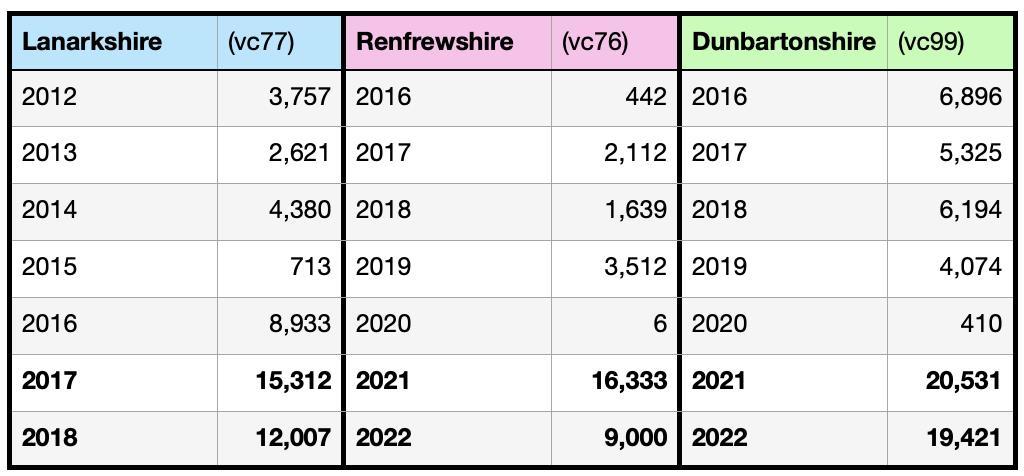
66
number of records gathered over a 7-year period (Renfrews 2022 approx)
Fig.1
In Lanarkshire the focus since 2017 has been on upgrading the record to monad scale (it having previously been largely at tetrad, or even quadrant, resolution). There are 2,468 monads in the vice-county, well over 800 of which are still unrecorded. This presents a huge challenge, especially since many of these are remote and generally uninteresting. However, experience shows that any area has the potential to produce surprises!
Another conscious emphasis has been on urban recording. Lanarkshire is the vice-county with the most widespread urban environments in Scotland and it is well understood that botanical diversity in urban areas is significantly greater than in the countryside. Malcolm Macneill's painstaking work within Glasgow and beyond continues to form the most detailed picture of this, but we have also allocated numerous outings to contribute to the Botanical Society of Scotland’s ‘Urban Flora Project’. This has included joint outings with the BSS at least once a year and many Lanarkshire towns are now represented in the Project, with further work ahead in 2023.
In Renfrewshire the priority has been to refresh the overall record. Keith Watson (VCR) did the core work for his 2013 Flora of the vice-county, but time marches on and the development of the new network makes it possible to widen and deepen the overall record as well as to revisit ‘good sites’ and check on some of the rarer plants.
Renfrewshire is small by comparison with Lanarkshire, with only 780 monads: but at the point where the new network got underway in 2021 there were still plenty either unrecorded or with only a small species list. It is a very varied vice-county, so fieldwork can range from cityscapes to coastal habitats, from rich woodlands and river valleys to remote high moorland. Again, there has been work for the Urban Flora Project (Paisley, Renfrew, Johnstone, Erskine, Linwood, Barrhead, Neilston, Greenock and Gourock - with Port Glasgow, Kilmacolm and Bridge of Weir in the plans for 2023).
Dunbartonshire is the smallest of the three networked vice-counties at just 704 monads. This has made it possible to launch an ambitious project to achieve a fresh record for the
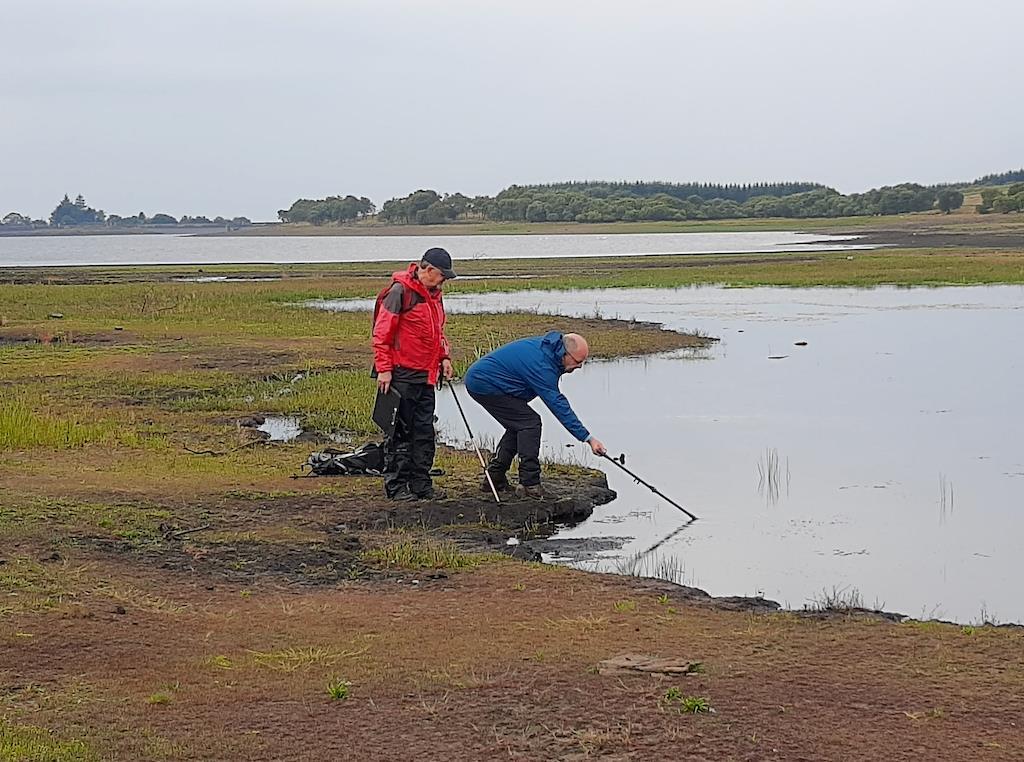
67
Michael Philip and Peter Wiggins (Joint VCRs) collecting aquatic specimens during unusually low water levels at Roughrigg Reservoir
[photo: Liz McTeague)
entire area across a ten-year span (2021-2030). This goal has motivated numerous people with an interest in plants to become involved, making this network especially dynamic. In the first two years 457 monads have been visited, 147 of which recorded in depth, including 47 never visited before. Over 17,000 existing records have been refound and, significantly, over 19,000 new monad records have been made. This is a remarkable achievement and deepens the overall record considerably. The ten-year project still seems achievable and is currently ahead of schedule.
Dunbartonshire is ‘Scotland in miniature’, with 3,000ft mountains, a major inland loch, lots of coastline, and large expanses of remote hillside and moorland. But it has its fair share of urban areas too, in which fieldwork has been contributed to the Urban Flora Project from Bearsden, Clydebank, Dumbarton, Alexandria, Helensburgh and Garelochhead
Discussing finds on an autumn outing along the shore of Loch Long [© Grahame Jarvis]
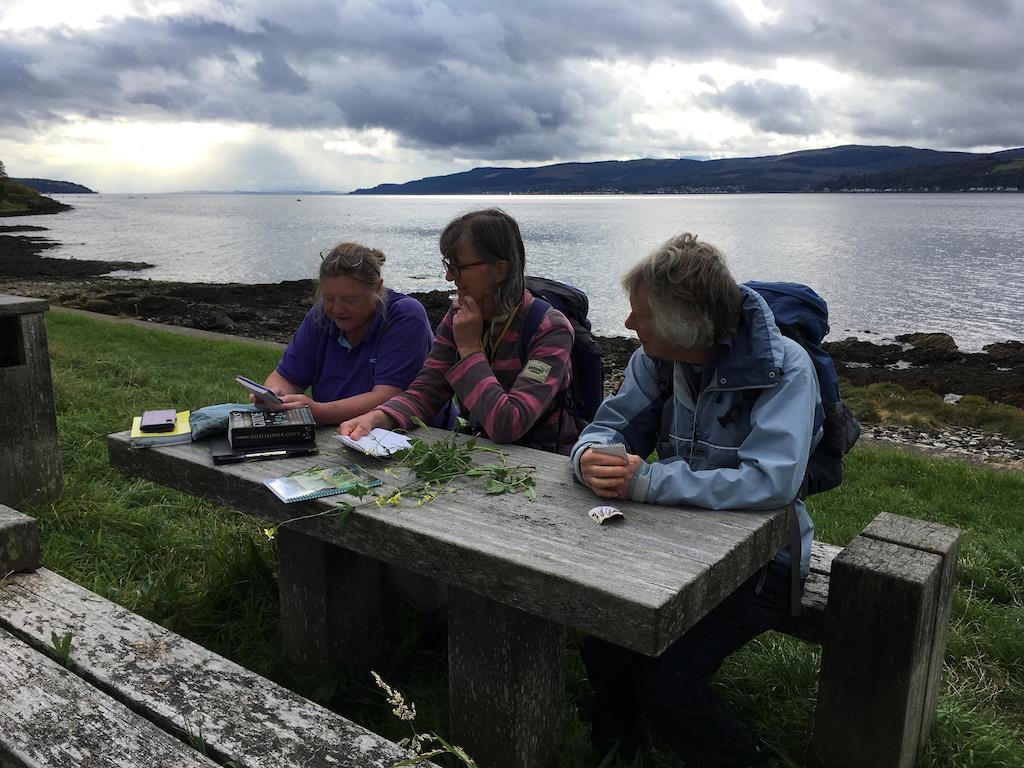
One aspect of the Dunbartonshire record offering a challenge to the current botanists is the in-depth recording of Bramble species by Allan Stirling in the 1980s and 90s. Thanks to Angus Hannah’s provision of Bramble Workshops and training, a good start has been made on this: 120 of the original records have been re-found and 220 new monad records added over the past two seasons.
Across the three local networks, 134 different people have so far joined the contacts list and many have taken part in fieldwork over the past two years. In 2022, 50 field outings were held and there has been a strong emphasis on learning and skills development, and during last winter we pioneered a series of Study Group meetings on Zoom in which participants from different networks could meet and share their plant knowledge. All this further strengthens our big team for the work ahead.
Particularly encouraging has been the emergence of several people who have been willing to lead outings, reducing the need for one of the three Vice-County Recorders to be present every time. The BSBI Grasses Workshop held at Chatelherault Country Park in June 2022 was staffed entirely by Lanarkshire network members.
It will be interesting to see whether the ‘loose network model’ enjoys similar success elsewhere. Readers of this Newsletter are warmly invited to visit us to take part in an outing and experience a sense how our networks operate - full details will be available
68
by the end of March on the respective county webpages on the BSBI website. All our past Newsletters can be read there too.
Michael Philip botany@opus44.co.uk
[Michael Philip is VCR for vc99 &Joint VCR with Peter Wiggins for vc77; Keith Watson is VCR for vc76.]
Inverness Botany Group
Inverness Botany Group (IBG) was founded in 1955 after the recently formed Committee for the Study of Scottish Flora (CSSF) arranged a series of talks and exhibitions in various venues, one of which was Inverness. A talk on “Plants of the Scottish Highlands”, illustrated with slides and specimens, in Inverness was attended by 130 people from a wide area. Evening classes in botany and lower plants such as mosses, ferns, fungi and seaweeds followed. Following these, six fortnightly evening meetings to discuss the local botany were held, and also some outdoor excursions.
The botany group then started with a programme of winter talks and summer excursions, which have continued until the present time, following roughly the same format. Our AGM is usually in October, and we have a monthly talk from November to March. The talks are mostly botanical in nature, but we do cover other subjects as well.
We have around 10 single day excursions during spring and summer and always have a “weekend away”, where some members of the group will travel a bit further outside our area to somewhere of botanical interest and stay for 3 or 4 nights, or up to a week, depending on the distance travelled and accommodation. As well as a variety of places in mainland Scotland, these have ranged from Teesdale in England, The Burren in Ireland and a few of the islands off the west coast of Scotland, Coll, Tiree, Muck and Colonsay, with a planned visit to North Uist in 2023.

The group has had to adapt over time to changes in technology, the most recent being the steep learning curve to hold our winter meetings on the zoom platform due to covid in 2020 and 2021. Most of our talks this winter will be held on zoom, but our annual joint meeting with the BSS will be face to face and we’re trying a hybrid AGM, mostly face to face, but some people will be joining byZoom if all goes well.
We publish a newsletter, “News & Notes”, about 4 times a year which has reports on our talks and outings as well as other biological snippets, this has been digital since 2010 We have a website, https://www.invernessbotanygroup.com which has a list of upcoming talks and excursions, as well as copies of all of our previous digital newsletters. If you’d like to join the group, there is a form on the website or you can contact me at unicorn64@btinternet.com. Audrey
Turner
69
East Lothian (vc82) Botany Group
After working out the monads with no records and marking them on my phone Memory Map with a blue flag, and monads with less than ten records with a yellow flag, we concentrated on these through the Spring moving eastwards through the county. Spring plants such as Petasites fragrans (Winter Heliotrope), Myosotis ramossissima (Early Forgetmenot) and Viola odorata (Sweet Violet) were particularly targeted. On a walk down the Colstoun Water, we refound quantities of Petasites albus (White Butterbur), and an unusual plant Trachystemon orientalis (Abraham, Isaac and Joseph) which has naturalised down this river.
Michael Williams, owner of Eaglescairnie farm near Gifford, asked the Botany Group to come and record around his farm, as he takes a keen interest in natural history. There is a regular group who visit to record the birds, and Michael has brought in students to practise the layering of hedges. A small group of us made visits in the Spring and Summer. The Ladies Tresses which grow nearby are just outside his farm but the damage caused by storm Arwen with fallen trees had not affected them. He felt that the layered hedges and the mixed planting of trees had been beneficial to the farm’s biodiversity.
At the end of July, a group visit was made to Papple Steading near Whittinghame. Sue Jury undertook to lead this visit, as an operation on my foot kept me away from recording for the rest of the Summer. The aim of the visit was to learn about the exotic trees that grow in the Whittinghame woods. To add to the interest, George Mackintosh is developing Papple Steading into an East Lothian agricultural museum and went out of his way to welcome the group and show them around the buildings and the wildflower meadow, ending up with a welcome tea.
This is my opportunity to thank Sue Jury for all her hard work in helping the recording in VC82; she has now become Recorder for VC83, and we shall work closely together. For 2023 we are planning some shared walks between the two counties. Some records are listed with photos for the digital version.
Marion Moir
Kirkcudbrightshire Botany Group (KBG)
Initially suggested in 2013 by another BSBI member here, I was finally persuaded –somewhat reluctantly I admit – to set up a group in 2014, expecting 5 or 6 at most. However, at the first field meeting April 16 botanists turned up and it’s been thriving ever since. At the latest count there are 52 participants, not all active but certainly interested. We started off with one meeting a month, 9 in the first year, and now
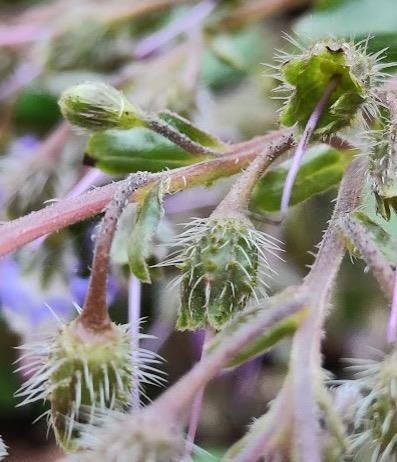
70
regularly hold around 15, roughly every fortnight. Each has a specific purpose depending on what needs doing, what species or habitat we would like to see, the best sites, and those previously unvisited or with very few records over the 3 Atlas periods; plus training days (grasses; sedges; rushes; ferns, as requested). The aim however is to combine this with enjoyment and learning about plants.
Organising and running the meetings has been a labour of love - a team is gradually forming with designated photographers, card recorders and subsequently data entry people, to help with the administrative side. A few dedicated individuals tackle monads local to them each year. In all, we produce around 5000 records annually. To maintain support and encourage interest, all members are circulated with field meeting reports and, during Covid lockdown, with monthly Newsletters about items of interest – recent finds, identification sheets and links to other similar or useful sites.
We’ve been involved with TPP, SHARPP, NYPH, site monitoring, advising bodies (like RSPB, SWT, NTS, MOD), landowners, and private individuals wishing to enhance their environment. We’re monitoring several rarer species, notably Meum athamanticum, 2 Zostera spp., Silene viscaria, Ophyris apifera, Carex elongata, C. punctata, Thelypteris palustris, etc. – one or two with population data going back to 1947! There have been many NCRs since 2014, unexpectedly including Pimpinella major, Echinocloa crus-galli, Spirodela polyrhiza, Spiranthes romanzoffiana, Filipendula vulgaris, Imperatoria obstruthium, Stellaria neglecta and a host of aliens.
And significant re-finds of old records, mostly last seen pre-1900 - Sedum villosum (under threat from forestry), Epipactis helleborine, Neottia nidus-avis Birdsnest Orchid (© David Hawker), Ranunculus sardous, Datura stramonium, Sempervivum rupestris, Persicaria vivipara, Oxyria digyna –this last a 1935 record hinted at by John Raven in the New Naturalist “Mountain Flowers” but without definite details and not officially accepted, and Althaea officinalis (probably at its original recorded site in 1883).
Despite being a botanical group, the expertise ranges through lichens, fungi, aquatic invertebrates, various insect groups, birds and so on; these records usually find their way to the South West Scotland Environmental Information Centre. Some of our good plant sites have also been excellent for rediscovered or newly discovered (NCRs) species of rare or scarce aquatic invertebrates and spiders.

71
There’s still lots to do in the coming years . . . and plenty of interested people to do this.
David Hawker Recorder for VC 73
Field meeting, Almorness PeninsulaPalnackie, Aug 2021 ©Lee Paton
Dumfriesshire Botany Group at Langholm, 17 July 2022

On a fine day ten off us met at the cemetery and walked across Skippers bridge to access two squares on the SW slopes of Whitta Hill. This is now mostly within the Tarras Nature Reserve owned by the community and so the survey results will be passed to the reserve team as part of helping them build up an understanding of what they have. The two squares included land within and outside the reserve and these areas were recorded separately. They had a combination of wooded riverside, woodland on the lower slopes and along the old railway and open hill with bracken and scrub higher up. Some flushed areas supported richer grassland otherwise the slope has a heathy vegetation.
The wooded areas, a mix of deciduous and conifer species are not particularly rich suggesting that they are relatively recent in development and supplemented by planting. A few plants like Wood-sedge Carex sylvatica,Remote Remote Sedge Carex remota and Hairy-brome Bromopsis ramosa suggest that there might have been remnant older wooded sections and below the minor road the wooded riverside is more natural.
Once on the open ground the acid nature of the slope was evident with a mosaic of bracken and heath. In the more open areas heathy species like Wood Sage Teucrium scordonia, Heather Calluna vulgaris, Bell Heather Erica cinerea and Velvet Bent Agrostis canina sl. were dominant. In some of the shorter vegetation we found not only Sheep’s-fescue Festuca ovina and Heath Grass Danthonia decumbens but also the very needle leaved Fine-leaved Sheep’s-fescue Festuca filiformis. This probably gets overlooked in this kind of habitat but is worth looking for. Compared to Sheep’s Fescue its flower parts are smaller and lack awns but in the field the very fine long leaves are the first thing to spot.
There were places where water seepage brought more neutral conditions and these were shown up by the presence of species like Marsh Thistle Cirsium palustre and Burnetsaxifrage Pimpinella saxifraga. These had patches of Wild Thyme Thymus drucei and species like Marsh Arrow Grass Triglochin palustre and Flea Sedge Carex pulicaris. It was around the margins of these damper areas that Carol was the first to spot Adderstongue Ophioglossum vulgatum (© Sarah White). This is a little fern with a single fleshy diamond shaped sterile leaf blade generally 5 to 15cm and a narrow fertile blade eventually longer than the sterile leaf, carrying a spike with sporangia (the adder’s
72
tongue). It is recorded as having the highest number of chromosomes in any British plant (500-550).
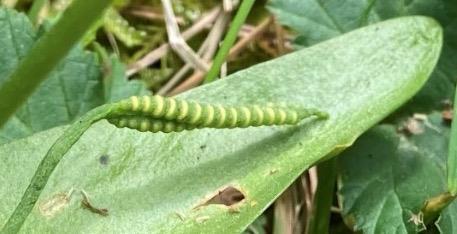
Until this year this was thought to be a rare plant in Dumfriesshire but this population is now the seventh new population found this year. Three of these have been in the hills around Langholm. Previous to this year it was last recorded in the Langholm area in the nineteenth century so it is great to find that it has survived unrecorded over 150 years. There were several places where we found it in the first square so there is a good population on this slope and a chance for it to be found elsewhere. Like Moonwort, Adder’s Tongue is indicative of an unploughed and unfertilized old grassland.
The southern square that we looked at had a similar range of species though as much less of this is open heath we did not find Ophioglossum. There were some good sized oak trees in Long Wood itself and markers had been placed by young seedlings which look set to be used to extend tree planting on the reserve.
Chris Miles VCR Dumfriesshire VC73 – bsbi.org/dumfriesshire
Strathtay Botany Group
Early in 2022 there seemed to be a demand for a local botany group among people who appreciated the local flora without having much knowledge or expertise in botany. So this group is not – or, at any rate, not yet! – a recording group. It doesn't have an advance programme, there is no committee or constitution and no website. We operate through a WhatsApp group on which people post interesting finds, ID queries, and general botanical questions. Of the current 17 members, three are (or were) VCRs, several are novices, the rest of us in between.
Also posted on WhatsApp are suggestions for meeting up at a nearby place on a nearby date. These informal meetings can take any form, and we began on 1st April with a visit to Weem Meadow SSSI, a traditional hay meadow by the Tay in Aberfeldy. We were chiefly monitoring the state of Yellow Star of Bethlehem Gagea lutea because there had been concerns about the grazing management after a change of ownership of the site. However, the Gagea was in fine form – indeed, in places we could hardly move a pace without trampling some!
73
Several members joined the BSBI Training meetings at the Tummel Shingle and Ben Lawers and we met in Glen Fender in July to look at orchids, finding five out of the ten orchid species recorded here. In August, one of our least experienced members posted a rather distant shot of a plant that she said was abundant in a piece of forestry waste ground, and suggested it might be Common Centaury Centaurium erythraea. It looked possible – but in that habitat? But it was so: we counted at least 100 plants absolutely carpeting an area of c.100sqm. This was used for turning by forestry vehicles, so presumably it was brought in on their wheels and, finding no competition, simply took over the ground.
 Faith Anstey
Faith Anstey
Angus Hannah's bramble group
Since the first meeting in Bute in 2017 a small, evolving group has met for a weekend workshop in succeeding years in Glencoe, Hamilton, Kirkcudbright, Helensburgh and Lochwinnoch. This year we also held a one-day meeting for beginners in brambles, and this may be repeated if there is interest. Numbers have to be limited, but anyone with an enthusiasm for brambles is invited to book early. We are planning to hold next year's meeting(s) in Maybole.
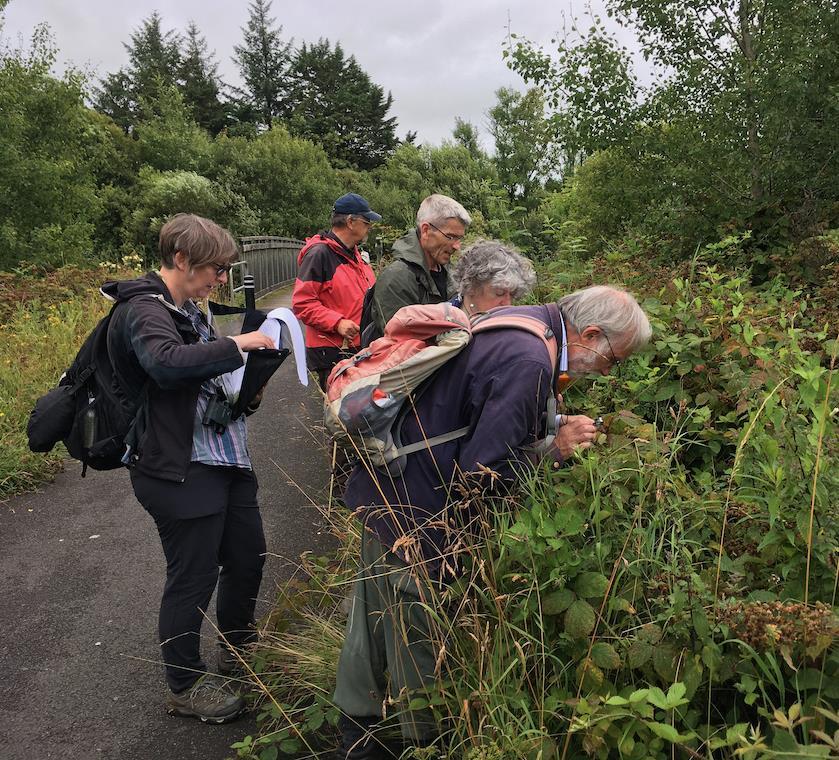
Moray botany group
I started the Moray Botany Group in 2009. The aim of the group is to get more local botanists to know the whereabouts of the rare and interesting species found in Moray. A number of field meetings are held each year, with an email sent out about a week before the meeting with details of meeting place, species we are going to look for etc.
Ian Green igreen67@aol.co.uk
74
In the photo are (from foreground to background): Angus Hannah (VCR, Clyde Islands), Carol Crawford (Joint VCR, Ayrshire), Keith Watson (VCR, Renfrewshire), Michael Philip (VCR, Dunbartonshire and Joint VCR, Lanarkshire), supported by Anne Middleton (Northumbria) who is keeping us all on track using Angus's new Key.
ERUDITE EPITHETS
PUZZLE PAGES Part 2
Even if you haven't got what used to be called 'the benefit of a classical education' it can be useful and entertaining to know the literal meanings of the epithets used in scientific names. Here are some descriptions of leaf characters – can you match them up with their vernacular meanings?
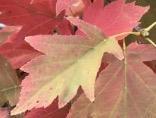




aculeatus awl-shaped caudatus kidney-shaped
ceraceus with a long tail cernuus gnawed-looking
corniculatus prickly erosus polished
incanus hoary laevigatus bellying
lanatus waxy nutans whorled


pruinosus horned reniformis one-sided
secondus nodding subulatus drooping



ventricosus woolly verticillatus frosted
SEEING THE WOOD FOR THE TREES
As you can see, these are all pictures of leaves from trees. What's the quiz? Well, you have to work that out yourself! But if you can identify all the trees (vernacular names) you may find you have come up with an eponymous tree.
75
1 2 3 4 5 6 7
PUZZLE SOLUTIONS
SOLUTION TO CROSSWORD No. 7
Across 1. ORDER 4. POLICY 8. STRUDEL 9. POLAR 10.
EMMER 11. ENDEMIC 12. PEARLY
14. PRESTO 17. ALLHEAL 19. CILIA 21. TONED 22. SINUATE 23. GOURDS 24. SPART
Down 1. OYSTERPLANTS 2. DURUM 3. RUDERAL 4. POLLEN 5. LIPID 6. CALAMUS
7. ERECTO-PATENT 13. AILANTO 15. RICINUS 16. CLOSES 18. ELDER 20. LIANA
CRIB
Across 1. double definition 4. dd 8. anagram SLED RUT 9. PO(P)LAR 10. EM/MER(E)
11. END/EM/IC 12. Pearly Everlasting/Pearly Gates 14. pressed/O 17. charade 19. sillier 21. reversed in maDE NOTes 22. anag IN USE AT 23. anag DUG ROSE 24. SPART(AN)
Down 1. (B)OYS/ anag SPLATTER round N 2. D<U>RUM 3. RUDER/AL 4. POLL/sEeN
5. LIP/ID 6. musiCAL A MUSical 7. anag CANT(H)ETREETOP 13. AIL/AN'/TO (Tree of Heaven)
15. RICe/IN/US 16. CLOSE/S 18. (GU)ELDER 20 D*IANA
WORD SEARCH
ACHENE, ANTHER, ARIL, AXIL, AWN, BIFID, BLADE, CARPEL, CONE, CYME, CORONA, DISTAL, DRUPE, DECUMBENT, DISC, ERECT, GLAUCOUS, GLUME, GLAND, HAIRY, HISPID, KEEL, LAX, NAKED, OPPOSITE, PANICLE, PALMATE, PEDICEL, PERIANTH, RAY, SCARIOUS, SINUS, SPIKE, TAXON, TEPAL, UTRICLE, VEIN, WING
ERUDITE EPITHETS
aculeatus – prickly, caudatus – with a long tail, ceraceus – waxy, cernuus – drooping, corniculatus – horned, erosus – gnawed-looking, incanus – hoary, laevigatus – polished, lanatus – woolly, nutans – nodding, pruinosus – frosted, reniformis – kidney-shaped, secondus – one-sided, subulatus – awl-shaped, verticillatus – whorled, ventricosus – bellying.
TREE QUIZ
Rearranged, the vernacular names of the trees give you
Dogwood (7)
Oak (4)
Umbrella tree (2)
Ginkgo (6)
Larch (5)
Aspen (1)
Service tree (3)



76
ALISTAIR GODFREY 1954 – 2022
Alistair Godfrey had been VC recorder for Mid Perthshire since 2003 when, after a long illness, he sadly died on 7 December 2022.
I knew Alistair since about the year 2000 when he become chair of the PSNS Botanical Section. He also served time on the BSBI Scottish Committee and had been VCR for Mid Perth since 2003. Over the years he led very many field excursions, a number of which were dedicated to introducing newcomers to the delights of botany. It was always fun to go botanising with him and frequently gave me new insights into how to identify even the commonest of species. He was a brilliant botanist with an eye for unusual and rare plants, willing to tackle the most difficult plant groups – dandelions, brambles, and particularly roses.
He should also be remembered for his outstanding conservation survey work. He used his professional planning expertise in meticulous research to object to damaging planning applications. His submission was key to getting the Glen Quey Quarry application refused by the Scottish government: he proved the Moss was a perched raised bog in recovery, an exceptional habitat, described as ‘impoverished pasture’ in the official EIA. He also fought hard to stop the Ochil Hills being blanketed in Sitka Spruce. He fought tirelessly for the preservation of sensitive, priority habitats.

Alistair


in Glen Lyon in 2018 © Tim Rich
He knew his vice-county Mid Perth intimately and had an enviable mixture of focus and gentle charm. He was also a right minded person who believed in fairness and justice for all. I feel very privileged to have been his friend.
Liz Lavery VCR West Perthshire
I think one important thing Alistair deserves recognition for is his investigations of the historical ecology of local woodlands, particularly his 2018 Study of the Woods and Wetlands at Bertha Park, Redgorton – at 176 pages, far more in-depth, better informed and interesting than the brief and superficial report produced by the consultants paid by the developers for the same area. Around the same time, he also produced a shorter study of one of the woodlands on the outskirts of Scone, Reports of his studies of two woodlands near Methven and Den of Methven were the last of numerous articles he wrote for the PSNS Bulletins, which are all available to download from the PSNS
Publications page www.psns.org.uk/psns-history.
Colin McLeod
77
OBITUARY




78
Jim McIntosh hosting the Shetland Recording Week in 2018
Alistair Godfrey and party at the Devil's Elbow in 2011 see page 47
PHOTO
GALLERY
Sedum villosum , Kirkcudbrightshire ©Jan Davidson
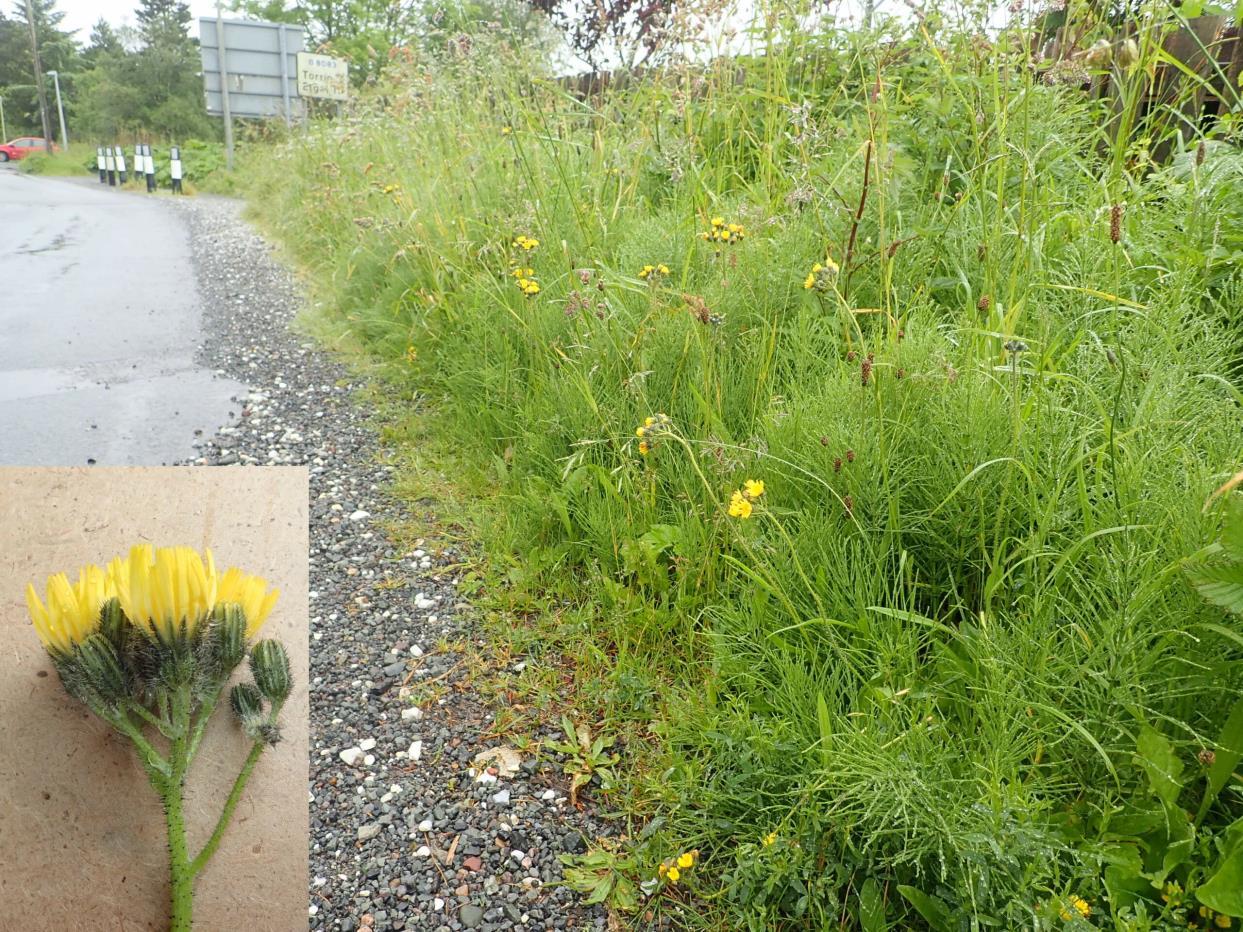
– see page 43
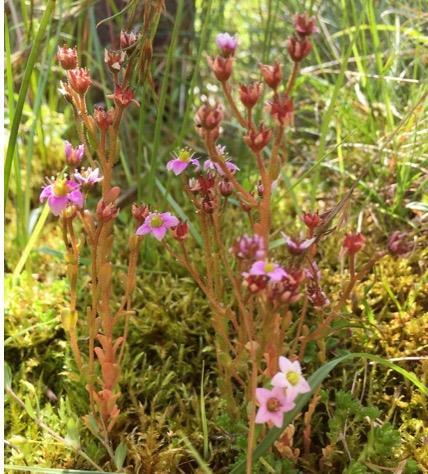
79
Pilosella caespitosa Yellow fox-and-cubs , Broadford, Skye – see page 32
Tree Lungwort


Berriedale © John Crossley
page 28
80
Ribes spicatum Kingsborough,Skye, fruit. 24.6.22 page 37
One of the entries in the Photographic Competition 2022
(NB The winners were all English – Scotland: must do better!)
Saxifrage
Page 15
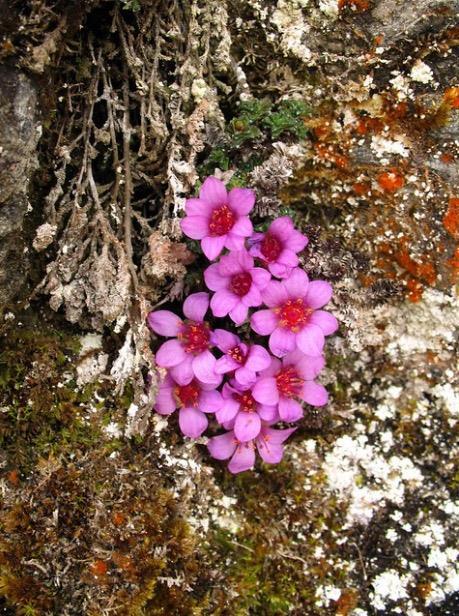
81
Purple
Saxifraga oppositifolia © Bert Barnett
BASIC BOTANY


Keys unlocked
Do you suffer from kleidophobia? Put it this way: if you were told to consult a key from scratch in Stace, Hubbard or Francis Rose, would you rather clean the kitchen floor with a toothbrush?
This is kleidophobia – fear of keys. It is a very common complaint among novices in all the biological disciplines. When you look at keys like those below, it is no wonder many people (and not only novices) take fright. This is an example of a dichotomous key. One of the reasons they look so frightening is that they have to be exhaustive, i.e. they have to cover every possibility, every plant that might come up. So they need to allow for all kinds of weird and wonderful features that someone might be interested in, such as a plant without petals, or one growing completely underwater, or one with male and female flowers on separate plants and so on. They also have to use very exact terminology – which means you seem to spend a lot of your time buried in the glossary.
Another kind of key is the multi-access key Here you are presented with a list of features such as (in a grasses key) ligule pointed, leaves hairy, inflorescence a spike, awns present and so on. You list all the features your plant possesses and then find the nearest match in a table. I don't know many people who find these awfully helpful in books. However, online where you just tick boxes and a programme does the work for you, it is much easier. Keys developed by Lucid lucidcentral.org are excellent here, but they are mostly concerned with plants and bugs that are economically or ecologically undesirable. The BSBI's botanicalkeys.co.uk works on a similar principle.
However, the dreaded dichotomous keys can also be used by novices once you understand how they work. The idea is that you choose between two alternatives in a 'couplet': e.g hairy leaves vs. hairless leaves, or notched petals vs. unnotched petals. The alternative you choose will lead you to another couplet and so on.

82
A word of warning: 'dichotomous' is supposed to mean that you are offered a choice of two alternatives. Beware though: in Hubbard the two alternatives may be several pages apart, and in Rose there are sometimes three or more options
Here's a simple example where only three species are at issue (so not exhaustive). The task is to distinguish between three red poppies. the only character used is the seedpod This is sufficient to distinguish between these three, though of course, it wouldn't do if more species were involved
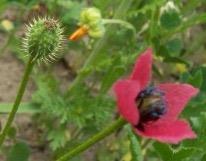

1a Seedpod smooth . . . . . . . . . (go to) 2
b Seedpod bristly . . . . . . . .. . . . . .
2a Seedpod round . . . . . .. . .. .
b Seedpod long and thin . . . .
Rough poppy Papaver hybridum
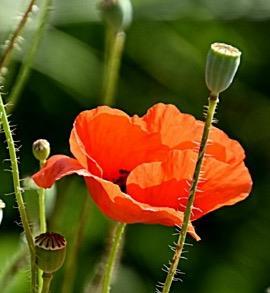
Common poppy Papaver rhoeas
Longheaded poppy Papaver dubium
If you can follow this, you have grasped the idea of keys, so it's now only a matter of practice. You are cured of kleidophobia!
Some tips
1. Make sure you have studied your plant carefully before you begin. Even write down a list of the salient features such as number of petals, shape and arrangement of leaves and so on, so that you can run through the questions smoothly. For Stace, you will see that when you get to the majority of ordinary flowers (known as 'herbs') you will need to know whether petals are fused or free, ovaries superior or inferior and so on, so if you find these distinctions tricky, work on that before you start on the key.
2. If you know roughly what sort of plant you have, you may decide to ignore the general key and go straight to the key for a particular family or group. The more ID practice you get, the easier it will be to do this.
3. Whatever level of key you are looking at, scan the whole thing first and see if you can suss out the master plan. In Hubbard, for example, Couplets 2 to 35 are all about grasses
83
with spike inflorescences; those with panicles don't begin until couplet 36. In Rose, key A is about aquatics, B is about composites, C is mostly graminoids and some trees and so on. This will save ploughing through sections that aren't relevant to your enquiry.
4. If you still feel intimidated by the keys in these 'bibles' of botany, go back a stage and look at some beginners guides to ID first, where you may get help in finding families, understanding more complex concepts, or knowing which features are important for ID and which you can safely ignore. Good luck!
Beginning to botanise in Scotland
It's the Botanical Society of Britain & Ireland we belong to, and when you start to botanise in Scotland, you can't escape the fact that your ID books and field guides –Stace, Rose, Poland, Collins or whatever – cover the whole of the British Isles. You may be lucky enough to have a county Flora for a particular area, but how can you get an overall view of where the flora of Scotland fits into the flora of Britain as a whole? Interestingly, the last time this question seems to have been posed in a general way was in 1924, in a paper in the Annals of Botany which is not available for online reading. So the present article is definitely up for comments by Scottish botanists.
What's different about botanising in Scotland, then? In the first place, although there are around 2,600 native and well-established alien vascular plants in Britain as a whole, there are only about 1,600 in Scotland. We are further from the original source of many of our plants in continental Europe (excluding Scandinavia), so although some species are more abundant in Scotland than in southern parts, the reverse is more common. The factors that create these differences include
o latitude – the north is colder, of course, but also the fact is that much of southern Britain escaped the last Ice Age, so its plants didn't get wiped out and have to start again from scratch
o temperature – again the north is colder, so the growing season shorter
o altitude – average height above sea level in England is 54m, in Scotland 87m
o soil types – there are more base-rich areas in England, which tends to mean more species-rich on the whole
o less pollution and general disturbance
o urban and agricultural pressures – urban areas account for 10.6% of England, against 1.9% of Scotland; with arable, it's 45% versus 10%.
84
Plants are not well-versed in political boundaries, however, so the Borders on one side of the border aren't phytologically cut off from Northumberland on the other side. Environmental factors give urban areas distinctive floras that make that of Edinburgh more like that of Newcastle, than like that of the Pentlands, say. The same is true to a large extent of arable weeds.
Some groups are more affected by the factors cited than others, e.g. grasses commonest in England are also on the whole commonest in Scotland too, whereas sedges differ more from south to north. Carex microglochin Bristle Sedge and C.saxatilis Russet Sedge (©Paul Slichter) are only found in Scotland, whereas C.ericetorum Heath Sedge and C.humilis Dwarf Sedge are not found in Scotland at all. Why? I leave it to better botanists than me to explain. Some types of vegetation such as machair, peat bog or temperate rainforest are restricted to a type of habitat that is found more readily in Scotland.

How does this make a difference to botanising? Well, for a start it cuts down the number of possibilities when trying to ID an unknown species. For example, while there are about 14 Rosa species in Britain as a whole, in Scotland only 8 of them are found. So, to save wasting a lot of time wondering whether your plant found in Perthshire is Ploughman's Spikenard Inula conyzae, for example, check the field guide, app, or the Distribution Database database.bsbi.org/maps to discover the extreme unlikeliness of this event. If you really think you have found a Jersey Lily Amaryllis belladonna on Skye, the only thing to do is to take a lot of photos (not the plant or bits of it) and send them to someone who should know – the local vice-county recorder or the species referee as appropriate.
On the plus side, Scotland boasts some habitats that are rare to non-existent further south. Thus certain assemblages of species can be studied more readily here, especially montane species. The position of Scotland on the extreme northwestern edge of Europe, with its oceanic climate, gives rise to unique assemblages in places like Skye. Alpine Gentian Gentiana nivalis (©Bert Barnett) and Alpine Milk-vetch Astragalus

85
alpinus,for example, aren't found in Britain away from Scottish mountains., of which Ben Lawers is often felt to be the botanical star. In Orkney and on the far north mainland coast, the Scottish Primrose Primula scotica is one of very few plants endemic to Scotland. Sheer lack of disturbance (and perhaps pollution) in montane habitats must account for the presence of some species no longer commonly found in England.


A number of species are at the northern extreme of their range here. On the other hand, we are rather short of limestone pavements and grasslands. Limestone Woundwort – in spite of its scientific name Stachys alpina – is known only from a few not-verymountainous places in England. With some species, the deciding factor seems, rather mysteriously, to be factors associated with latitude alone. Distribution of the Southern Downy Rose Rosa tomentosa and Northern Downy Rose Rosa mollis barely overlaps. The distribution of Dactylorhiza praetermissa Southern Marsh Orchid and D.purpurella Northern Marsh Orchid so far only overlaps in a small area of Northern England and North Wales – but the former is gradually moving farther north, clearly in response to climate change.



So what about climate change? Indeed, plant distribution is one of the clearest indicators we have of the alterations that are taking place from this cause. The Bee Orchid, for example, Ophrys apifera was not found in Scotland until this millenium but now is increasingly being recorded ever farther north. An alien from Peru, Shaggy Soldier Galinsoga quadriradiata used to be a denizen of urban areas only in the south, but is now being occasionally recorded even in Aberdeen and Inverness. Snow pearlwort Sagina nivalis (©Sarah Watts), in contrast , is one of the montane species being squeezed skywards until it threatens to run out of room (see page 21). It may be that English and Scottish flora will in fact become more alike as the climate changes, so watch this space.
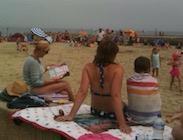
86
<–
Mine –>
Other people's
HOLIDAY SNAPS
There are four items in the Appendix
1. Expanded details for the BSBI programme of field meetings and events 2023
2. Details for the 2023 meetings of the Botanical Society of Scotland (BSS)
3. Details for the 2023 meetings of the Scottish branch of the British Pteridological Society (SBPS)
4. A short survey about this issue of the Scottish newsletter – it would be very helpful for planning future issues if you could fill this in.
Thursday 25 May (General, Recording)
Tain (v.c.106)
Leaders: Brian Ballinger and Mary Dean
This all-day meeting will be held jointly between the Botanical Society of Britain and Ireland (BSBI), the Botanical Society of Scotland (BSS) and the Inverness Botany Group. We will aim to start at 10.30 am and finish around mid-afternoon.
The day will be devoted to recording for the BSS Urban Flora Project and also to general BSBI recording.
We will walk on mainly level footpaths, quiet roads and parkland and should only cover about two miles. Some of the walk will be by the shore with good views and we will also visit a cemetery and other habitats.
If the tide is as predicted, we may see both Zostera (Eelgrass) species. Ligusticum scoticum (Scots Lovage) is by the sea wall and Crassula tillaea (Mossy Stonecrop) is often on the gravelly paths. Dactylorhiza purpurella (Northern Marsh Orchid) may be in flower and Saxifraga granulata (Meadow Saxifrage) is known from here. We will also look out for other coastal species. Further information and bookings from Brian Ballinger brian@garrickwood.org.uk
Saturday 3 June (Training, Beginners)
Glen Fender (v.c.89)
Leader: Faith Anstey
This meeting is aimed particularly at beginners/improvers. However, it will be of general interest also as Glen Fender is a place much appreciated by botanists for its calcareous grassland slopes that support a number of notable species. Beginners will be helped to identify the commonest species using the Pocket Guide to Wildflower Families – and hopefully some of the more unusual ones too. The terrain is not especially taxing, but strong footwear is a must. Booking is essential. Contact: Faith Anstey faithanstey@gmail.com
Sunday 18 June (Training, Beginners)
Plant Families Workshop, Edinburgh (v.c.83)
Leader: Aileen Meek
The Plant Families workshops are suitable for anyone who can tell a buttercup from a daisy but wants to learn more about plant identification within a structured framework. There will be a mix of classwork, small groups with expert tutors, and fieldwork, following the principle of 'finding the family first'. This is a tried and tested way of getting to grips with ID instead of just playing 'snap' with a field guide. or wading through incomprehensible keys. A copy of the booklet on which the course is based
Pocket Guide to Wildflower Families by Faith Anstey – will be included in the
APPENDIX
–
charge for the workshop: £40 (50% discount for BSBI members and full-time students). Places are limited, booking essential. Contact: Aileen Meek aileenammeek@gmail.com
Saturday 24 June (General)
John Muir Country Park, West Barns, Dunbar (v.c.82)
Leaders: Marion Moir and Caspian Richards
The meeting will visit the coastal flora in the dunes, as well as the salt marshes with sedges. We shall also look at the special grasses that grow in the area. These include Festuca arenaria (Rush-leaved Fescue), Parapholis strigosa (Hard Grass), Brachypodium pinnatum (Drooping Tor-grass) and Corynephorus canescens (Grey Hair-grass).
Meet at Linkfield Car Park NT651786 at 10.00am with packed lunch and equipped for a day in the field. Parking charge is £2.50. Follow signs off the A1087 Dunbar. Contact: Marion Moir (marion.moir@btinternet.com) for bookings and further details.
Saturday 1 July (Training, Beginners)
Plant Families Workshop, Dulnain Bridge (v.c.95)
Leader: Aileen Meek
The Plant Families workshops are suitable for anyone who can tell a buttercup from a daisy but wants to learn more about plant identification within a structured framework. There will be a mix of classwork, small groups with expert tutors, and fieldwork, following the principle of 'finding the family first'. This is a tried and tested way of getting to grips with ID instead of just playing 'snap' with a field guide. or wading through incomprehensible keys. A copy of the booklet on which the course is based – Pocket Guide to Wildflower Families by Faith Anstey – will be included in the charge for the workshop: £40 (50% discount for BSBI members and full-time students). Places are limited, booking essential. Contact: Aileen Meek aileenammeek@gmail.com
Saturday 1 July (Training, Specialist)
Introduction to Bramble Identification, Maybole (v.c.75)
Leader: Angus Hannah
Brambles form an important element of our flora which many botanists are reluctant to investigate in detail. This meeting offers an introduction to bramble identification for anybody who has yet to embark on a personal exploration of, or feels in need of basic revision about, this fascinating group of plants. In the indoor morning session we will work through the characters needed to identify a specimen and in the afternoon try out our new skills on some local bushes.
Booking is essential. Contact: Angus Hannah butesedge@yahoo.co.uk
Saturday 8 to Sunday 9 July (Specialist, Recording)
Bramble Recording Weekend, Maybole (v.c.75)
Leader: Angus Hannah
Following on from the training day on Saturday 1st July, this meeting is for people with some knowledge of bramble identification who are willing to assist to record brambles in the area, which historically has not been well covered. The meeting will probably begin informally on the Friday (7th) and can be extended into Monday if anyone is keen to do so. Additional specimens from around the Clyde area will be available for inspection/identification.
Booking is essential and numbers strictly limited. Contact: Angus Hannah butesedge@yahoo.co.uk. Participants will be required to organise their own accommodation, early booking is advised.
Saturday 15 to Sunday 16 July (Recording, Amber)
Northern Fannichs, NH17/NH27 (v.c.105)
Leader: Duncan Donald
The plants in this area remain surprisingly poorly recorded, despite it having been visited by a steady stream of botanists since Druce’s first reports from Beinn Liath Bheag and Sgurr Mor c. 1902. An issue in the past has been poor understanding of the boundary with v.c.106, so great care will be taken on this visit to record using accurate grid references. Targets for re-finds include Alchemilla glomerulans (Clustered Lady's-mantle), Athyrium distentifolium (Alpine Lady-fern), Carex atrata (Black Alpine-sedge), C. vaginata (Sheathed Sedge), Cerastium cerastoides (Starwort Mouse-ear), Deschampsia cespitosa subsp. alpina (Alpine Hair-grass), Juncus castaneus (Chestnut Rush) and Salix lapponum (Downy Willow); help from a Hieracium expert would be particularly welcome, since Archie Kenneth and others noted an impressive number of taxa in 1960-1990. Attendees need to be fit enough to walk up mountains. Booking is essential: if interested in attending or for further details contact Duncan Donald drd16C@gmail.com. Attendees will be responsible for their own accommodation, options including camping or indoors at Aultguish Inn, Inchbae Hotel or, further afield, in Ullapool: early booking advisable.
Saturday 22 July 2022 (Training)
Grasses, Sedges and Rushes, joint with NTS, Ben Lawers (v.c.88)
Leaders: Dan Watson and Faith Anstey
This meeting will provide field training in the identification of grasses, sedges and rushes and repeats the training event held previously at Ben Lawers. Although initially designed to consolidate the skills of attendees on BSBI Scotland workshops, past experience has shown that previous attendance at relevant workshops is not a prerequisite. Copies of the booklets Start to Identify Grasses and Start to Identify Sedges & Rushes are recommended and will be available for purchase on the day.
The meeting is open to all members of BSBI, NTS and anyone else interested, whatever level they are at. After some revision on what to look for, we will split into those who want to go on up the hill (perhaps those with more experience of grasses etc) and those preferring to stay on lower ground (and/or perhaps needing more ID guidance). Places are limited, booking essential. Contact: Faith Anstey faithanstey@gmail.com
Sunday 23 July (Beginners)
Mugdock Country Park (v.c.86)
Leader: Matt Harding
This meeting will explore the varied flora of Mugdock Country Park and its surroundings, with an emphasis on learning, and we would particularly welcome anyone who has not been on a BSBI field meeting before. With a wide range of habitats present, including woodland, grassland, heathland, marshes and lochs, there should be many interesting plants to encounter, hopefully including species such as Platanthera chlorantha (Greater Butterfly-orchid) and Nuphar pumila (Least Water-lily). The Park has a good footpath network and excellent facilities, including cafes, toilets and even a garden centre for the horticulturally inclined. The Park is also accessible by public transport from Glasgow Queen Street (train then bus). Places are limited, so booking is essential. Contact: Matt Harding matt.harding@bsbi.org
Saturday 29 July (Training)
Grasses Workshop, Birnam (v.c.88)
Leader: Martin Robinson
This workshop aims to introduce identification of common grasses to beginners and improvers who already have a basic grasp of plant ID. There will be a mix of classroom study and fieldwork, much of it in small groups with expert tutors. The programme will be based on Start to Identify Grasses by Faith Anstey, a copy of which will be included in the cost of the workshop: £40 (50% discount for BSBI members and full-time students). Places are limited, booking essential. Contact: Faith Anstey faithanstey@gmail.com
Saturday 5 to Friday 11 August (Recording)
Barra Islands, Outer Hebrides (v.c.110)
Leader: Paul Smith
The meeting will be based on the MV Cuma, a converted fisheries vessel (see www.islandcruising.com) with pickup and setdown at Lochmaddy, North Uist (to travel with the boat towards Barra). We will visit a range of islands and islets around Barra, including some of the islands to the south which have a variety of habitats including machair and moorland. The larger islands have reasonable lists, but have not been recorded in tetrads or monads, and this meeting will provide detailed records for a new flora. Several smaller islands are completely unrecorded. The terrain is generally rough, but there should be a variety of easier and more strenuous options each day. The cost is £1100 per person full board, sleeping on the boat, which takes 12 people, so please book early, preferably by the end of February.
For further details and to book, contact Paul Smith, pas.vc110@gmail.com or 8 Locks Road, Locks Heath, Southampton, SO31 6NT.
Sunday 20 August 2022 (Training)
Plant Identification for Habitat Surveys, Dumyat (v.c.87)
Leader: Lindsay Mackinlay
This meeting aims to introduce participants to the main indicator species which assist in habitat classifications, touching on several Phase 1 habitats and NVC plant communities. The workshop is not suitable for complete beginners but is more aimed at those who have some basic or intermediate plant identification skills who are also interested in understanding the relationships between plant species and the habitats in which they grow. (Please note that this is not a training course on Phase 1 habitat or NVC surveys but rather a workshop to assist participants in identifying key plant species in different habitats).
The meeting is open to all members of BSBI and BSS or anyone else who may have an interest (Priority will be given to BSBI and BSS members in the first instance). It is likely that the workshop will involve some rough walking over the open hill in places. Come prepared for a day in the hills! Places are limited, booking essential. Contact: Lindsay Mackinlay at lindsay@thefutureforestcompany.com
Saturday 2nd September (Training)
Ferns for Beginners Workshop, New Lanark (v.c.77)
Leader: Michael Philip
This workshop aims to introduce the identification of some common ferns and is for "complete and utter beginners" in fern identification. Ferns are often thought of as difficult, so participants will gain some foundational knowledge which may then be confidently built upon through outings, field meetings and workshops elsewhere. Introductory work in the classroom with experienced tutors will be followed by fieldwork in the spectacular surroundings of the Scottish Wildlife Trust's Falls of Clyde Reserve. The programme will be tailored carefully, assuming no previous knowledge. All course materials will be provided and included in the cost of the workshop: £40 (50% discount for BSBI members and full-time students). Places are limited, booking essential. Contact Michael Philip botany@opus44.co.uk
BOTANICAL SOCIETY OF SCOTLAND FIELD MEETINGS SPRING TO AUTUMN 2023

The meetings listed below are the scheduled field meeting of the Society. We may also arrange extra meetings throughout the summer months. Check our website https://www.botanical-society-scotland.org.uk/ for any additional events. Please note that some of our scheduled meetings must be pre-booked For all meetings, except for those for which a specific contact is mentioned, the primary point of contact is the Programme Secretary, Maria.Chamberlain@ed.ac.uk
SUNDAY 30 APRIL 2023, 10am
FORAGING WALK AND TASTER PICNIC CRAIGMILLAR PARK, EDINBURGH
Leader: Nenya Milne
We will go on a foraging walk and then enjoy a pre-prepared taster picnic (with soup, bread, pie, and salad) and hand out recipes. Children welcome. Please wear weatherproof clothes and sturdy footwear and bring some bags for collecting foraged plants and gardening or rubber gloves for nettle picking. Please also bring your own picnic stuff - cup, bowl, plate & cutlery + rugs if you need them. Meet by Bridgend Farmhouse at 10am. Donations of about £1-3 per person for additional ingredients will be appreciated. The Bridgend Café will be open for food and shelter. Contact Maria.Chamberlain@ed.ac.uk to register (so that we know how many recipe sheets to print) and for further information.
SUNDAY 14th MAY 2023, 11am start
DUNDEE BOTANIC
GARDEN AND ENVIRONS
Leaders: Kevin Frediani and Leslie Tucker
Kevin Frediani (Curator) will start with a summary of the garden’s history, its iconic plants and associations and outline the work carried out at the Garden. The Paterson centre classroom will serve as a base during the visit; tea and coffee will be provided for those who have travelled. Les will point out some inadvertently introduced weed species. We will be met and will not have to buy entry tickets, but I suggest that participants should offer a donation towards the Garden’s native species conservation work. Please bring a packed lunch.
Visitors seeking further botanical interest locally in the afternoon could consider strolling around the nearby Riverside Nature Park, where wilder attractions include a collection of native willow species and hybrids whose identifying characteristics could be demonstrated. Dundee’s other attractions, like the V&A, are well worth a visit, too.
THURSDAY 25th MAY, 10.30 (all day)
TAIN
JOINT BSBI/ BSS/INVERNESS BOTANY GROUP
Leaders: Brain Ballinger and Mary Dean
The day will be devoted to recording for the BSS Urban Flora Project, and also to general BSBI recording. We will walk mostly on level footpaths, quiet roads and parkland and should only cover about two miles. Some of the walk will be by the shore with good views and we will also visit a cemetery and other habitats. If the tide is suitable, we may see both Zostera
(Eelgrass) species. Ligusticum scoticum (Scots lovage) is by the sea wall and Crassula tillaea (Mossy Stonecrop) is often on the gravelly paths. Dactylorhiza purpurella (Northern Marsh Orchid) may be in flower and Saxifraga granulata ( Meadow Saxifrage) is known from here. We will also look out for other coastal species. Further information and bookings from Brian Ballinger brian@garrickwood.org.uk.
THURSDAY 1st JUNE 2023, 7pm – 9pm
EVENING CRASH COURSE in FLOWERING PLANT ID (not grasses)
EDINBURGH
Leader: Richard Milne
The crash course is intended for novice plant enthusiasts. Venue: the Ashworth Laboratory, Kings Buildings (https://www.ed.ac.uk/maps/maps). Please book with Maria.Chamberlain@ed.ac.uk Please bring Keble Martin, Collins or Rose (if you have them) and £3 towards the cost of printing handouts.
SUNDAY 4th JUNE 2023, 10am (all day)
MILLERHILL
Leader: Richard Milne
Following on from the crash ID course, this is a whole day of plant ID to consolidate what you have learned. The meeting is open to all, not only the ID course participants. Children are welcome. There will be some special plant-finder cards for children. Please let the leaderR.Milne@ed.ac.uk know if you are bringing children so we know how many sheets to print. Meet Shawfair Station
TUESDAY 6th JUNE 2023, 7pm
SEABRAES DUNDEE
JOINT DUNDEE NATURALISTS’ SOCIETY/BSS
Leader: Brian Ballinger
This joint evening meeting will be devoted to recording for the BSS Urban Flora Project and also to making general wildlife observations. A short walk on mainly level ground. Some of the area is a brownfield site, part of which is being developed for the Eden Project. Meet at the Science Centre car park NO410298. Further information from Brian Ballinger brian@garrickwood.org.uk or the Dundee Naturalists’ website.
TUESDAY 13th JUNE 2023, 7pm
BATHGATE AND ARMADALE 1
Leader: John Grace
Evening walk including derelict ground, woodland and the Bogburn flood lagoons. Collect woodland/wetland/riparian data for the Urban Flora Project. Meet at Morrison’s Supermarket, 2 Linkston Way, Bathgate EH48 2SS.
TUESDAY 4th JULY 2023, 7pm
BIRKHILL by DUNDEE
JOINT WITH DUNDEE NATURALISTS’ SOCIETY
This joint meeting is devoted to botanical recording, partly for the BSS Urban Flora Project, and also for making general wildlife observations. Mainly on good level paths. Meet at Templeton Woods car park, NO359342. Further information from Brian Ballinger, brian@garrickwood.org.uk or the Dundee Naturalists’ website.
WEDNESDAY 5th JULY 2023, 7pm
BATHGATE AND ARMADALE 2 Leader: John Grace
Visit derelict land at Lower Bathville. Collect data for the Urban Flora Project from derelict sites for the Urban Flora. Meet at Tesco Supermarket: Blackburn Road, EH48 2ES.
SUNDAY 16th JULY 10.30am (all day)
HOLYROOD PARK Leader: Sue Jury
We will explore Holyrood Park and Arthur’s Seat. Although this is one of Edinburgh’s most iconic sites, it has not been explored by the Urban Flora team in recent years. Some of the walk will of course be uphill and rocky. The aim is to record plants (including bryophytes) and to check on some rarities. Beginners welcome. Meet at Commonwealth Pool. Register with Maria.Chamberlain@ed.ac.uk.
SATURDAY 22 JULY 2023, 10 am (all day)
BIGGAR
JOINT MEETING WITH BSBI and NORTH LANARKSHIRE BOTANISTS
Leaders: Michael Philip and John Grace
Meet in carpark in Biggar Burnbraes Park, Biggar Mill Road, ML12 6LY Grid ref: NT0395 3803. Further information from Michael Philip, botany@opus44.co.uk
THURSDAY 3rd AUGUST 2023, 7pm
LIVINGSTON Leader: John Grace
Explore forested paths, public parks and open spaces as well as suburban streets. Collect ‘New Town’ data for the Urban Flora Project. Meet at Tesco Supermarket: 242 Main Street, EH53 0EJ.
SATURDAY 2 SEPTEMBER 2023, 11am
HOPETOUN GARDENS and GROUNDS, SOUTH QUEENSFERRY
JOINT WITH the EDINBURGH and LOTHIANS FUNGUS ENTHUSIASTS (ELFEs) Leader: Cameron Diekonigin
Pleasebookwithteam.elfe@gmail.com.Meetinginstructionswillbegivenoutonbooking.
SATURDAY 24 JUNE 11am
VISIT TO BAMFF ESTATE, ALYTH (PERTHSHIRE)
Leader: Paul Ramsay
Beavers,whichbecameextinctinScotlandinthe16th Century,weresuccessfullyintroducedtoBamffin 2002bytheEstateowners,PaulandLouiseRamsay.Sincethen,thebeaversandtheirfamilieshave choppedtrees,builtdamsandrestoredwetlands,providingahabitatformanyinterestingspeciesof animalsandplants.WewillexploretheimpactthattheanimalshavehadontheBamfflandscape, recordingtheplantsaswego. Wehopetosharecars(covidregulationspermitting),sopleaseregister yourinterestwithMaria.Chamberlain@ed.ac.uk.
Members and guests attend meetings at their own risk. We follow a strict code of conduct (See https://www.botanicalsociety-scotland.org.uk/content/code-conduct-field-excursions) Please check with the programme secretary whether the site is suitable for children or dogs. Risk Assessments for each successive field meeting available on the BSS website a week before the event.
Pleasebringapackedlunchandwatertodrinkforall-daymeetings.Warmwaterproofclothingand grippyfootweararealwaysneeded.
Scottish Group - Meetings Programme 2023
ALL WELCOME!
Saturday 29 April Spring Zoom meeting 6pm
Catch-up, discussion of the programme for the year, and some short illustrated talks, including:
“Fern Diseases” Janis Antonovics
“Moving Ferns at RBGE” Kate Miller
Leader: Bridget Laue
Contact Bridget for Zoom details
Saturday 27 May Killarney fern on Arran
A trip to the east coast of Arran. We are hoping to see Killarney fern (Vandenboschia speciosa), for those who were unable to join the excursion last summer. We will also visit a site south of Lamlash Bay
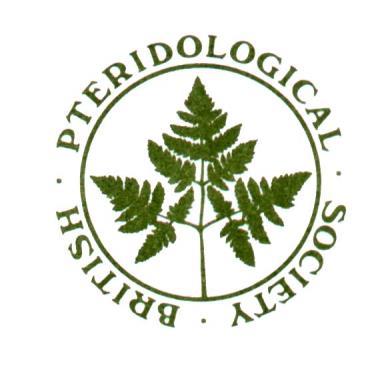
Saturday 1 July
to find Dryopteris cluthensis. Easy walking, no long distances or difficult terrain.
Meet at Ardrossan for the 9.45 am ferry, returning on the 4.40 pm ferry. The ferries are currently a little unreliable, so a last minute cancellation is a possibility. We need to minimise the number of cars on the ferry (expense) and because parking is limited at the Lamlash site, so be prepared to offer lifts/share cars for the day.
Ardrossan to Brodick ferry: 9:45 – 10:40
Brodick to Ardrossan ferry: 16:40 – 17:35
Leaders: Liza Downie and Michael Hutchinson
Woodsia alpina at Lochan na Lairige
Last year at this site, just to the west of Ben Lawyers, Roger found Woodsia alpina, as well as other interesting ferns including Polystichum lonchitis and Dryopteris kerryensis (the first record in Scotland). No long distances, and little climbing, but rough terrain.
Meet at the north of Lochan na Lairige (NN 595413)
Leader: Roger Golding
Saturday 29 July
Athyrium flexile at Glencoe
Athyrium flexile is a fern only known in Scotland. Heather’s research showed that it is a (very distinctive) variety of Athyrium
distentifolium, which has recently been renamed as Pseudathyrium alpestre. flexile only occurs at higher altitudes and usually requires strenuous exercise to see it. However, it occurs on Meall a Bhuiridh, close to the top of the Glencoe Mountain Resort ski-lift. Interesting Huperzia plants have been found close by.
Meet at the foot of the Glencoe Mountain Resort ski-lift
Leader: Heather McHaffie
Saturday 26 August
Dollar Glen/Rumbling Bridge
Meet in Dollar, and walk up ferny Dollar Glen following the Burn of Sorrow to Castle Gloom (Castle Campbell). Time permitting, we might also visit the (also very ferny) River Devon gorge at Rumbling Bridge.
Leader: Bridget Laue
September TBA Ferns behind the scenes at RBGE
A complete renovation of the glasshouses at RBGE is happening over the next few years. This enormous undertaking has meant that all plants, including ferns, have had to be cleared out to temporary housing, and the glasshouses are closed to the public. We will be given a guided tour behind the scenes, to see RBGE’s many exotic ferns, and learn how they are being maintained. (This will be on a weekday evening, 16:00-18:00.)
Leader: Bridget Laue
Saturday 30 September
Annual Autumn Meeting, Edinburgh
Tour of Bridget’s garden, in Liberton. Fern-related presentations. Plant sales, book sales, and planning for 2024. Coffee/tea and lunch provided.
Leader: Bridget Laue
BSBI members are welcome to attend. All meetings will go ahead despite inclement weather, so please dress appropriately (usually waterproofs, and stout footwear). For day excursions please bring drinks and snacks/packed lunches. If you are interested in attending, please contact Bridget; she will provide more details about meeting places and times, and contact details for meeting leaders.
. Bridget Laue
e-mail: bridgetlaue@blueyonder.co.uk
Home: 0131-258-9592
Mobile: 0793-243-9989
For up to date information check the BPS website: www.ebps.org.uk/events/category/meetings/regional/scotland
WHAT DO BOTANISTS DO ALL DAY?
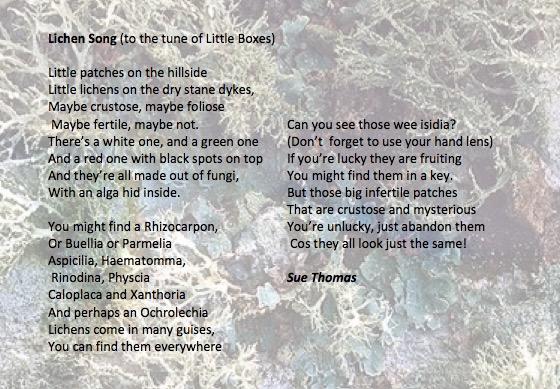



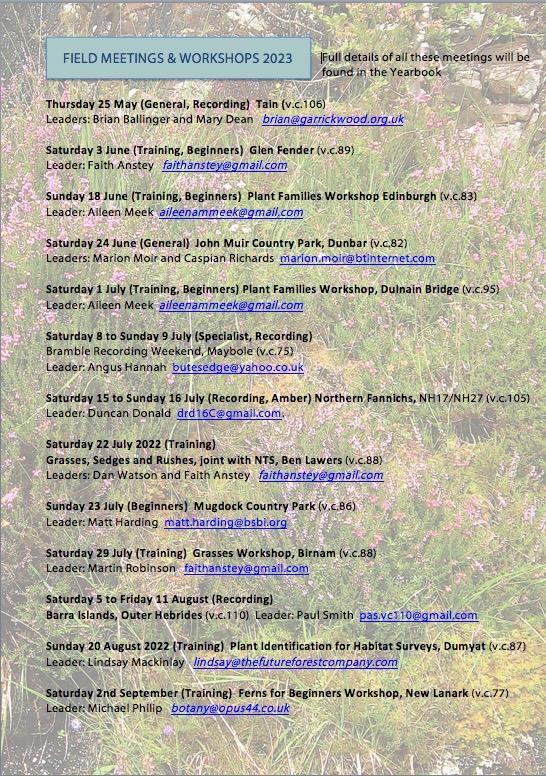






































































































 Faith Anstey
Faith Anstey










































